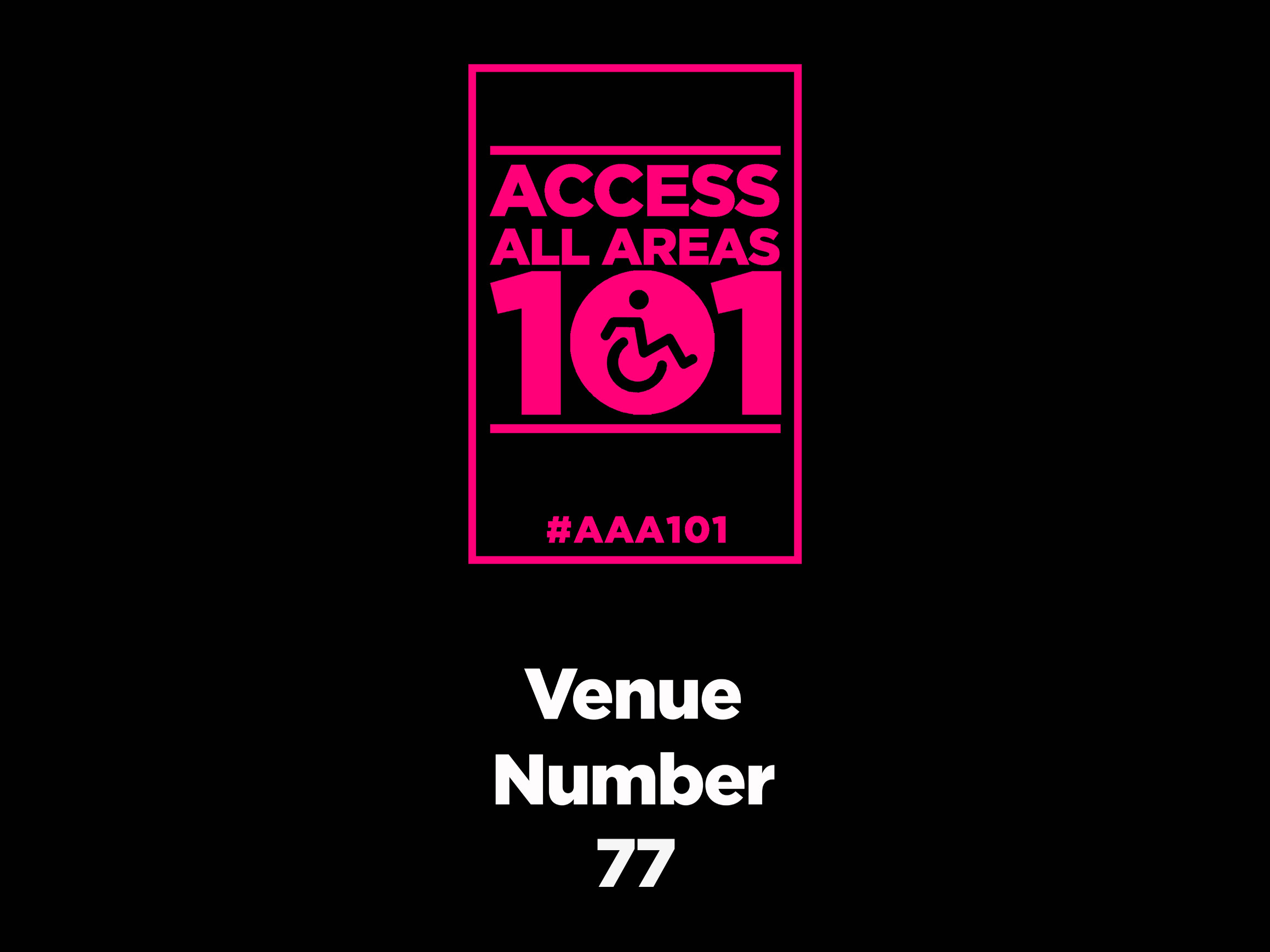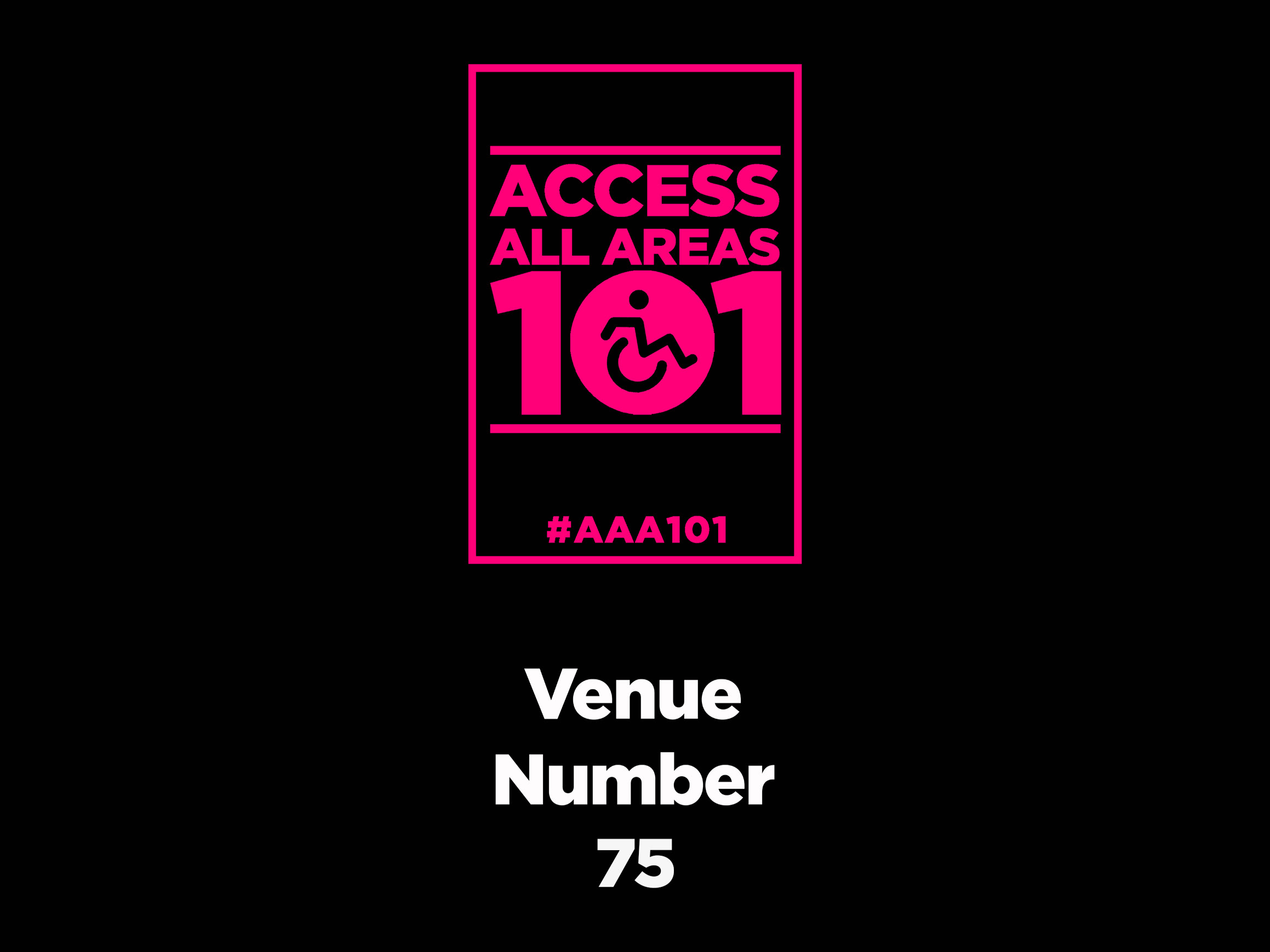PLEASE NOTE that some security processes, queues to get in, seating arrangements, and other such details will differ for regular theatre events.
The iconic home of snooker in the Steel City has a rich history, but can this landmark accommodate people with disabilities? Has this old lady moved with the times? Read on and find out!
BOOKING
Accessible booking for The Crucible can be made online on the Sheffield Theatres website, which is excellent for sharing access information. There are BSL and audio flyers, and some shows have signed, audio-described, dementia-friendly, and relaxed performances, which are all clearly marked. When you’ve selected your event, you are shown a clear seating plan to choose your seats.
To book accessible tickets online, you must call or email the Access Team at Sheffield Theatres. They will set you up with an online account that enables you to book the seating options you need and add your essential companion ticket free of charge. Once your account is set up and you log in online, you can see the available ticket options and make your booking.
There is a separate website for snooker, which the same company still runs. You can use your existing Sheffield Theatres account to buy tickets online. The process works the same.
First things first - picking your desired event. With snooker, some days have three different sessions, and the early rounds have two tables, so there are up to six options per day.
We wanted to go on Thursday, April 24th. There was no morning session, so we could choose from the afternoon or evening sessions at either table one or table two. We decided on the evening and clicked on the event on the calendar. As I had my account already set up and ready to use, the wheelchair spaces showed up on the seating plan.
On the plan, wheelchair spaces are shown as light blue, and up to three seats that can be booked simultaneously are shown as red stars. I could see spaces available in rows J and K, so I chose J22. When I clicked on the blue star, a ticket logo appeared over it to confirm that it was my selection. I then clicked the seat next to it, J21, and clicked continue.
On the next page, I got confirmation that J22 is a wheelchair space with no seat, and J21 is the companion seat for the wheelchair user in J21. This was very straightforward to understand and clearly stated that these are wheelchair tickets, not for ambulant disabled customers.
J22 is showing as £49.50, and J21 as £60.50. My account is set up for a free companion ticket, yet it’s showing here that I’m being charged full price for both. A note at the top of the screen says that special offers and membership discounts are applied to the basket once you are logged in. I’ll trust the process and click to continue.
As the next page loads, I see the discount has been applied. I’ve now got two tickets, one standard and one wheelchair, for £49.50, and it confirms that a discount has been applied under the ‘Companion and Wheelchair’ offer. I’m happy that everything looks correct, so I’ll click to proceed to the checkout.
The checkout has six checkboxes to complete.
First, the recipient’s surname and date of birth - simple enough.
Second is the contact preferences - just about World Snooker using my data. You can change this in your user profile.
Next is ticket delivery. As I’m booking online, having paper tickets printed to collect at the Box Office or posted to me is not an option. I can only have my tickets sent as e-tickets.
Now we move on to billing details. I don’t have a card saved on file, so I’ll select to add a new card, which I can save for future use. Below is my billing address, the default address on my account. I can edit or add an additional if I need to.
Now comes the summary page confirming my ticket choices, date and time, my tickets will be e-Tickets, and my billing address. The order total of £49.50 is at the bottom, and there is a box to tick to agree to the Ts and Cs. All looks good to me, so I’ll click ‘Continue’.
Step 6 is the payment page. There’s a box to add any gift vouchers you might have, and the usual boxes for card details. If you need to confirm any mobile banking payments, you’ll do it all now.
The next page that loads is the confirmation page. Full details of my order are displayed, and I can add my mobile phone number to update my account. And that’s it - booked. It’s simple, straightforward, and easy to do.
My e-ticket was emailed to me as a PDF attachment. I could download the tickets from my account if I couldn’t find the email. I was also sent a text on the event day with a link to my account page to retrieve the tickets and place pre-orders for refreshments. This web page also allowed me to add the tickets to my Google Wallet.
There are some step-free seating options for ambulant disabled customers, but I cannot give further details as I didn’t need to book these.
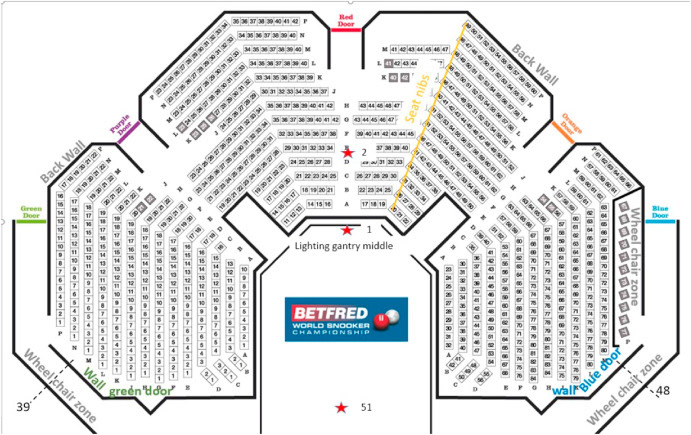
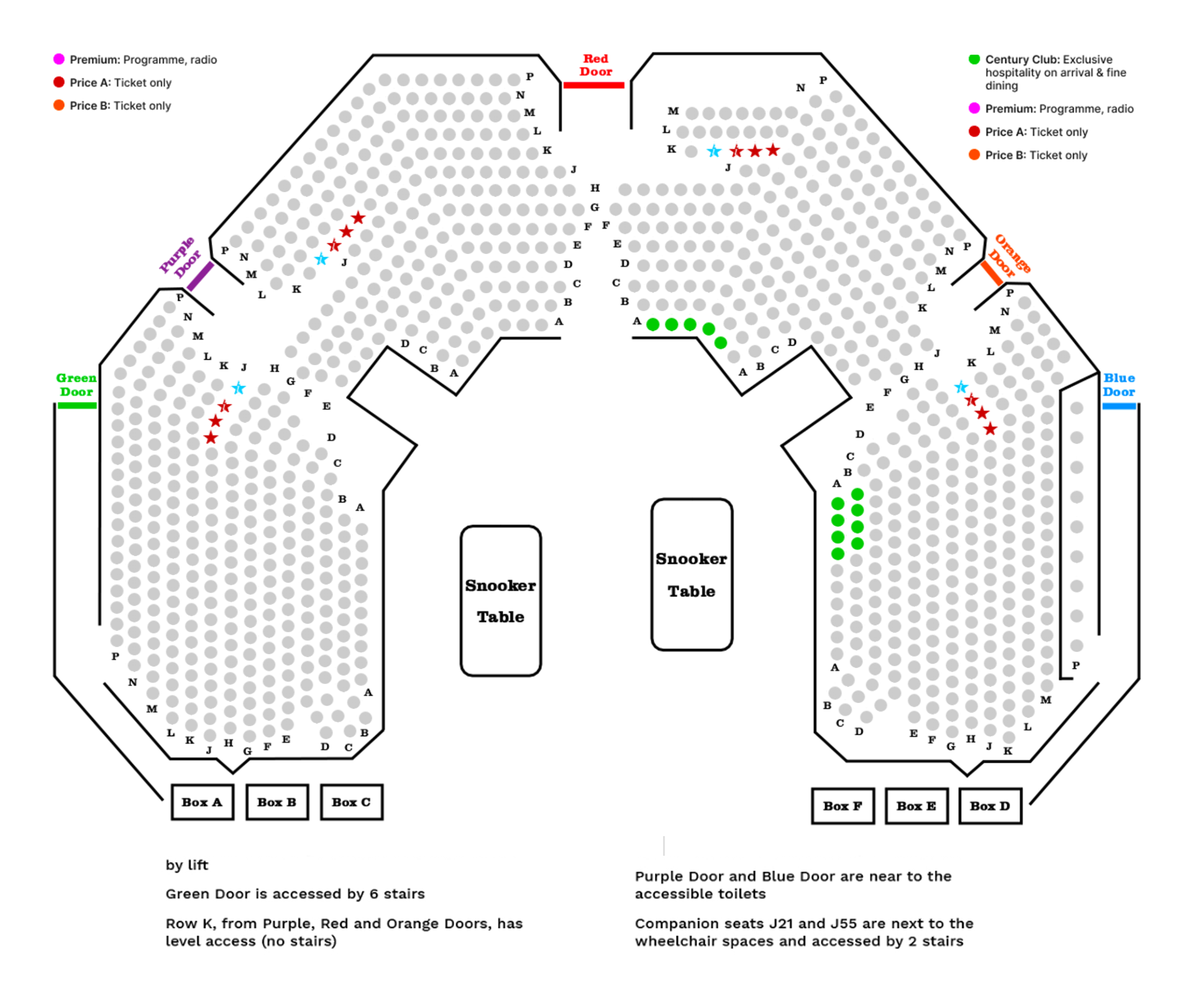
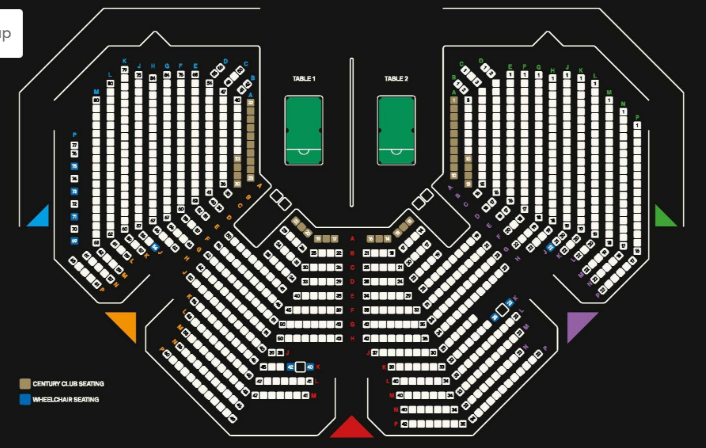
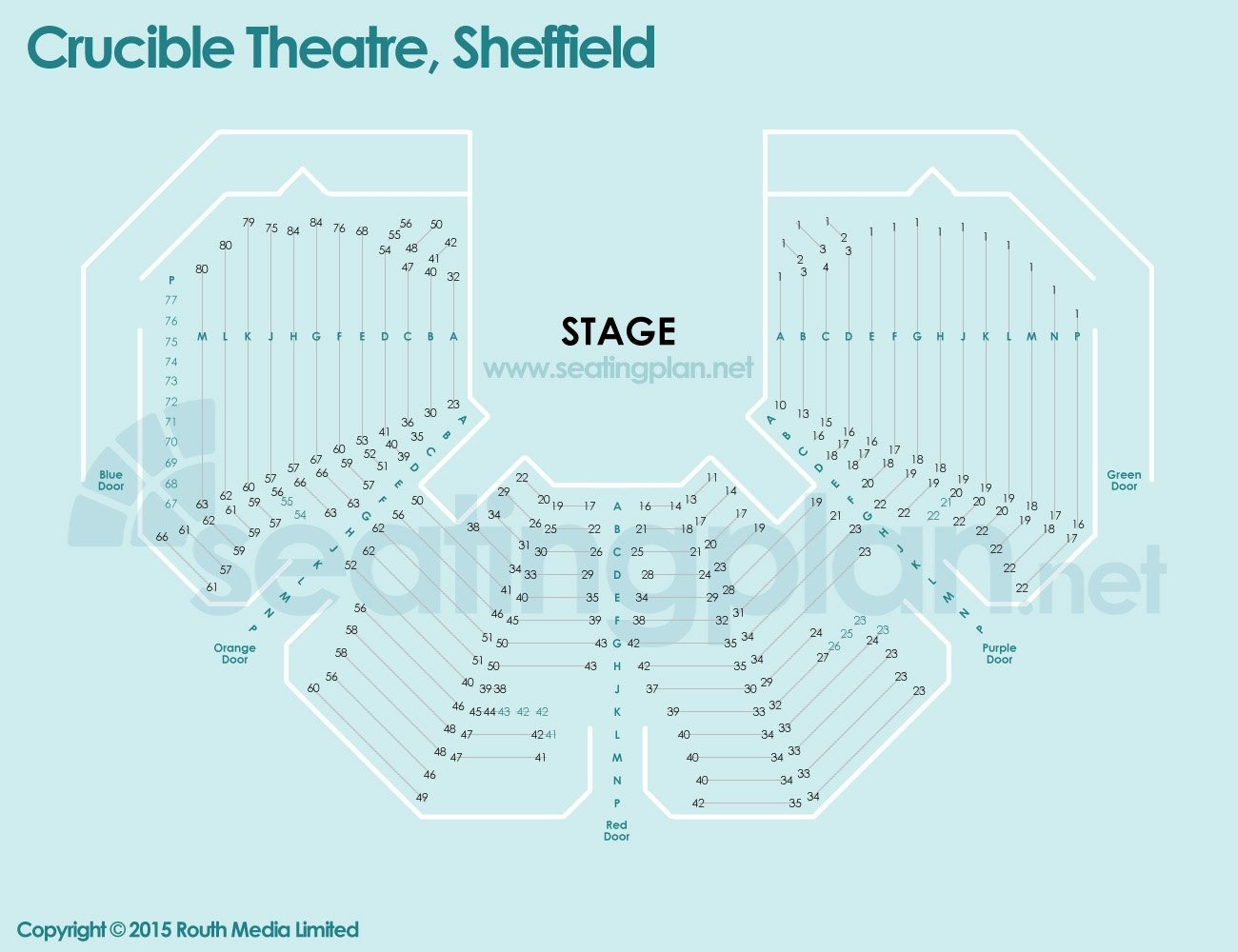
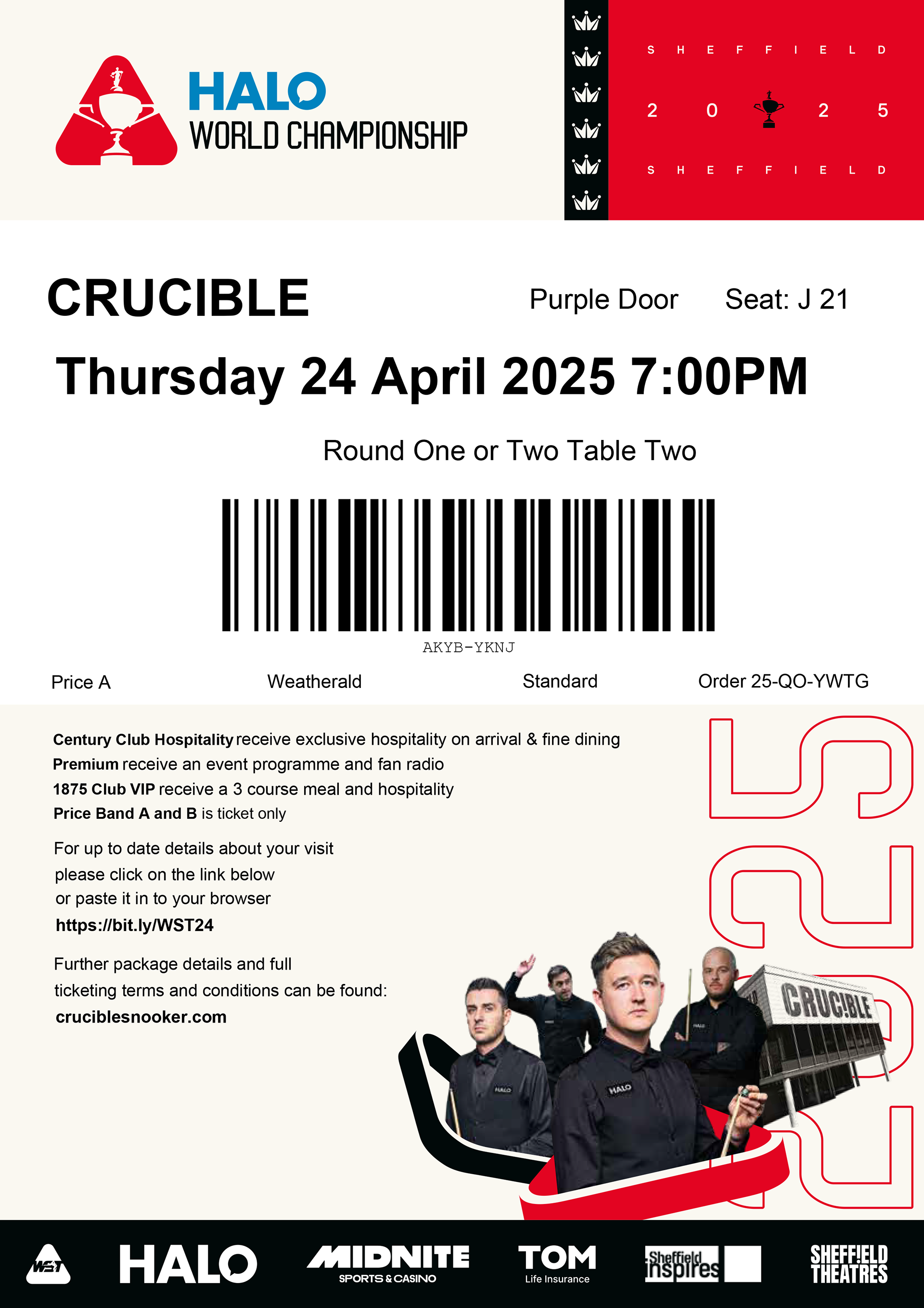
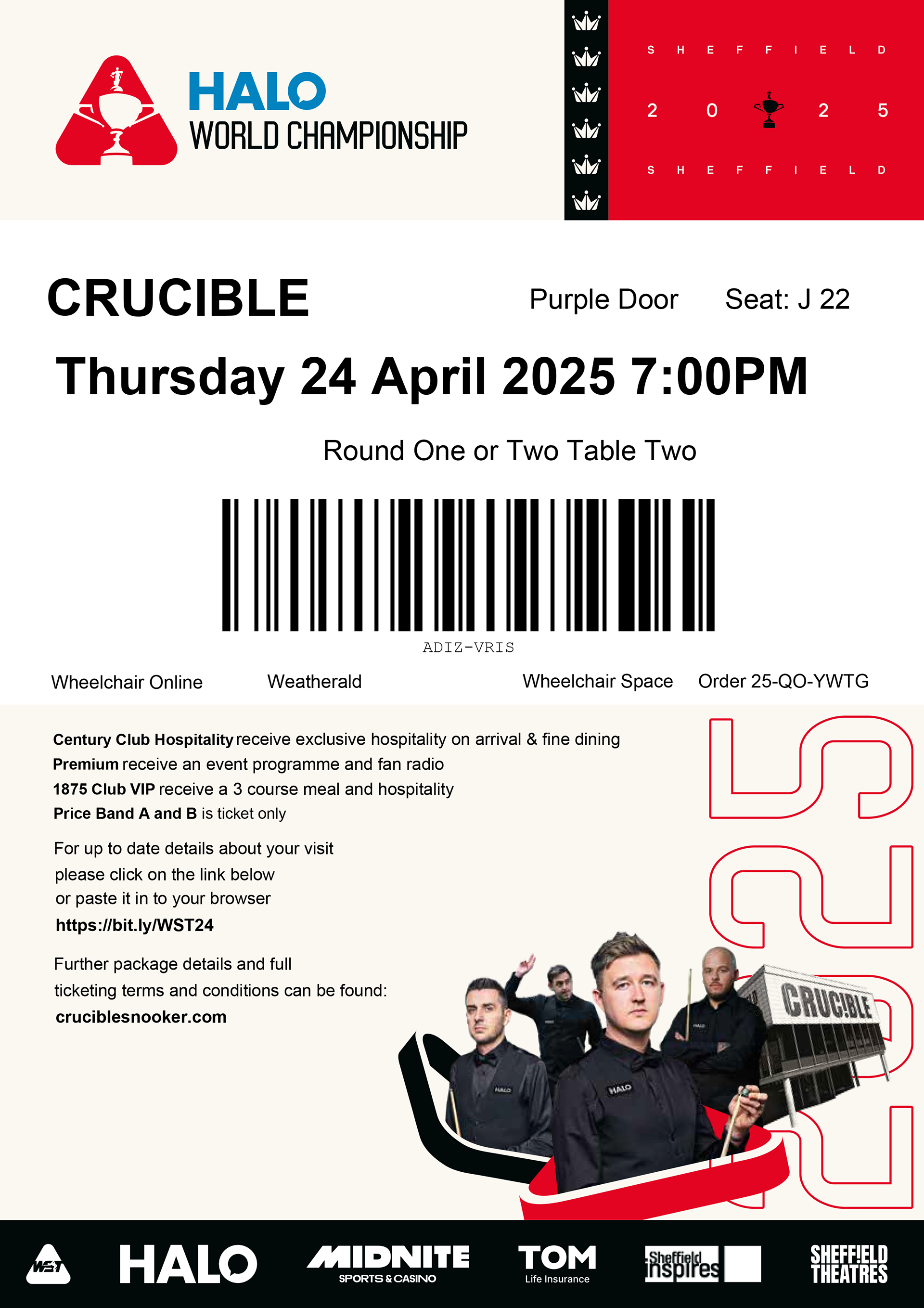
LOCATION AND GETTING THERE
The Crucible Theatre is in the city of Sheffield. Although Sheffield is a major city, it is far from the main road network and the M1.
The city’s railway station is less than 10 minutes’ walk or roll away, and the route is mostly flat. The station hosts trains from Cross Country, Northern, and East Midlands train services across Yorkshire and to London St Pancras, Plymouth, Liverpool, Manchester, East Anglia, and Edinburgh.
The theatre is also only 400m from the Cathedral SuperTram stop. All four coloured routes serve the Cathedral stop. The Supertram network connects 50 stops across Sheffield and Rotherham. It has multiple park-and-ride sites and services the University campuses, major sporting venues, bus exchanges, Sheffield Arena, Meadowhall shopping centre, and Ikea.
The SuperTram network is fully accessible. To use mobility scooters on the buses and trams in Sheffield, your scooter must meet several conditions and you must apply for a travel permit.
The Crucible recommends the Q-Park Charles Street, just a few minutes away, for car parking. The park has accessible bays and is entirely wheelchair accessible. Parking is chargeable, but discounts are available for Crucible ticketholders.
Other parking options exist within the city, including secure parks and on-street bays. If you are unfamiliar with the area, driving in the city might be confusing, as there are large pedestrianised areas and one-way streets.
Many hotel options in the city centre cater to all budgets. With a significant event like the snooker, hotel rooms are in demand, so you might find that prices fluctuate and accessible rooms are limited. With the SuperTram network, you have the additional option of staying further out of the city, which is often cheaper, but do make sure to check the times of the last trams. If the evening sessions of the snooker run over, you don’t want to risk getting stranded and paying for a taxi.
The theatre itself is next to the Sheffield Winter Garden and a short distance from the main shopping areas. For the snooker event, a temporary BBC TV studio and ‘Cue Zone’ are set up in the Winter Garden, and a large outdoor screen and deckchairs are in a makeshift beer garden on the paved area in front of the theatre. There is a stage which has steps and is not accessible. There’s a chance to meet the TV presenters and former players, and if you time it right, you might even get a photo with a former winner and the gorgeous trophy! I was lucky - John Parrott, without hesitation, carried the trophy down to me for photographs. No questions asked, just did it!
The city centre had flags and banners advertising the snooker World Championships on lamp posts and bollards, but I was shocked that there was no signage to direct you to the Crucible. If you were shopping in the city and didn’t know the snooker was happening, you’d probably be oblivious as there’s nothing to shout ‘We’re here!’.
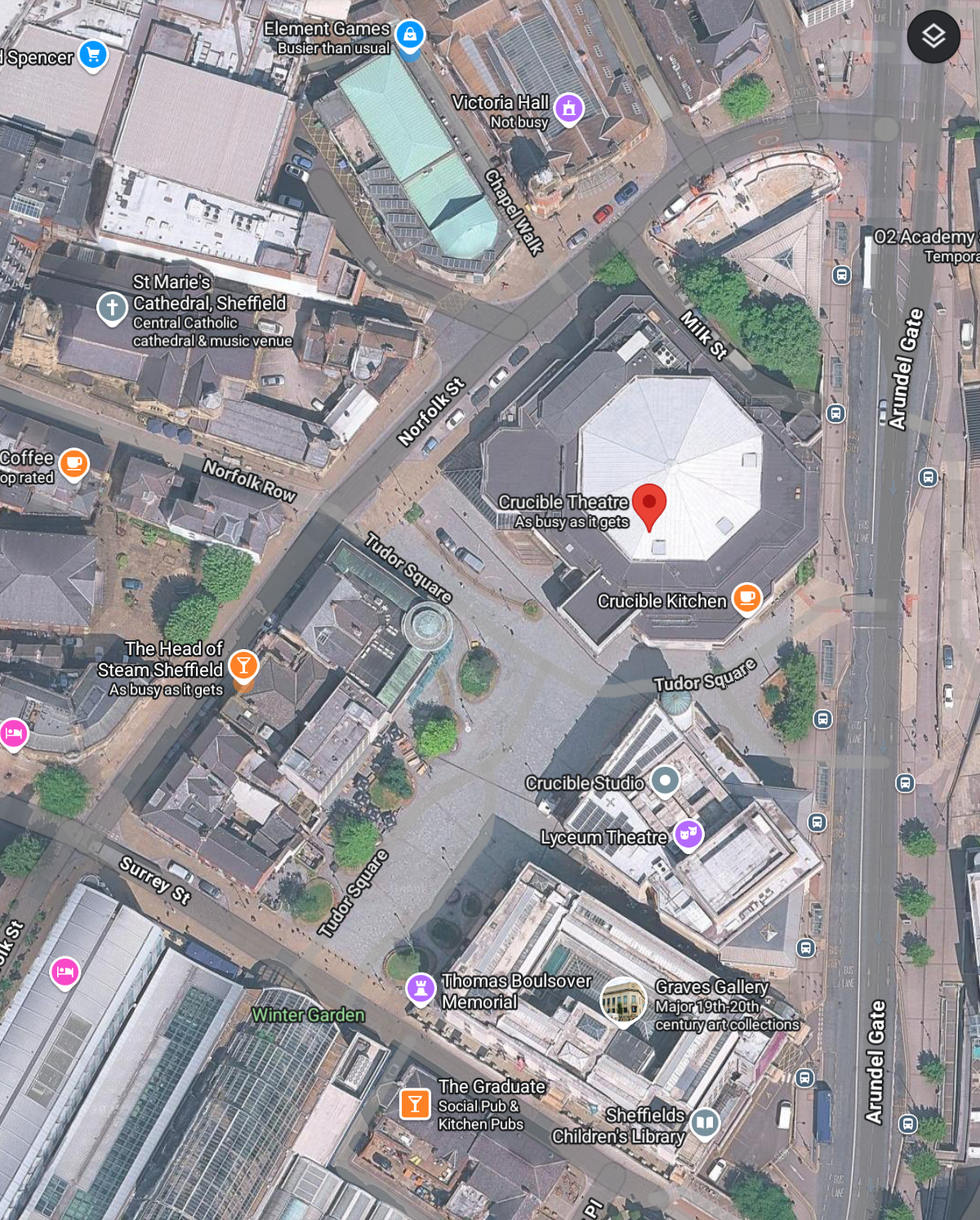
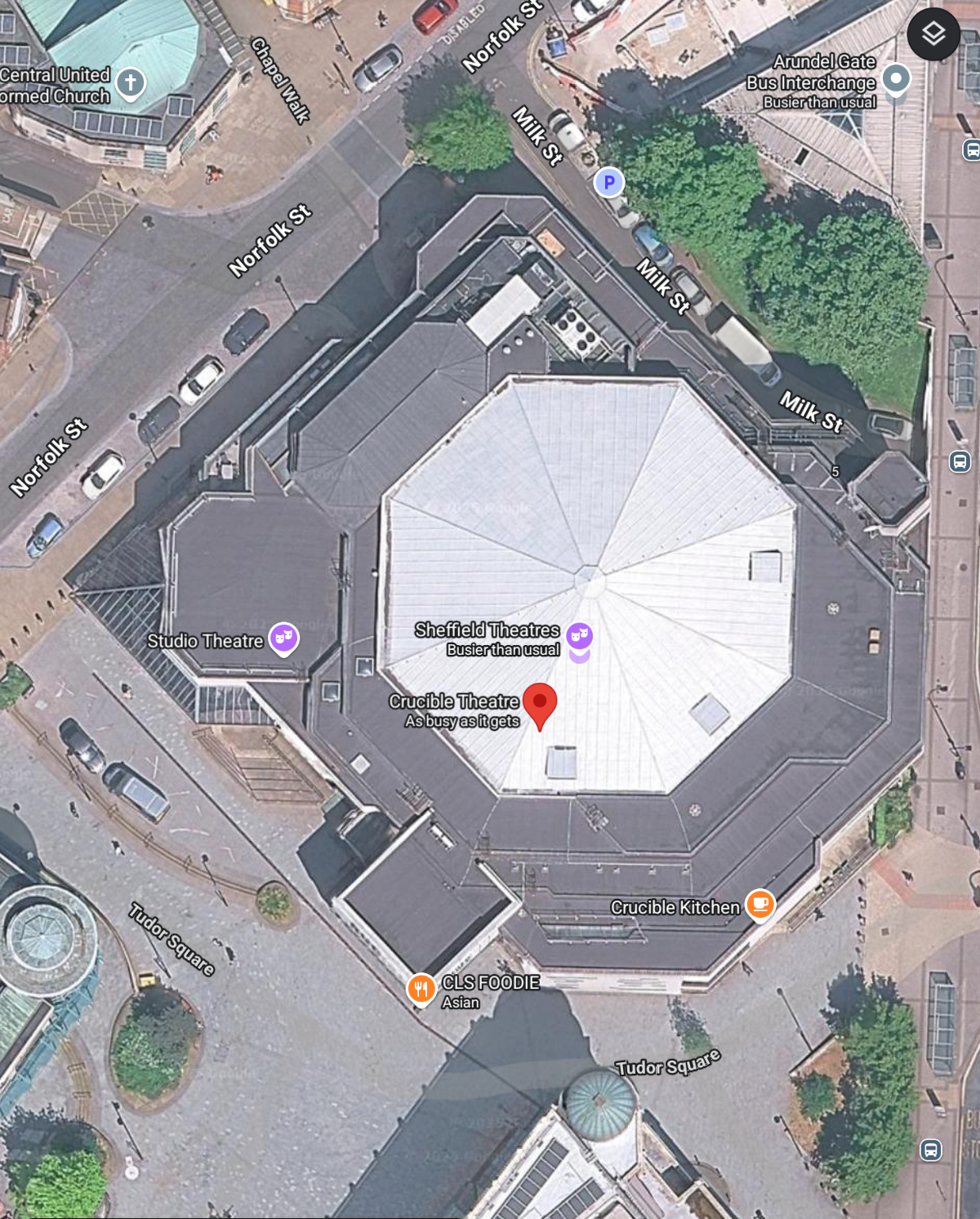

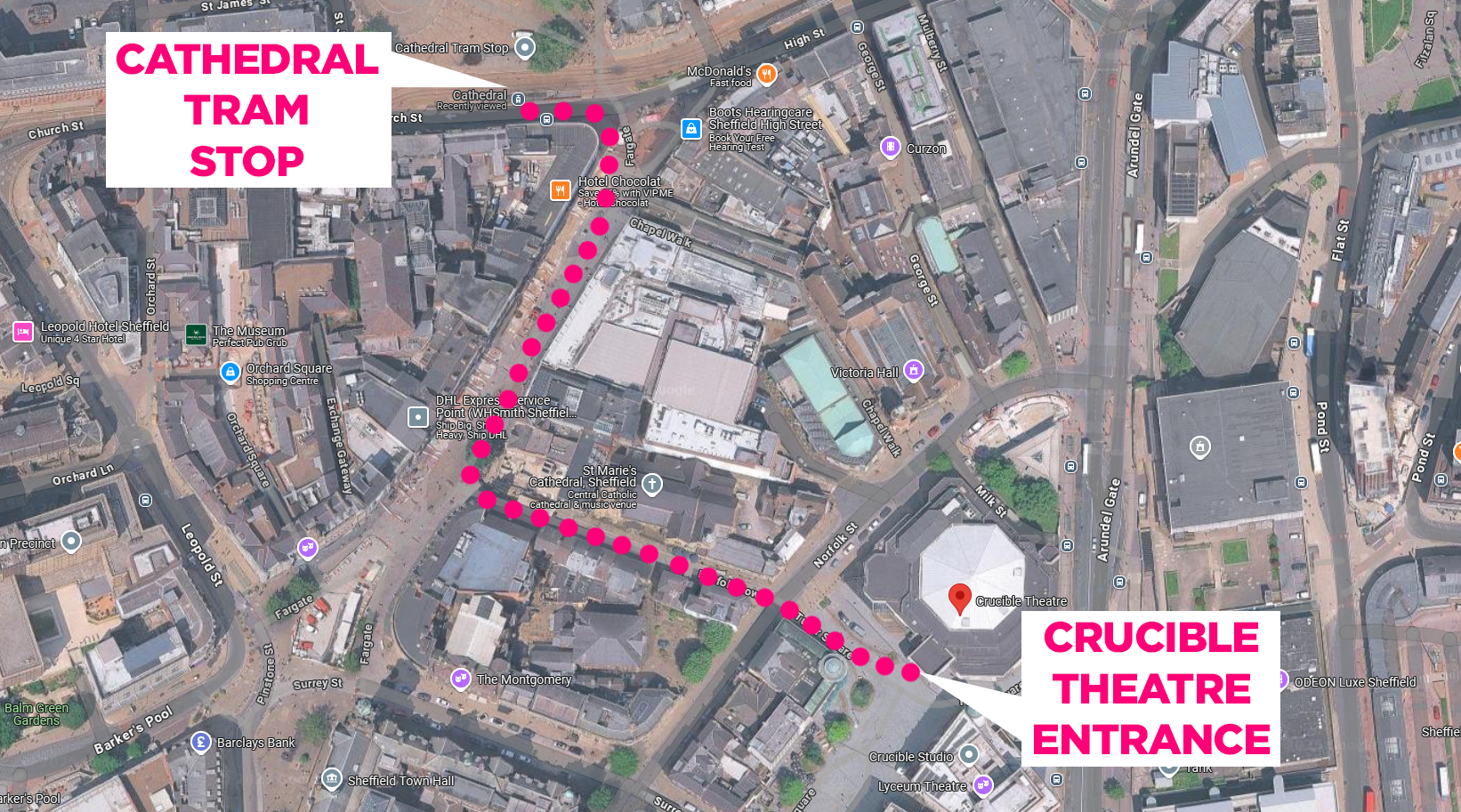
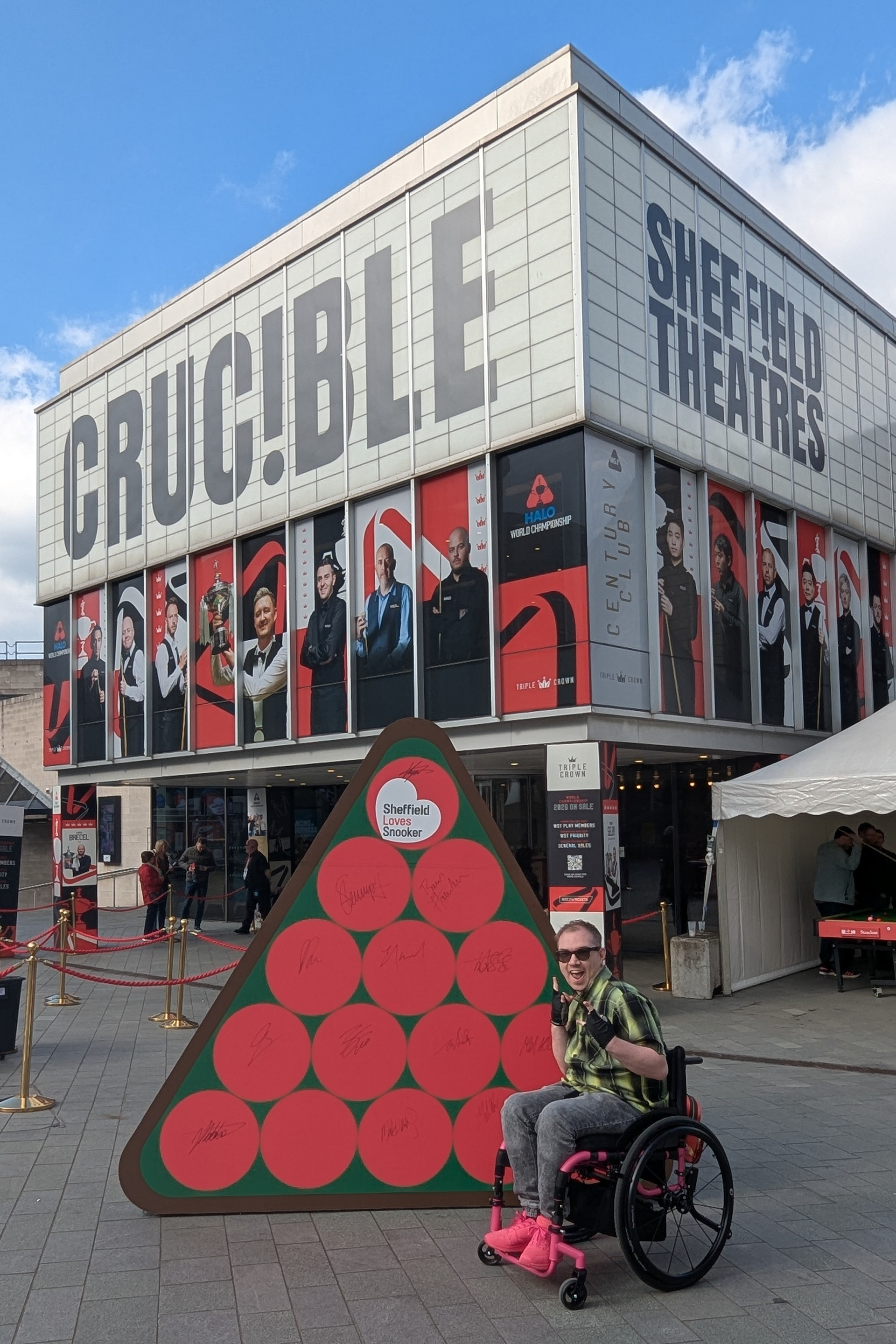
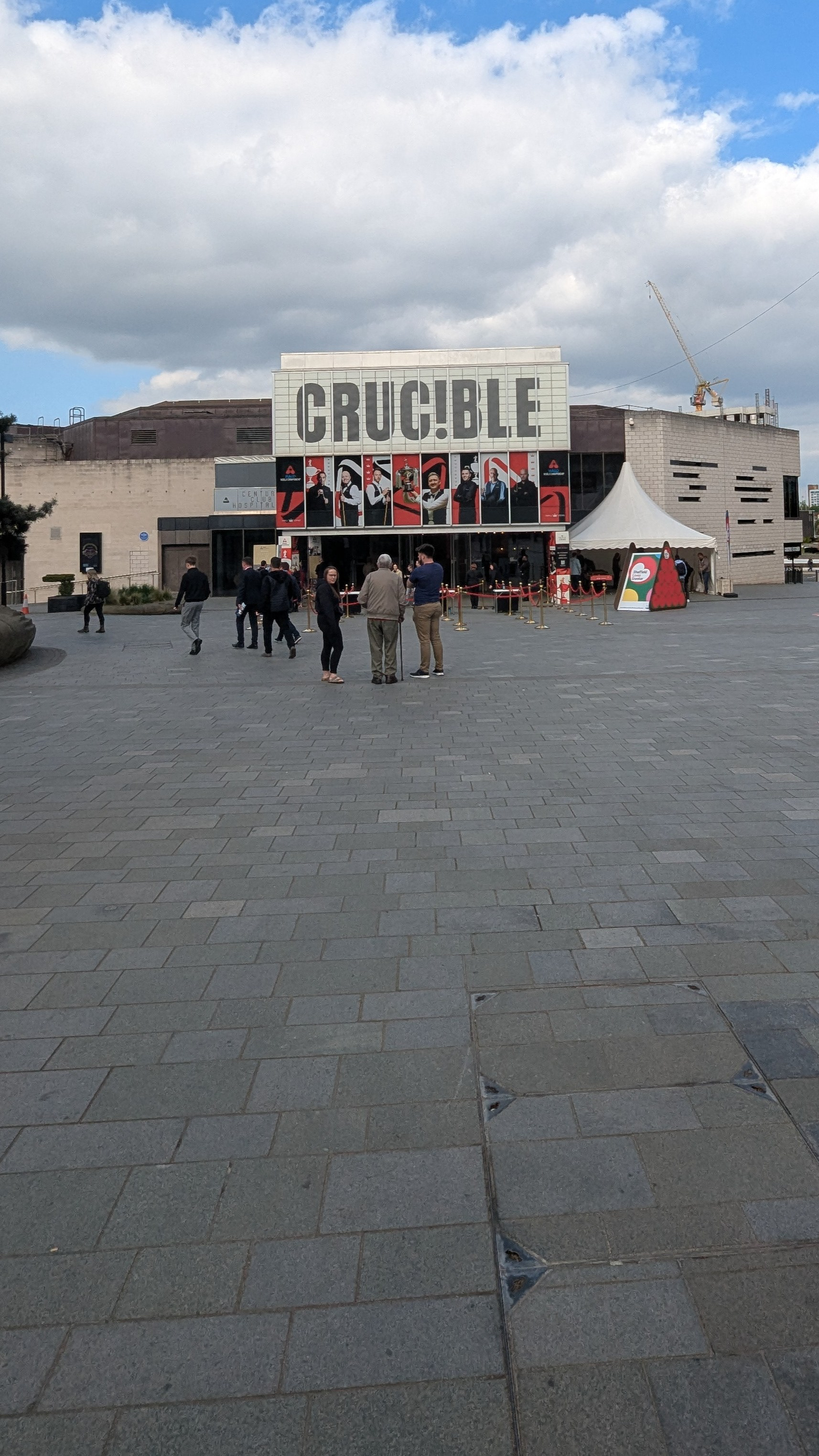
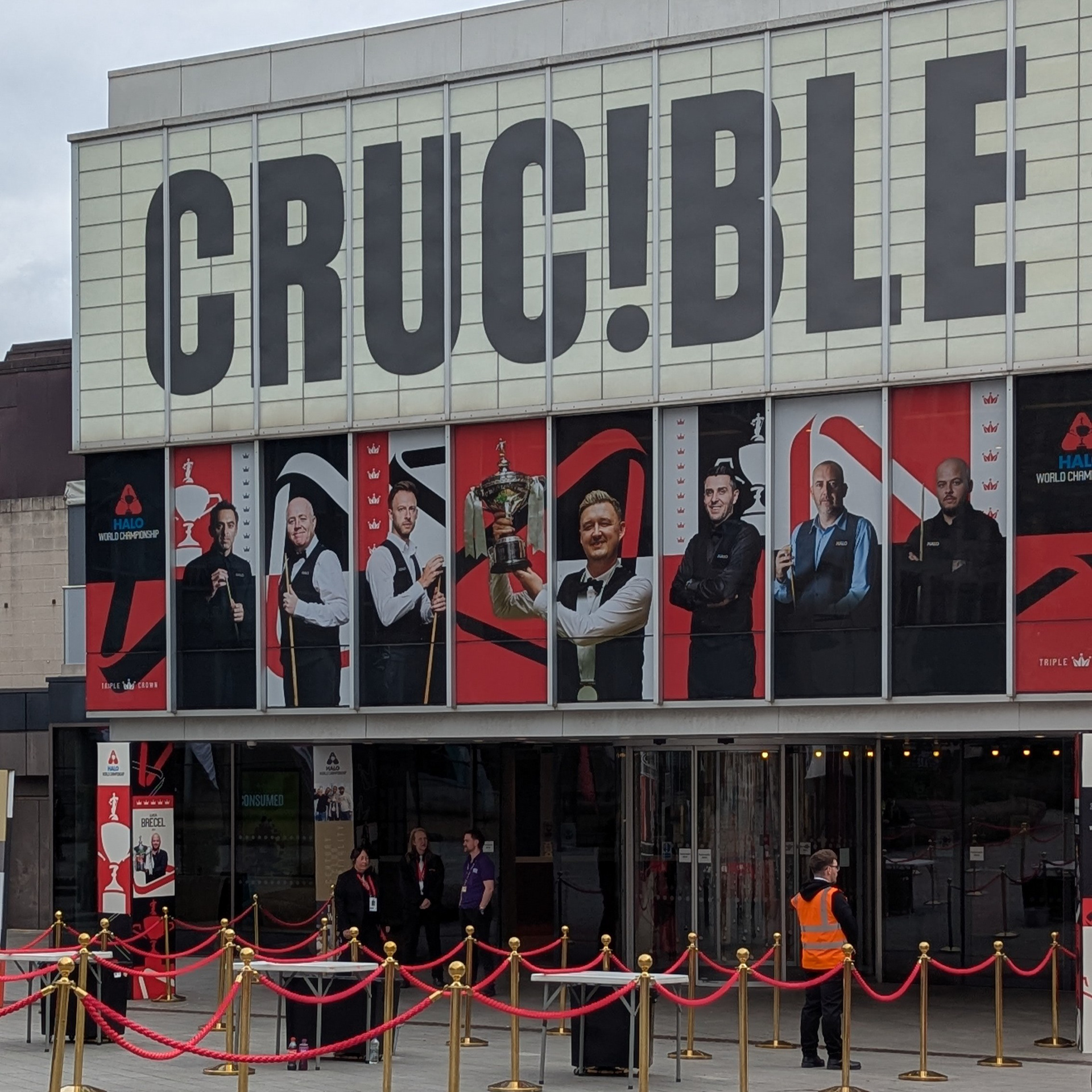




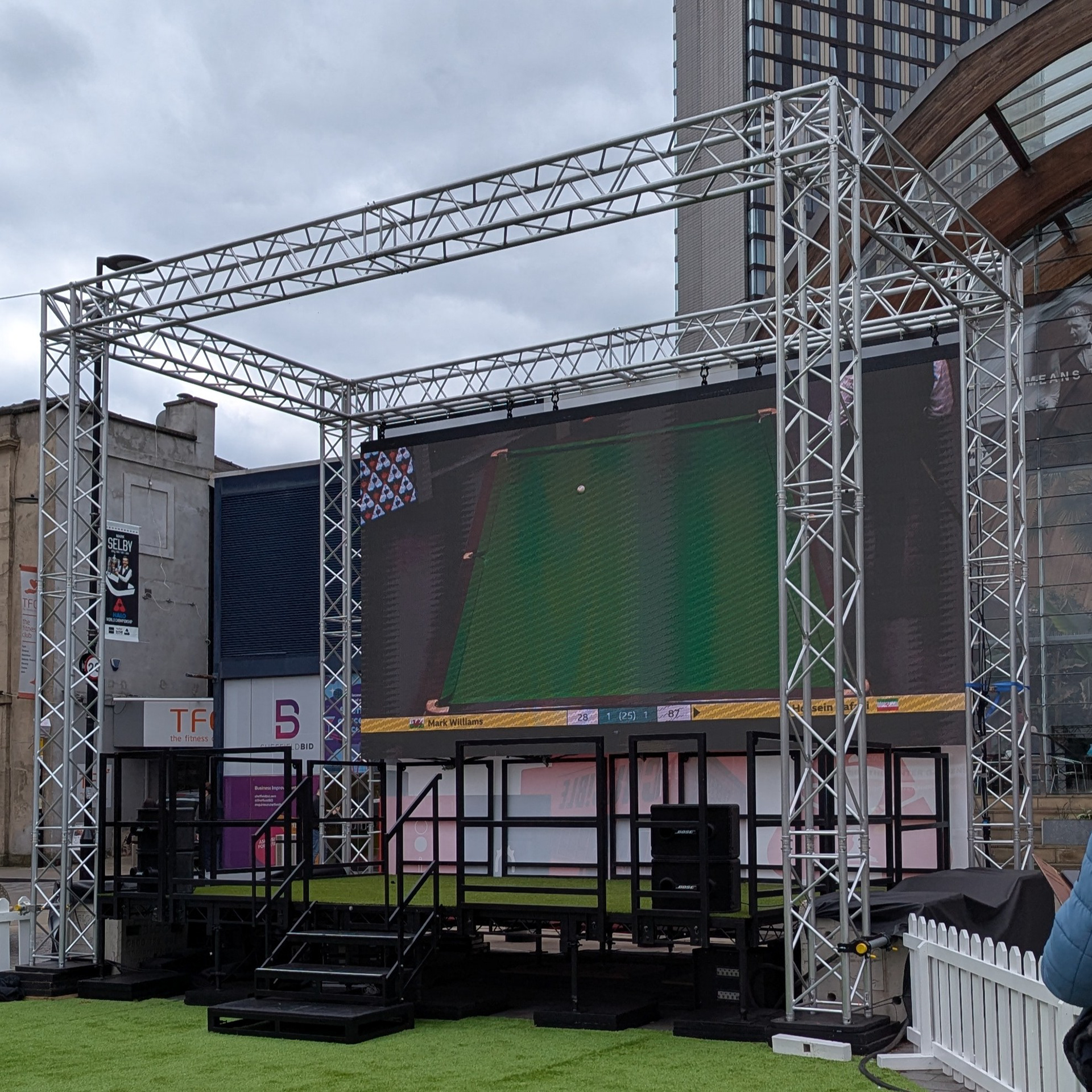
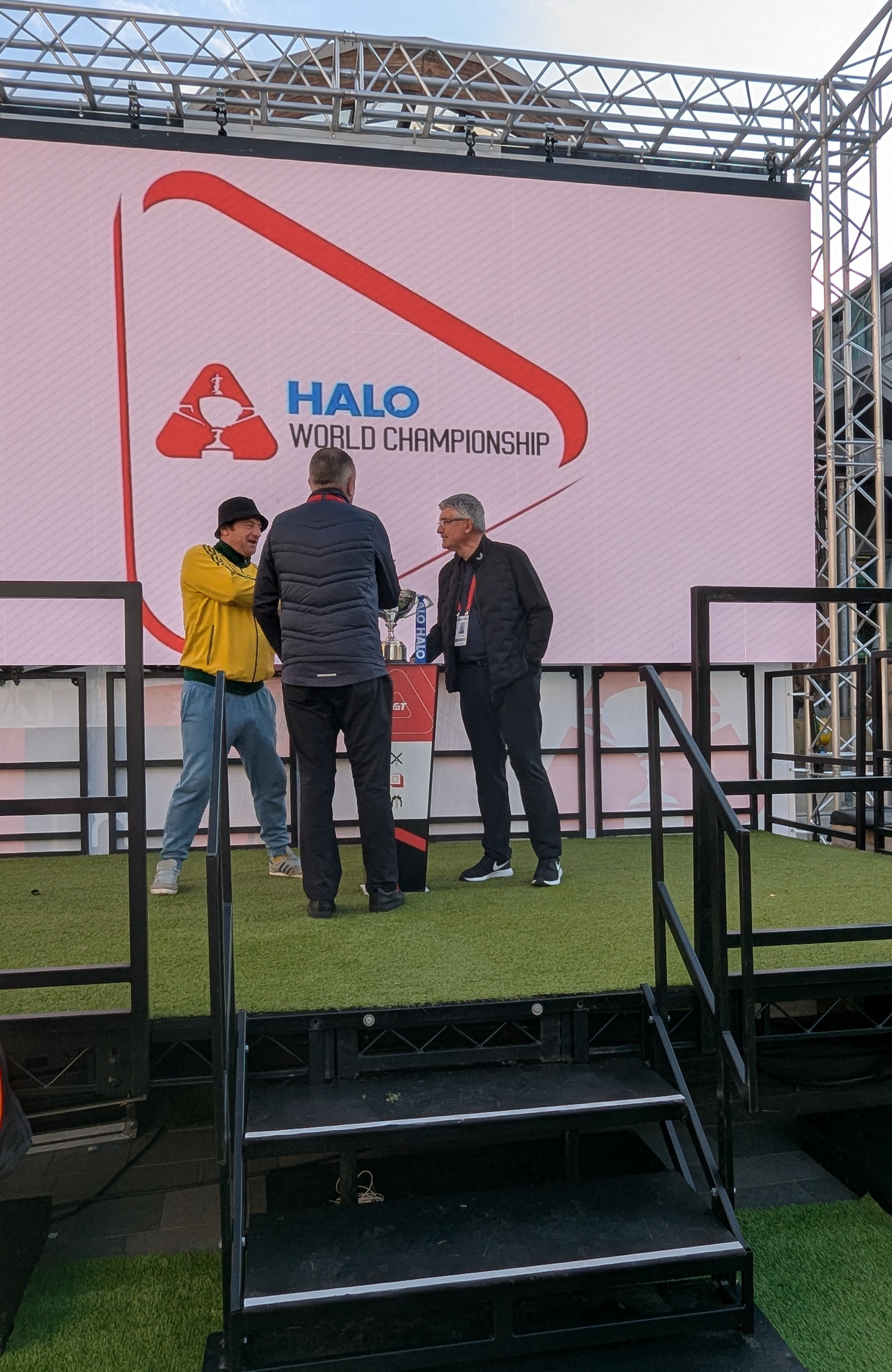
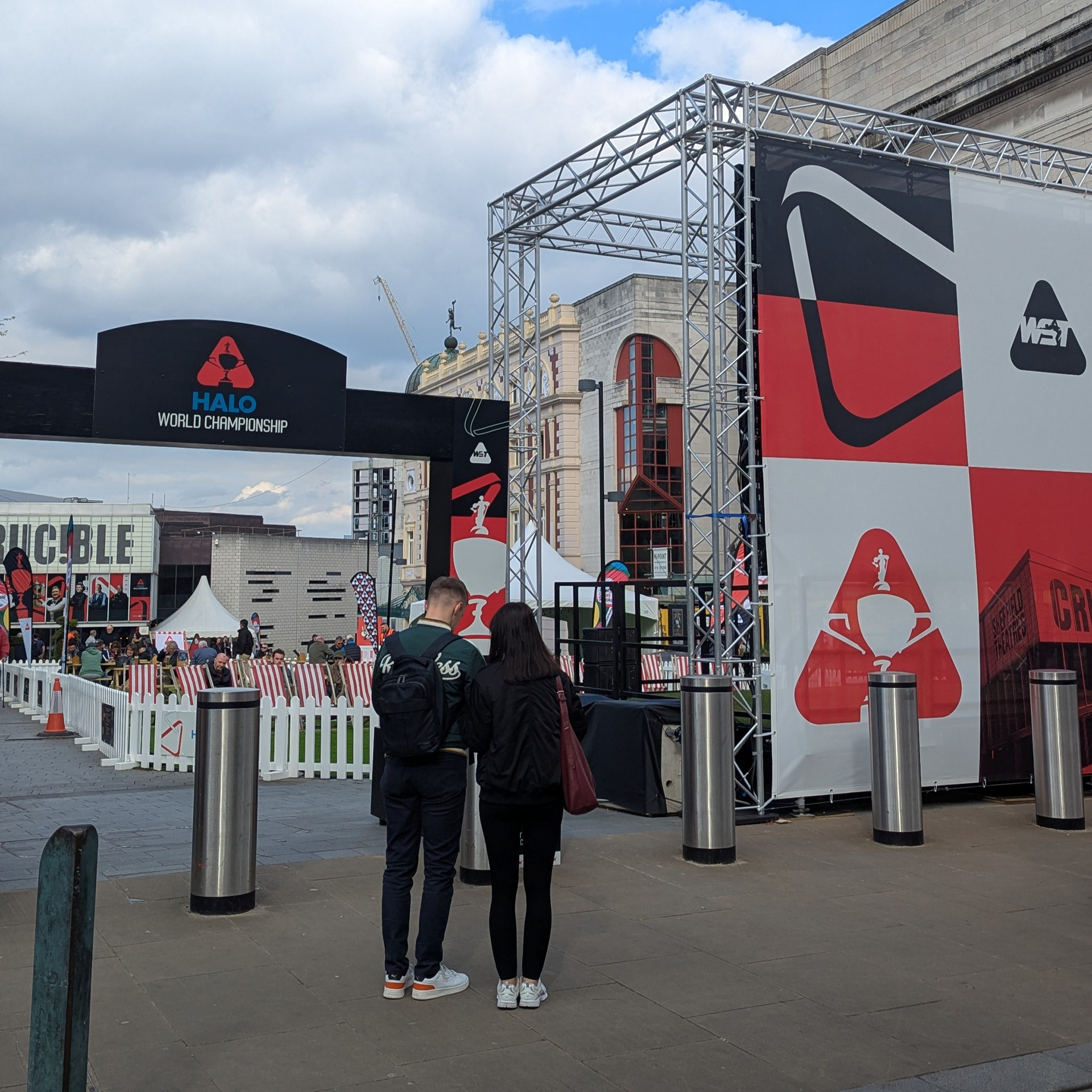
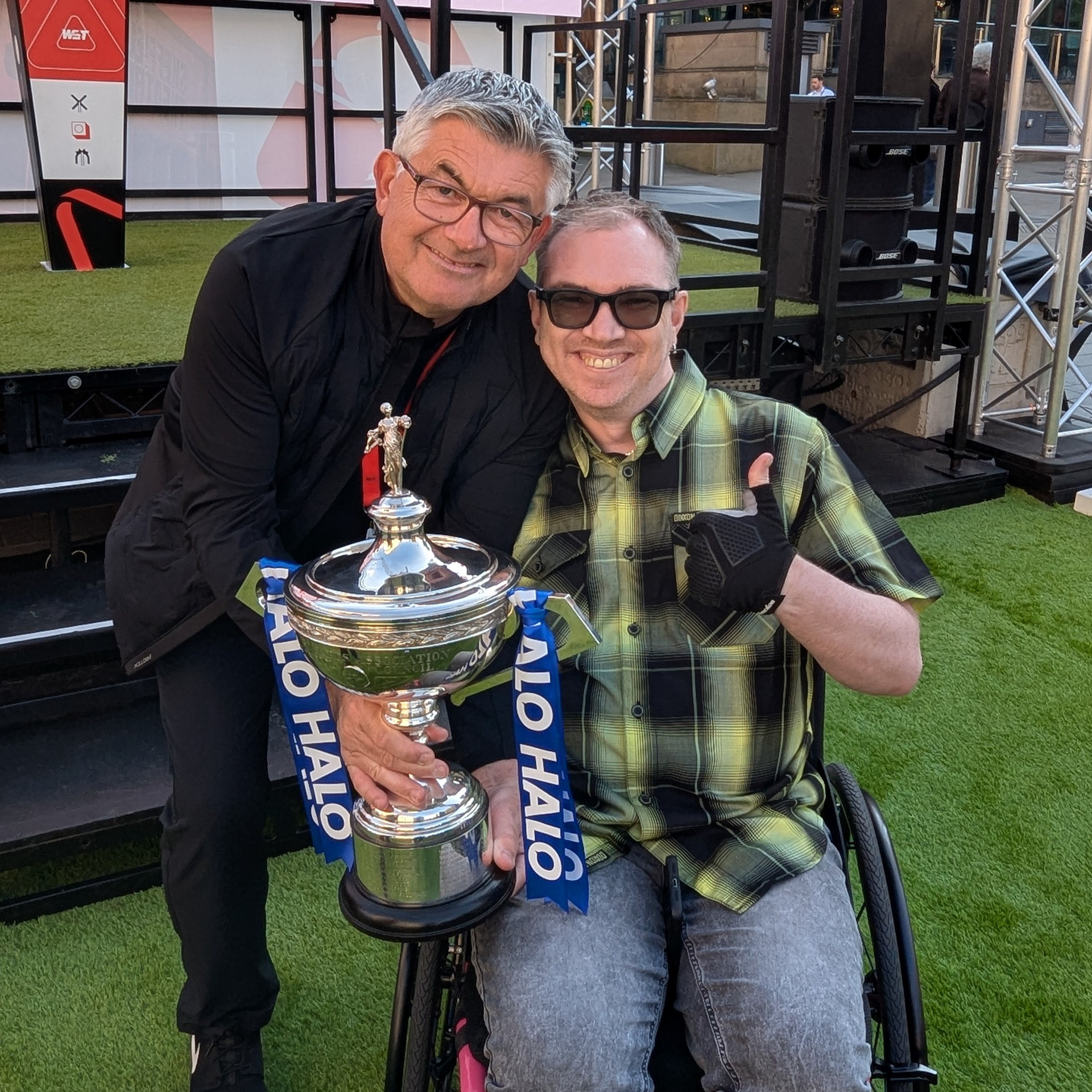
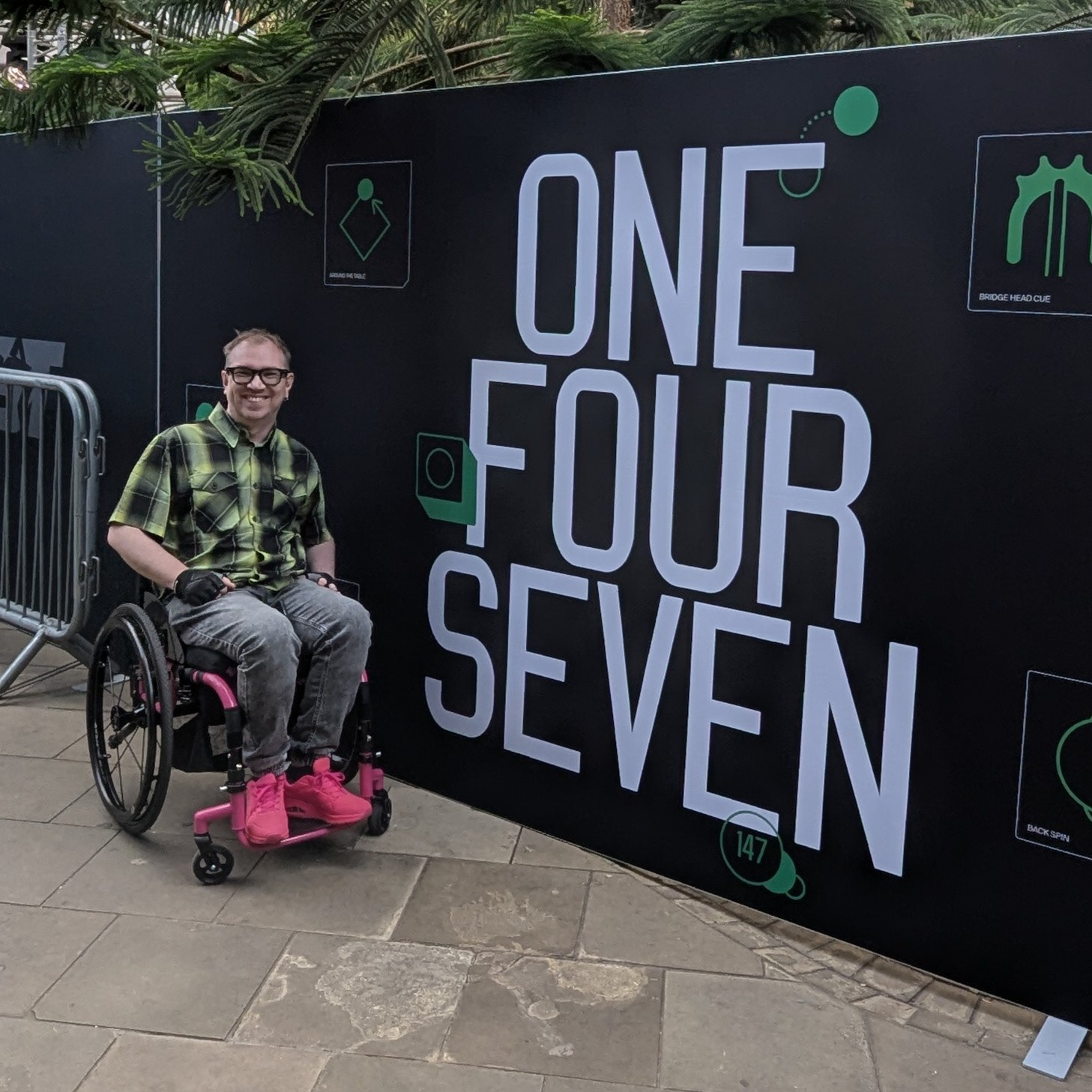
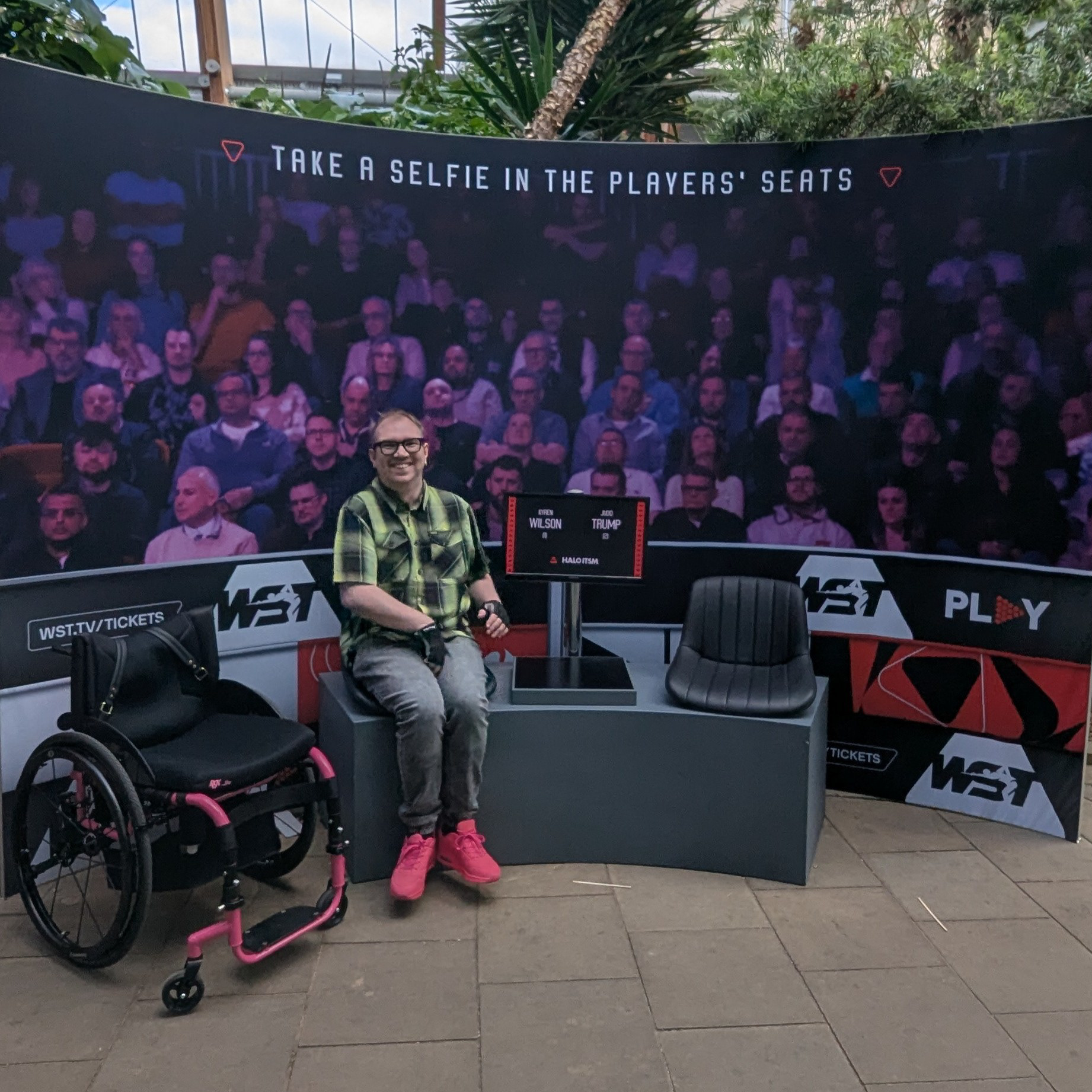
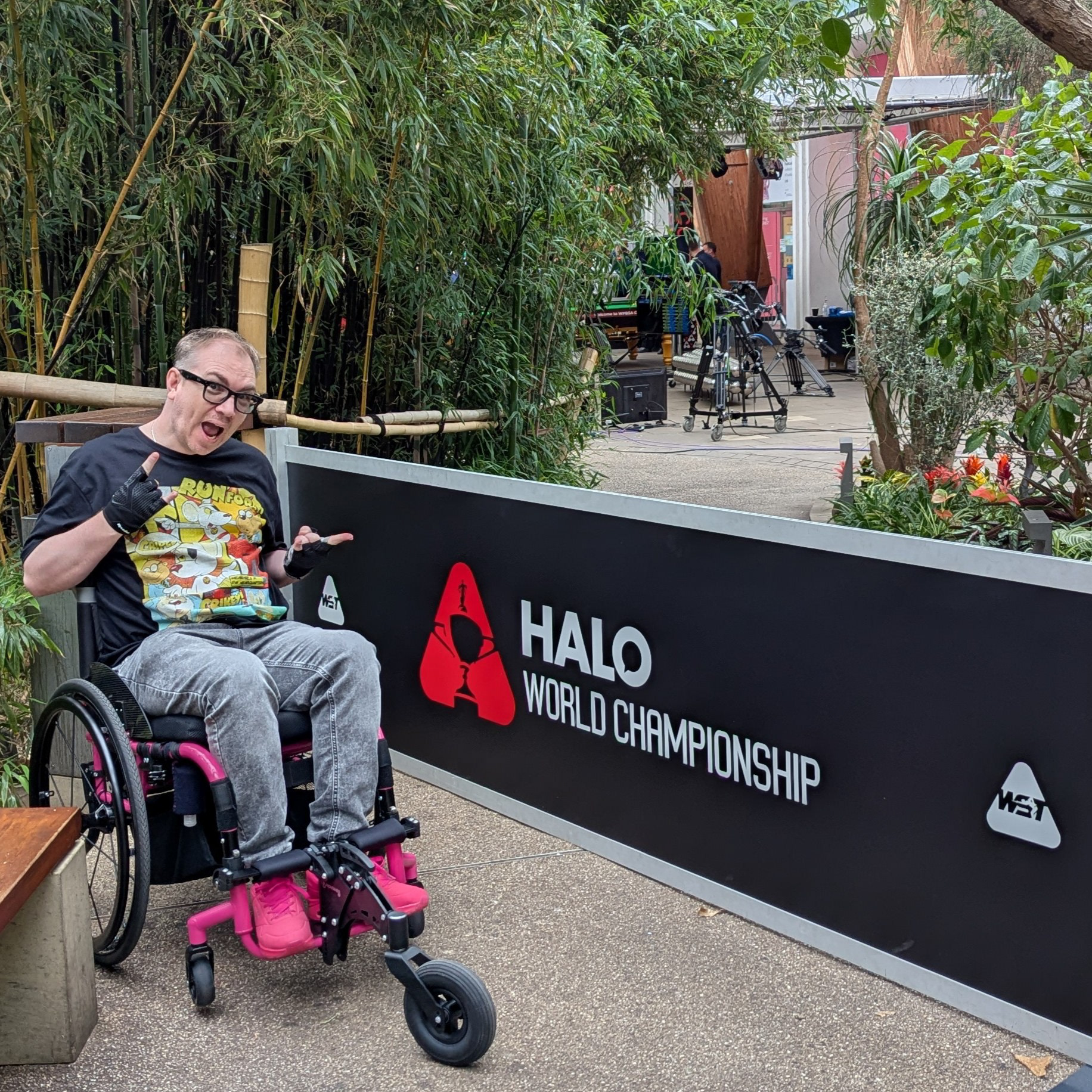

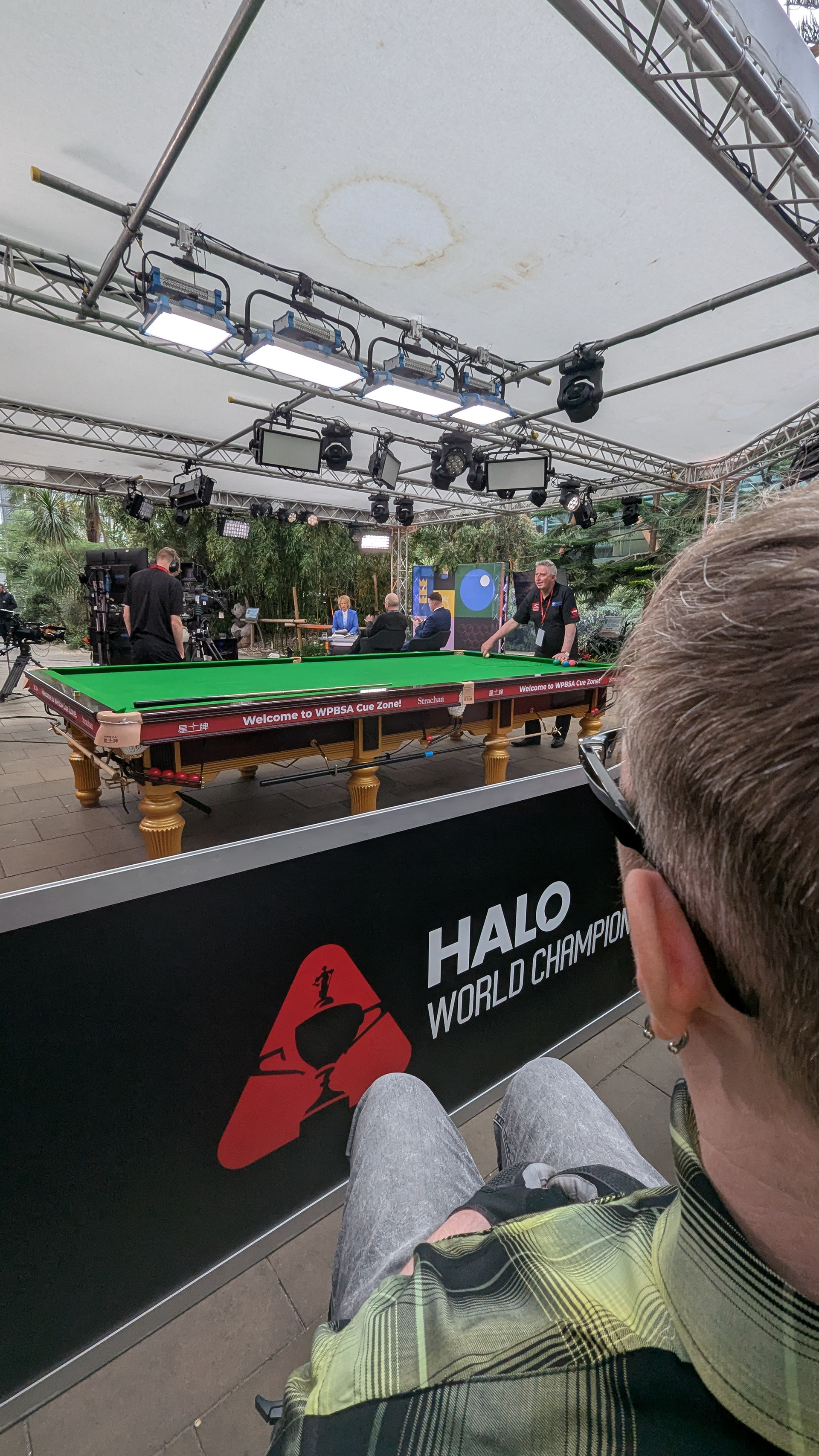
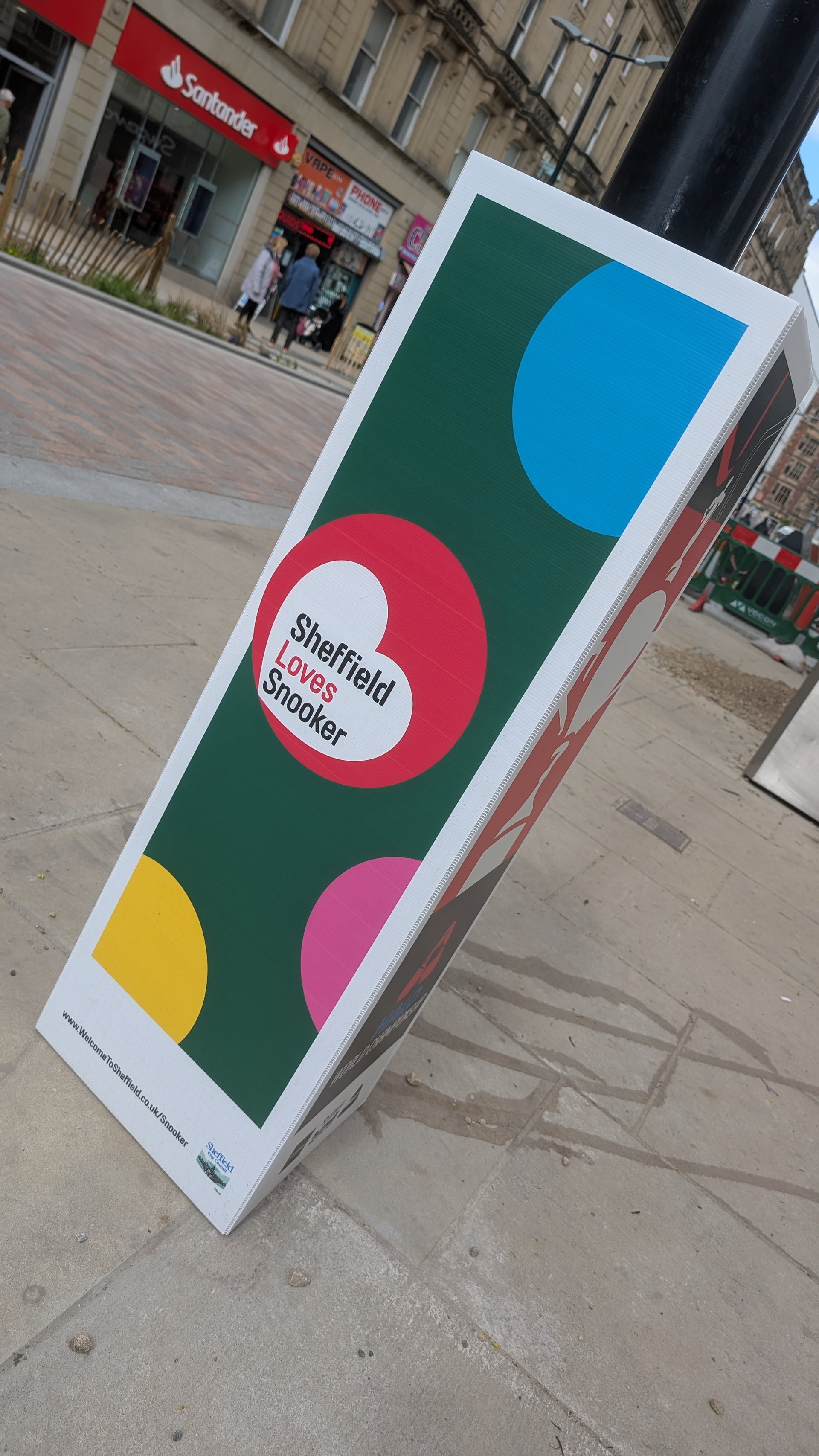
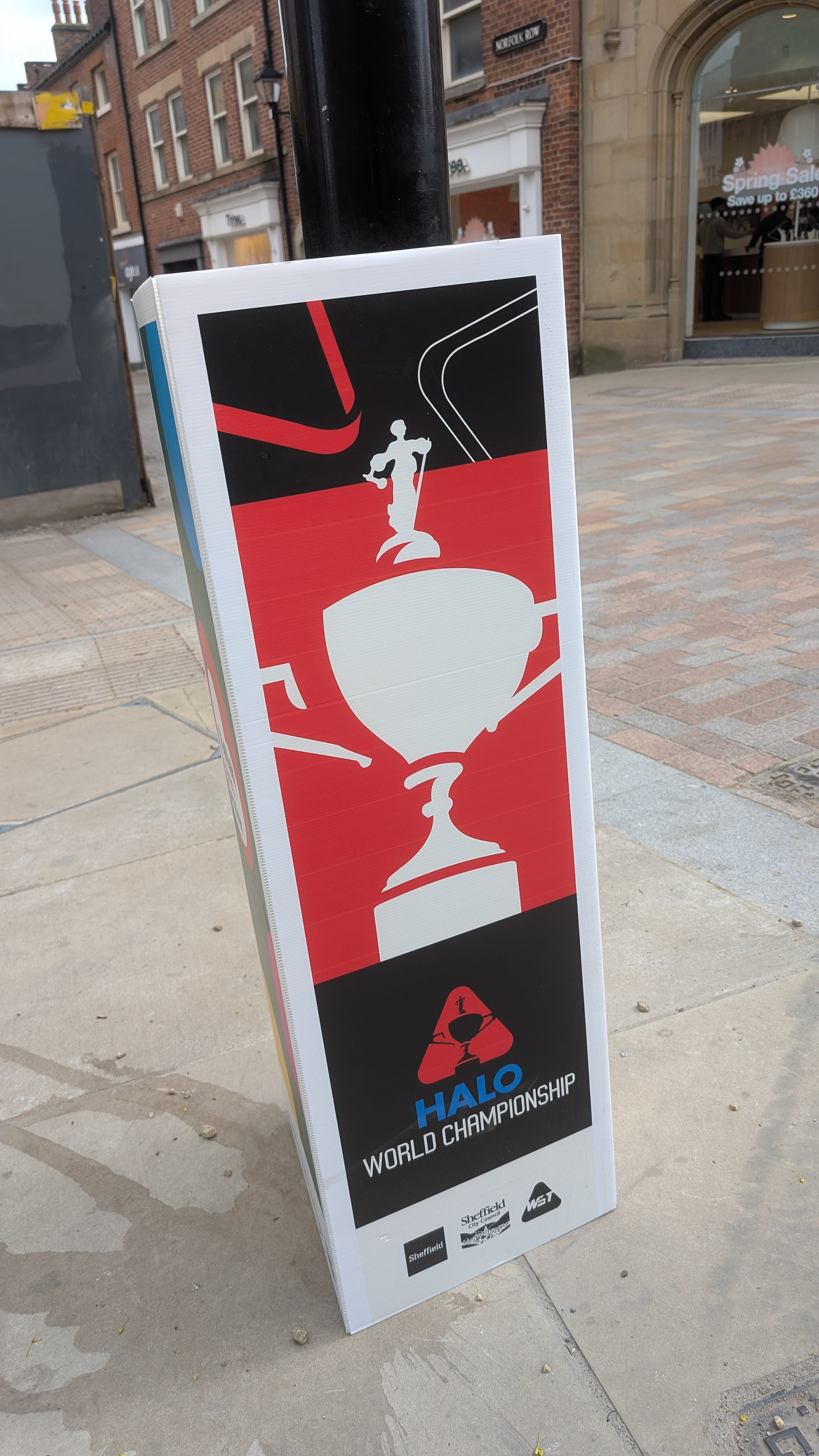
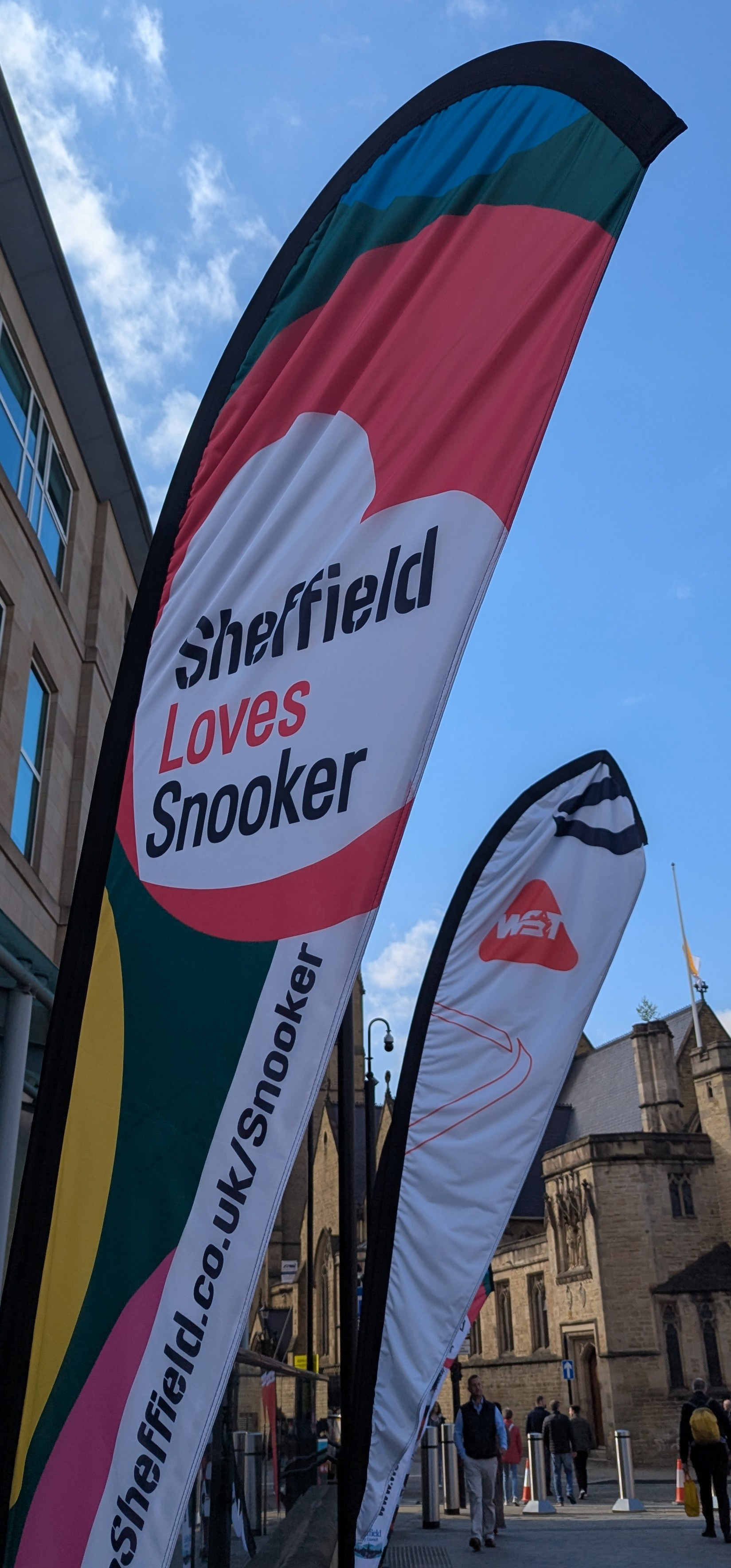
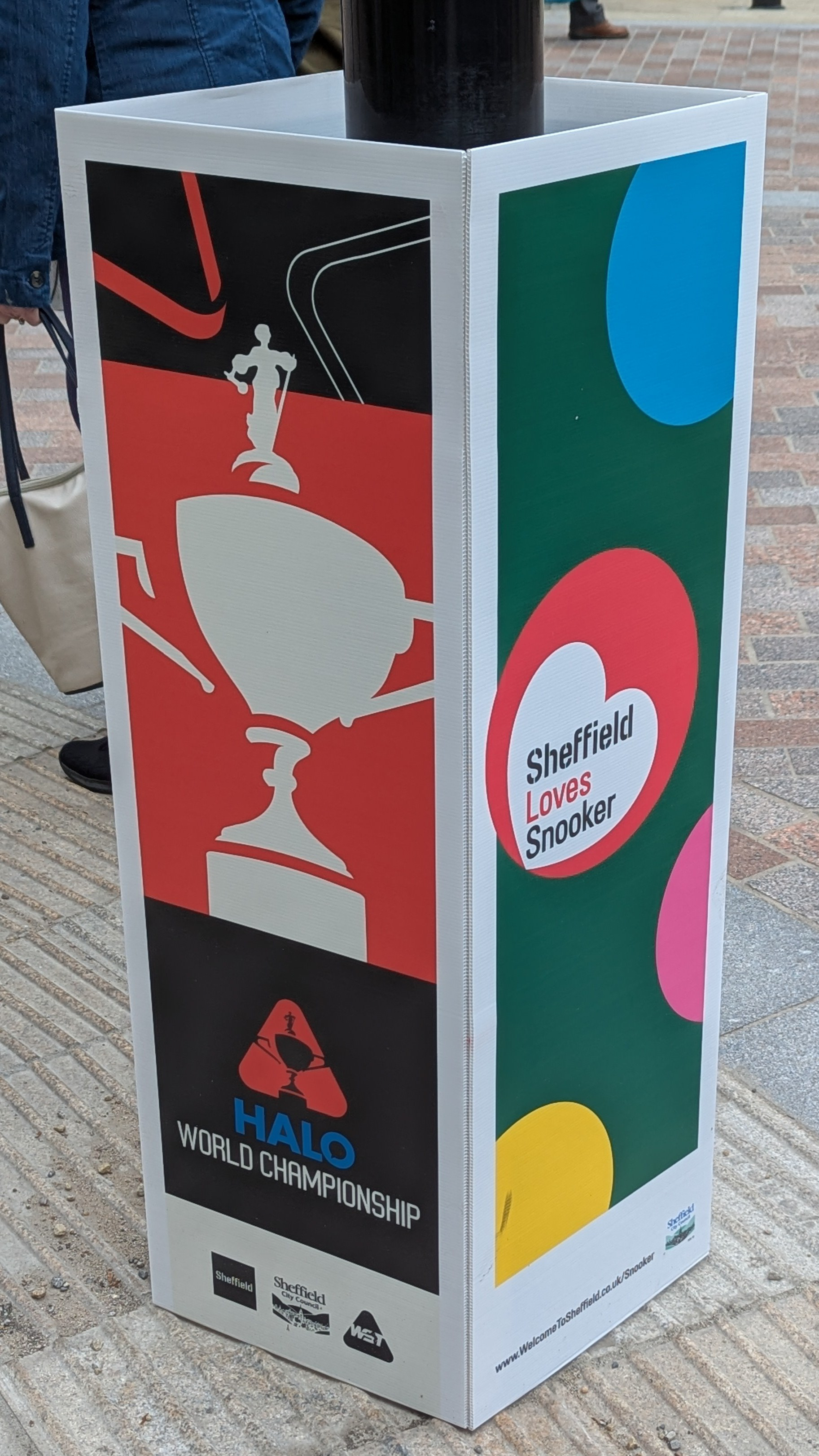
GETTING IN
As you approach the front of the building, you will see a security area set up. Over to the left-hand side was a dedicated lane for the hospitality guests and VIP package holders. There was no specific accessible lane with the other lanes, but all lanes were wide enough for a wheelchair, and all had handheld security scanners rather than walkthrough arches.
Bags were thoroughly checked, but the staff was efficient, and the queues were minimal. The entire process is step-free, so it’s easy to navigate.
Once we’d passed security, our tickets were checked outside the main doors, and we were shown into the foyer. The large automatic glass doors made getting in easy.
Just inside the doors was a small stall selling programmes and radios to listen to the match commentary.
We were soon approached by a member of staff who asked us which door was stated on our entry ticket, which was purple, and then directed us to the lift.
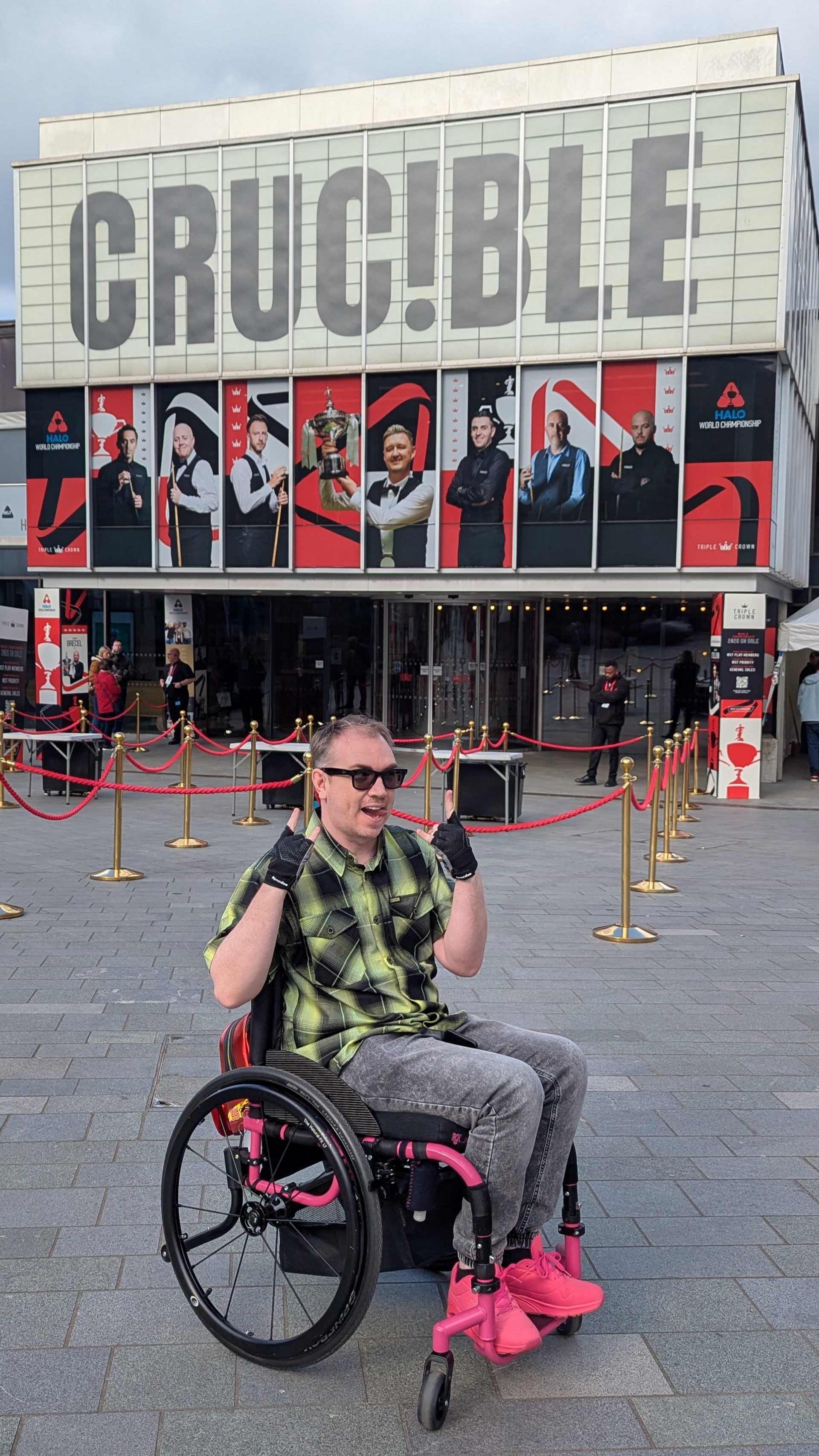

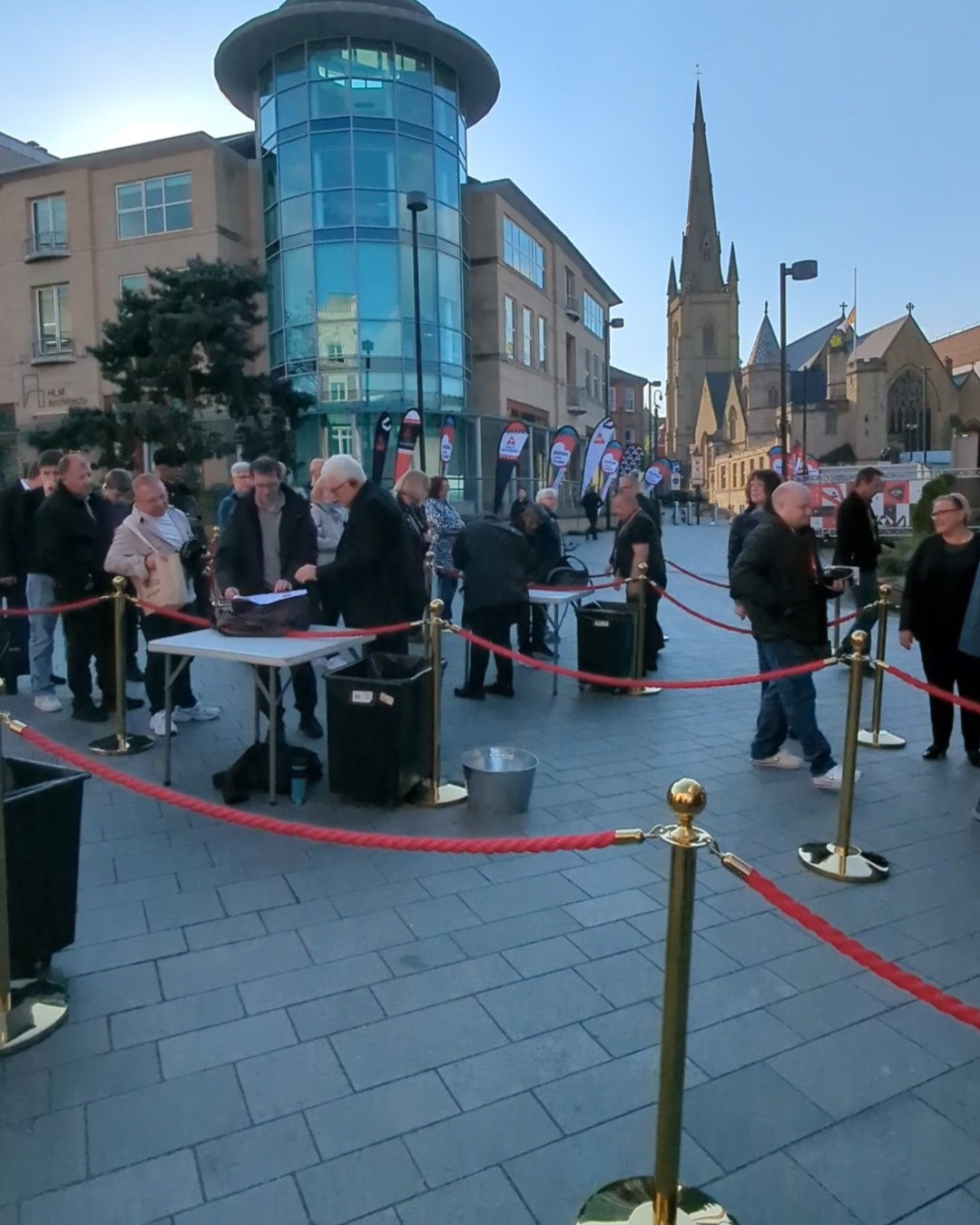



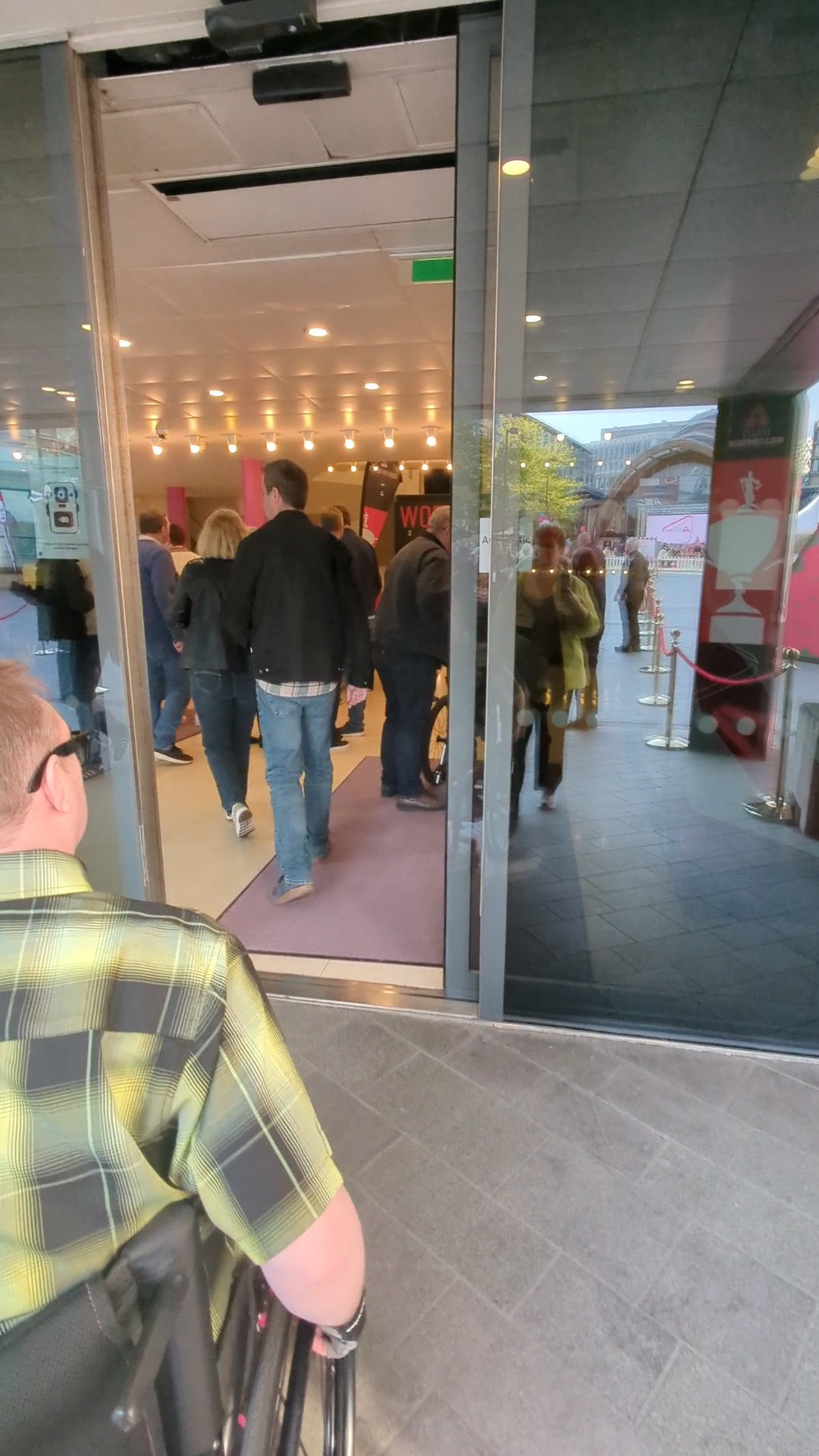
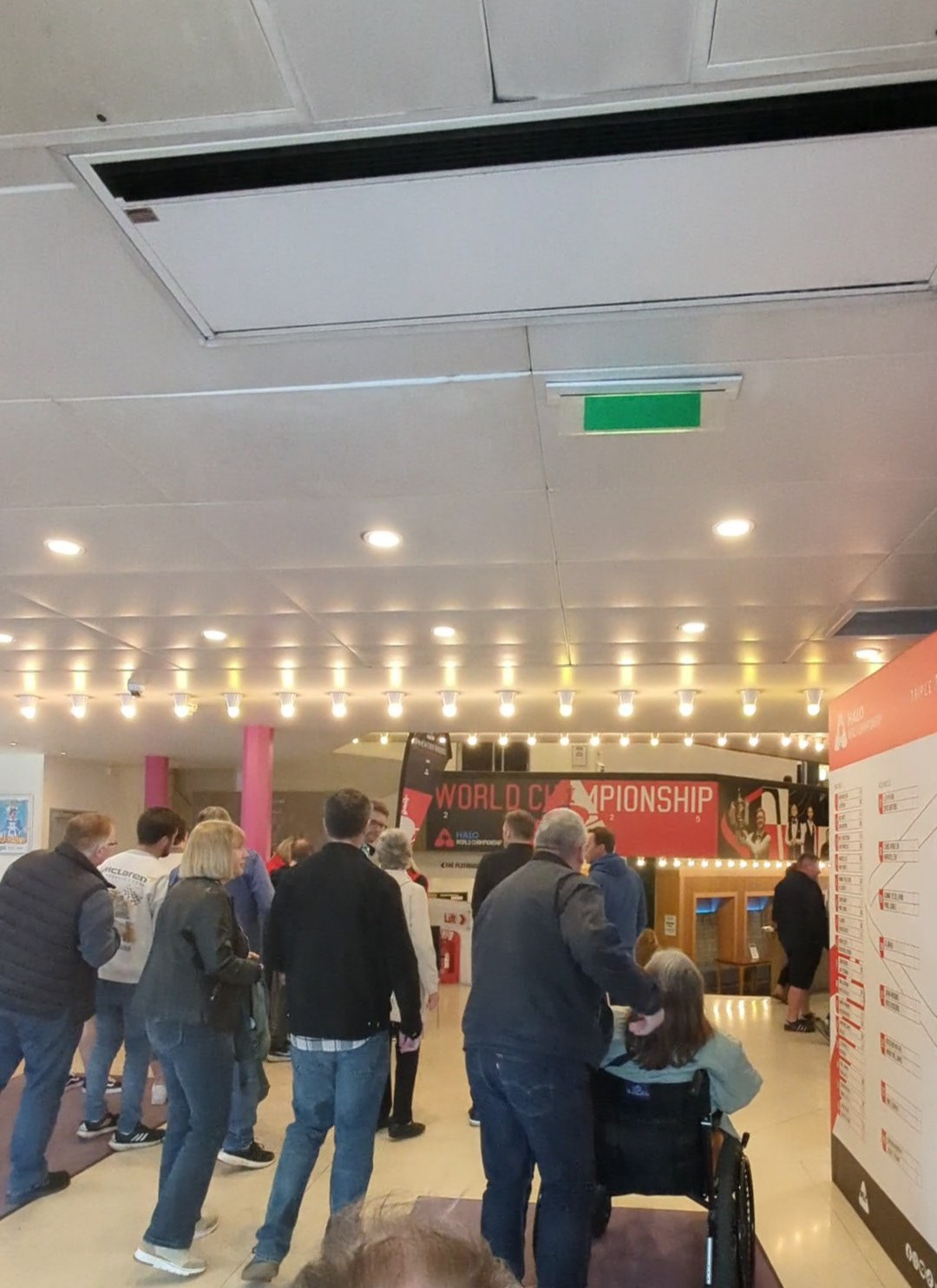
FACILITIES
For an old theatre, the facilities are pretty good. They’ve really considered access requirements.
As you enter the building, you’re in a foyer with little happening. The box office is to the left, with a desk to welcome hospitality and VIP package holders. This foyer area is classed as Level 1 of the building.
Over to the right are two wide staircases - one going up, the other down and hard round to the right is a lift, tucked around the corner. A staff member at the lift with a radio checks your door colour, shows you into the lift and then radios another staff member to get you to where you need to be. The lift buttons are all covered by a notice showing the different building levels, and the staff call the lift to the relevant levels. In some ways, it seemed strange that they do it this way, but it means the lift is kept clear for access customers, and you don’t have to wait long for the lift to come.
From the lift, you can access all levels of the building.
Down on Level 0, you’ll find the Crucible Kitchen. It’s a lovely, spacious cafe area that serves drinks, snacks, sandwiches, soup, salads, and cakes.
There is no lowered counter but lots of low-level seating and tables.
There are toilets on this level and a Changing Places facility.
You can also order your interval drinks to be collected from the Kitchen.
Our seating was accessed from Level 2.
Exiting the lift and following the short corridor, you’re out into the horseshoe-shaped concourse area. The auditorium is to the left, and the refreshments and merchandise are to the right. The floor is all carpeted. Each set of double doors into the auditorium is coloured for easy reference, so you know which entrance you need to use for your seating. The concourse is bright and airy.
Immediately to your left is the staircase and pathway leading to the orange door. In front of you is a small cafe bar selling hot and cold drinks, ice creams, and snacks, with a lowered counter on the right-hand side.
Following around from here was a merch area selling snooker memorabilia, with the Red door opposite it.
If you follow even further around, you’ll find the Purple door on your left and the main bar to the right. The bar area is up some steps, but there is a long ramp with handrails leading up to that level.
The bar area has a limited amount of high-level seating.
A lowered part of the bar, with clear space to wheel underneath, was marked as closed.
The bar had a water dispenser for free tap water and a good selection of drinks.
A doorway to the toilets is at the left-hand end of the bar. The ladies’ toilets are up a flight of stairs. The accessible toilet is under the staircase next to the men’s toilet. No radar key is required for the accessible toilet. The large door opens inwards; however, the men’s toilet door opens outwards! As I was trying to get in and out of the accessible toilet, the men’s toilet door was swinging open, people were walking into me, and I was trying to avoid being hit by the door. It was also noted how many men were using the accessible toilet to avoid the queues, with only short gaps between frames in the snooker, people tried to dive out quickly to the toilet, and with it being a male-dominated audience, there was often a queue!
Inside the accessible toilet, it’s long and slim with all the relevant access features and lots of free floor space for turning.
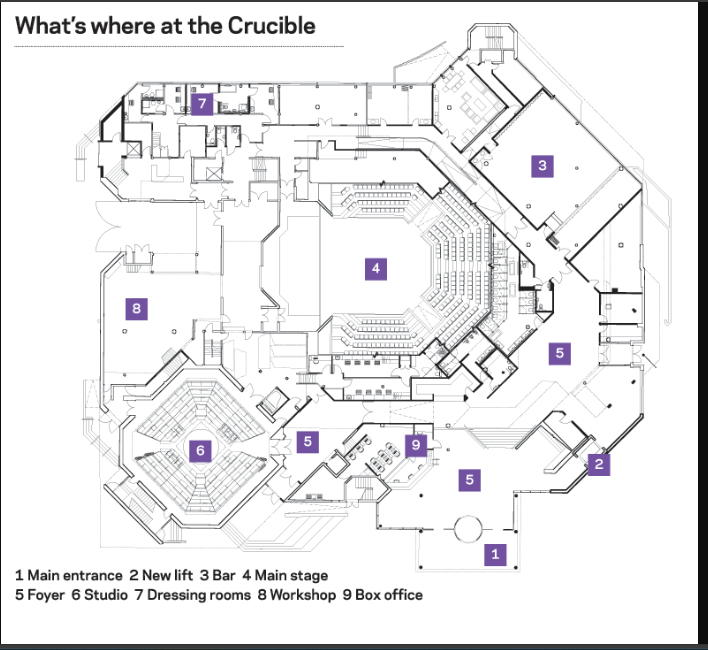
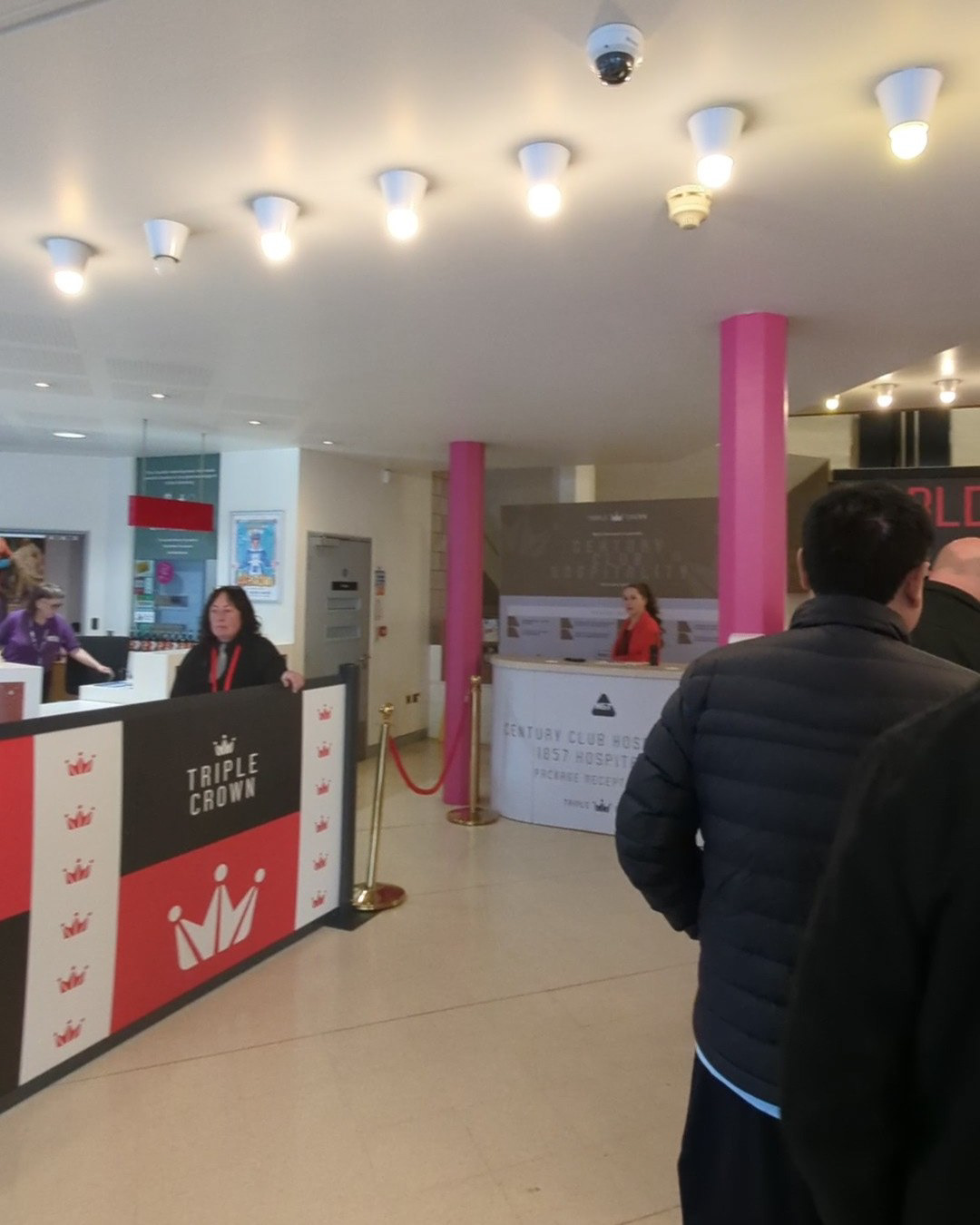
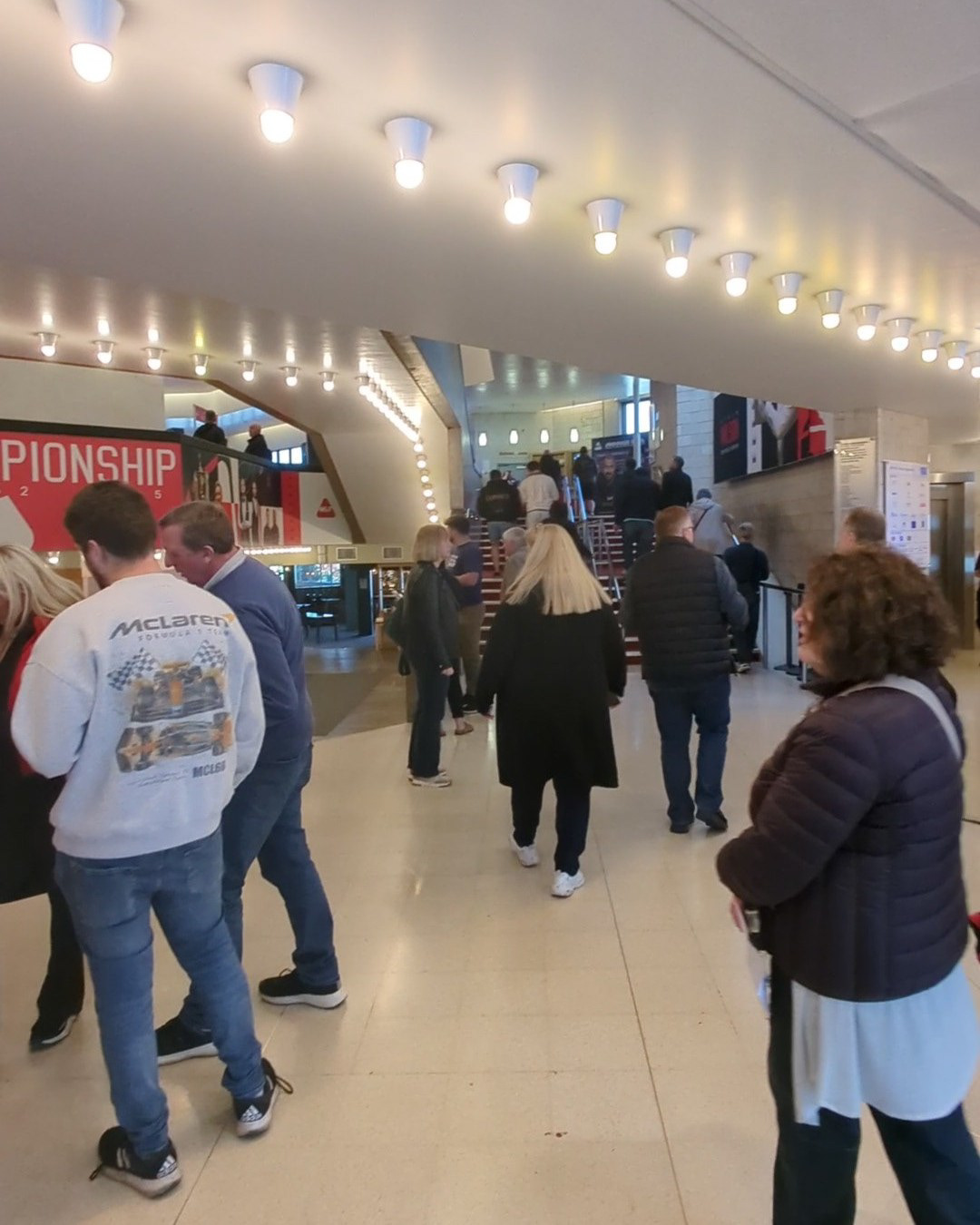

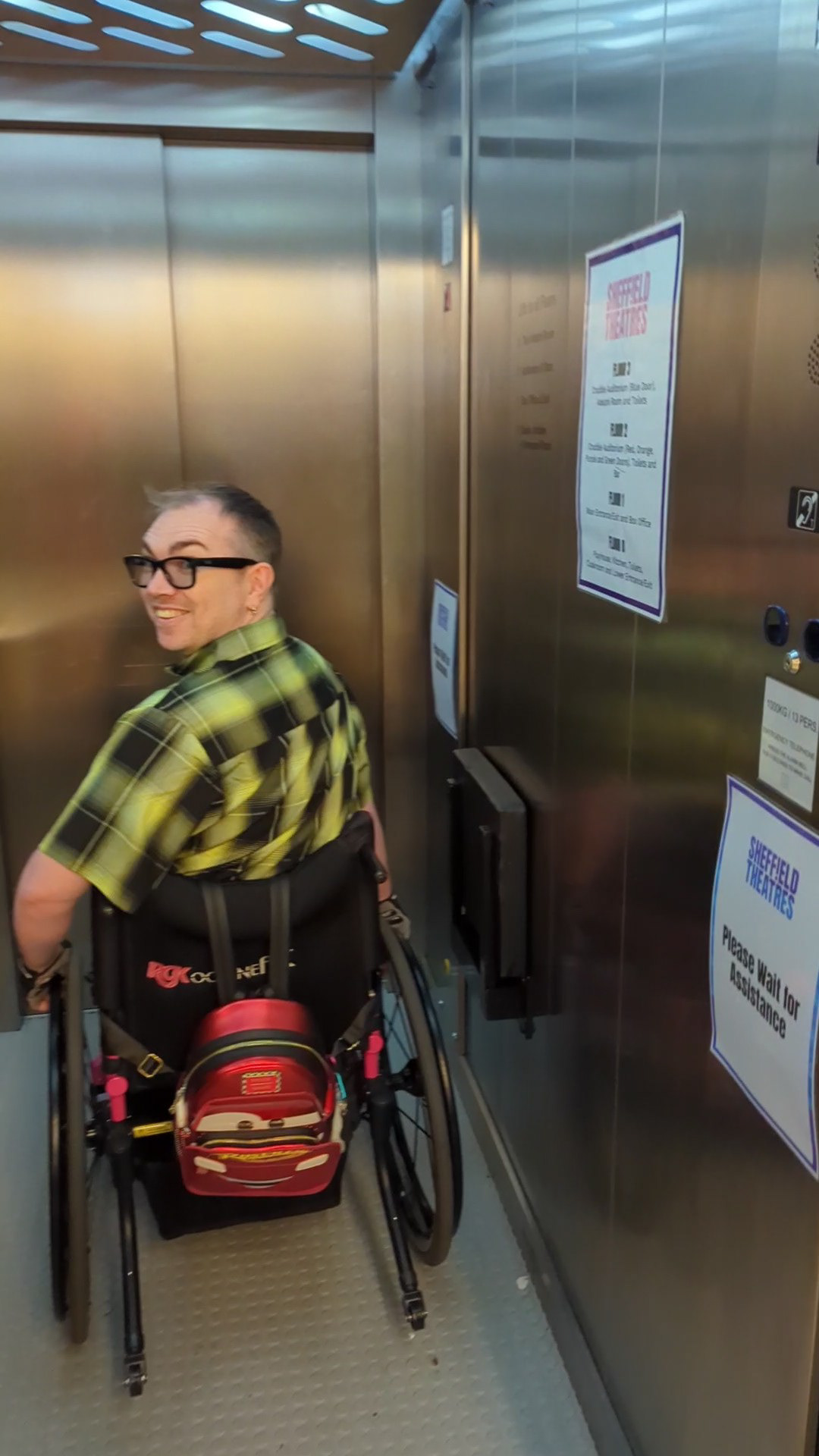
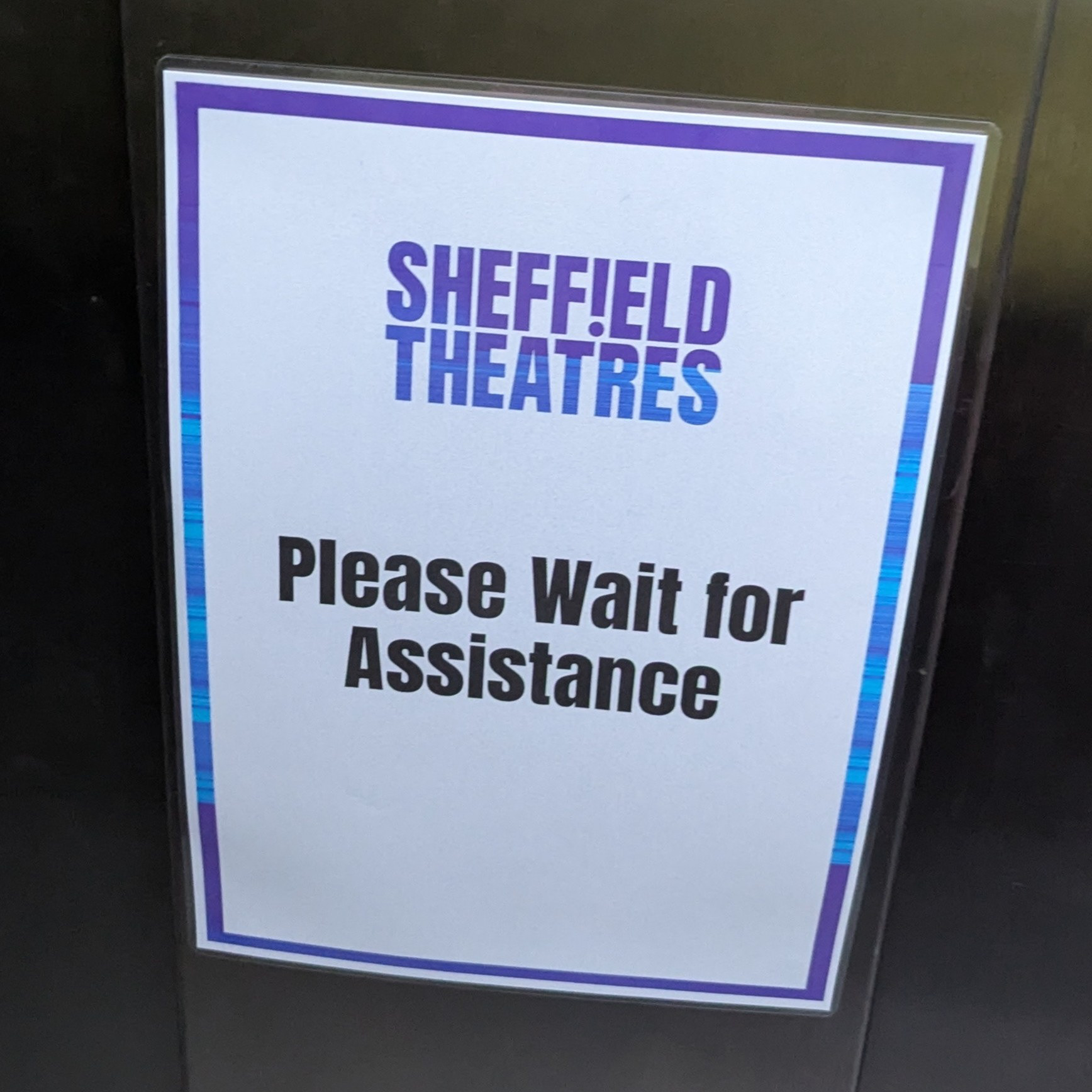
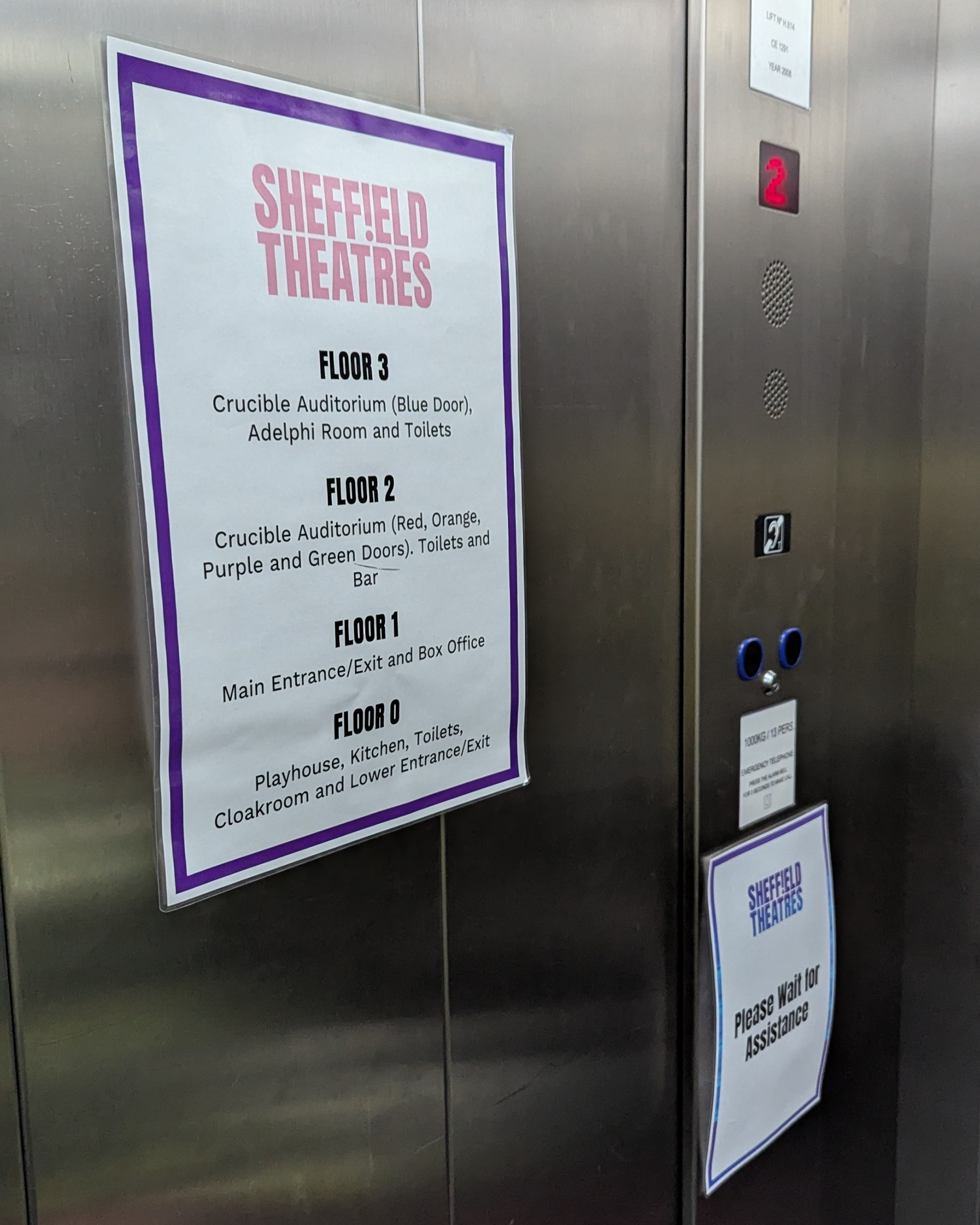
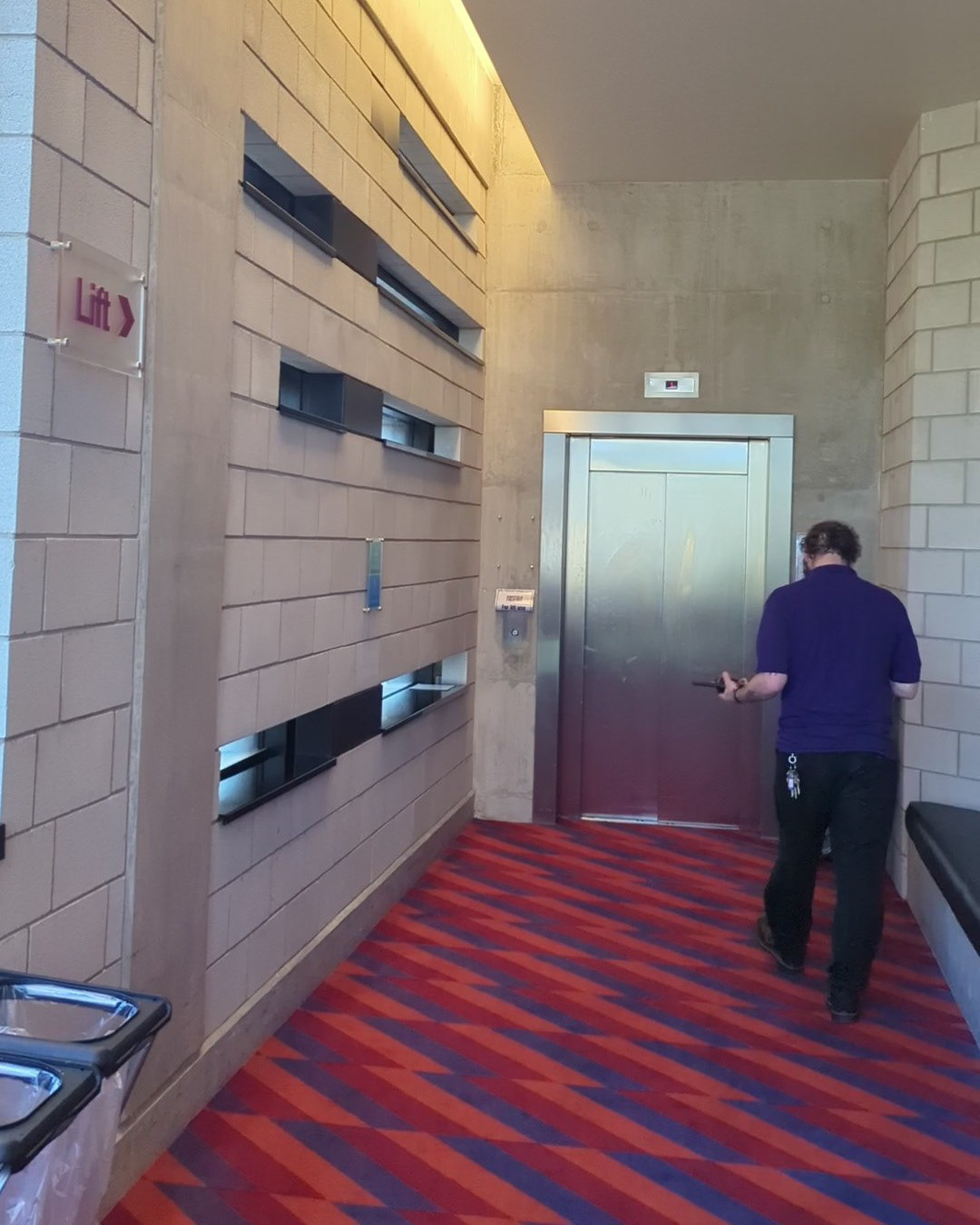
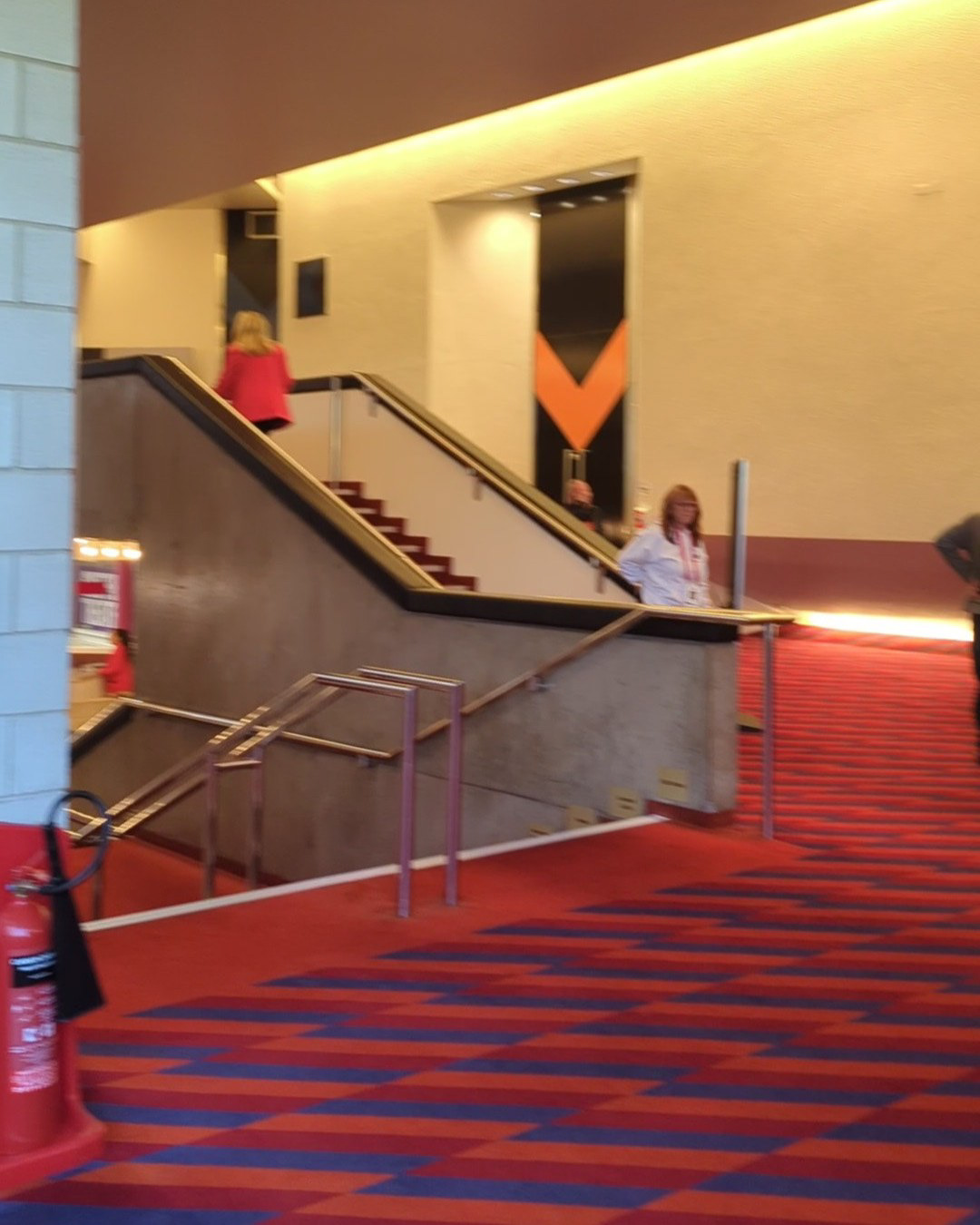
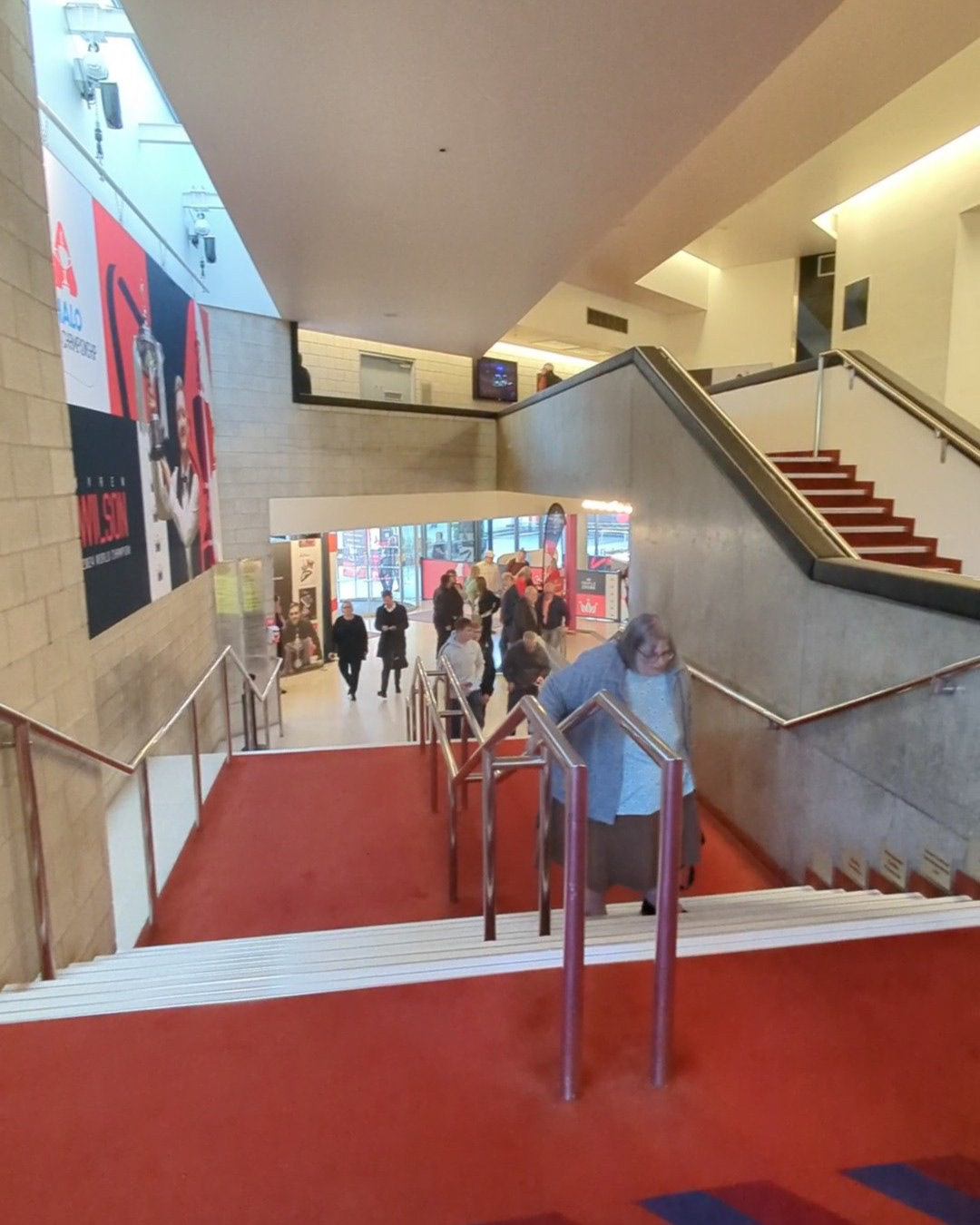
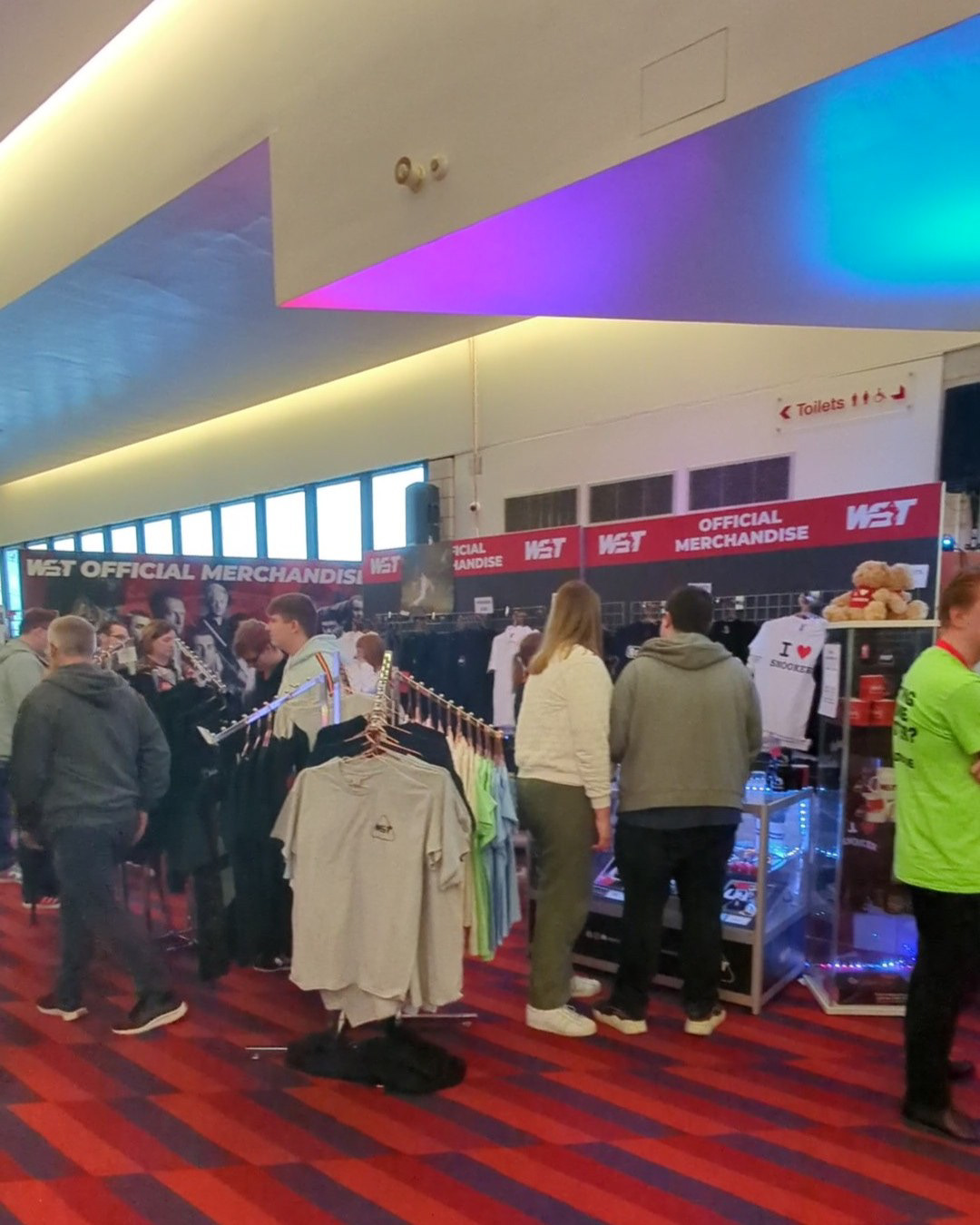
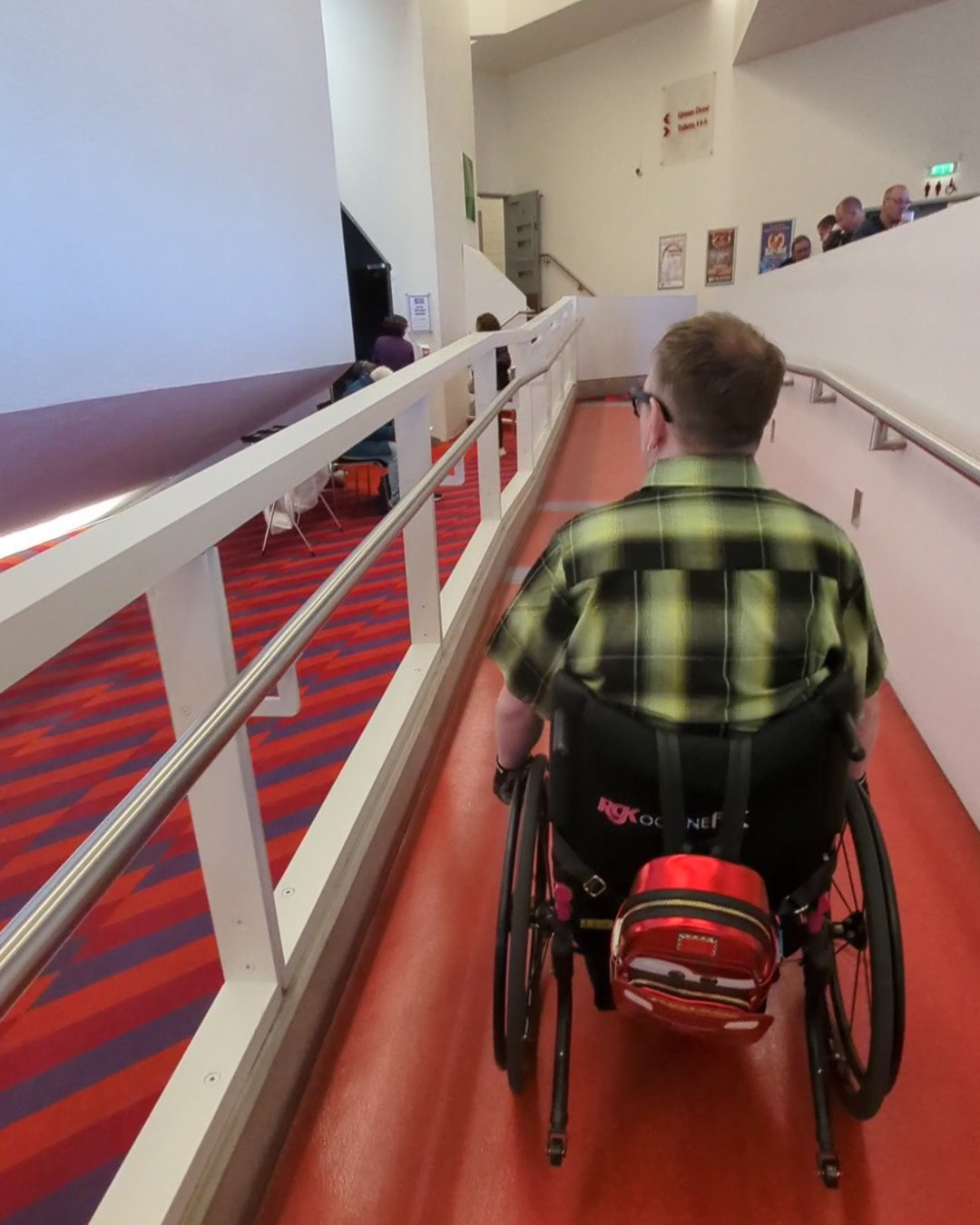
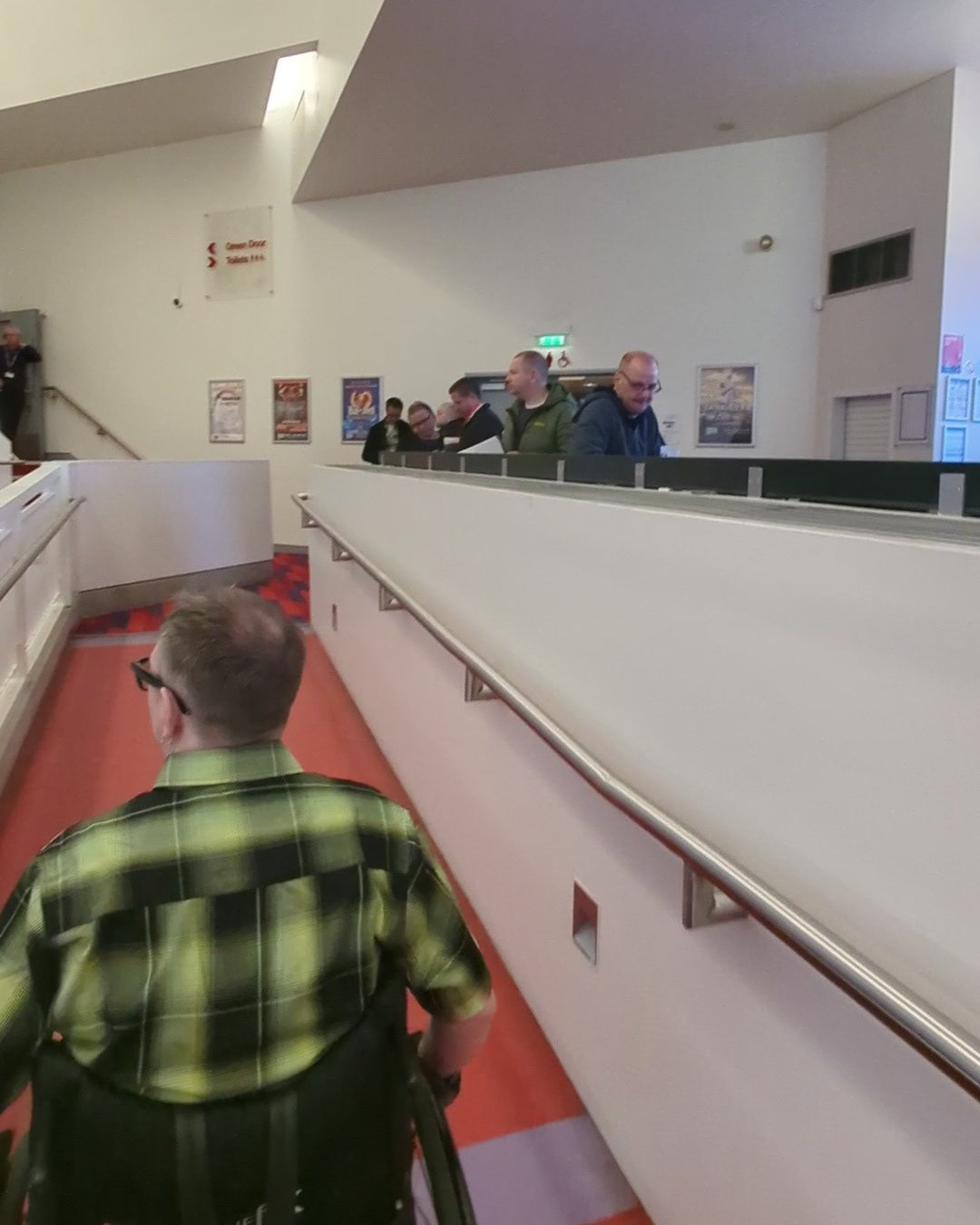
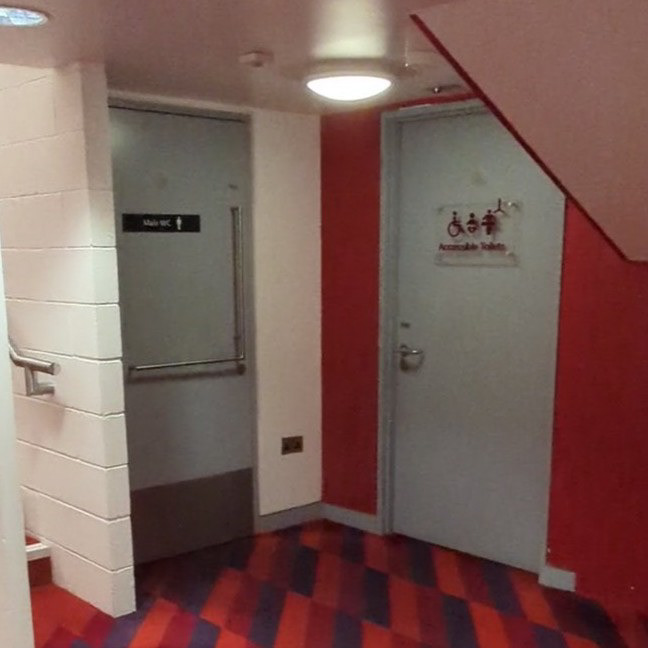
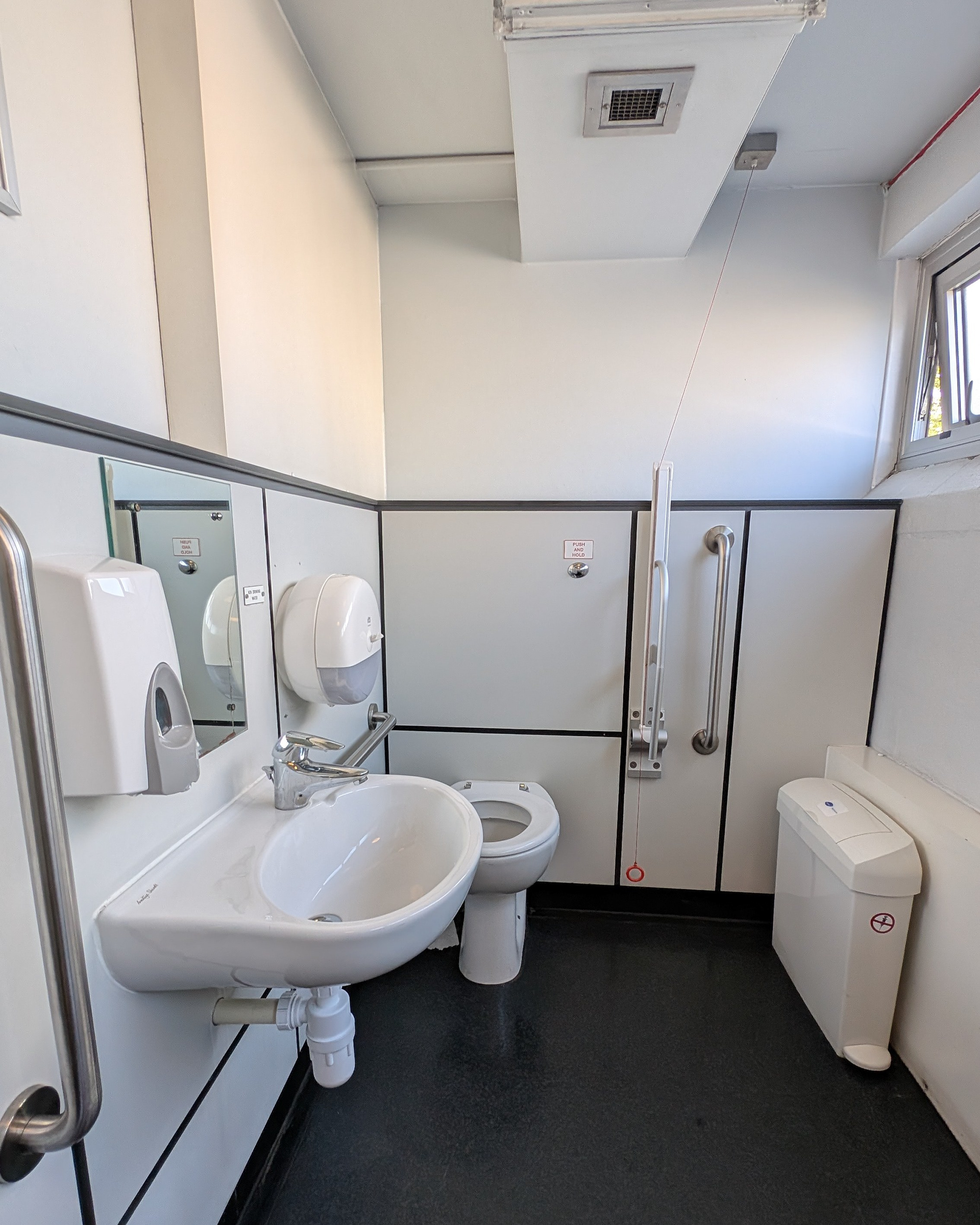






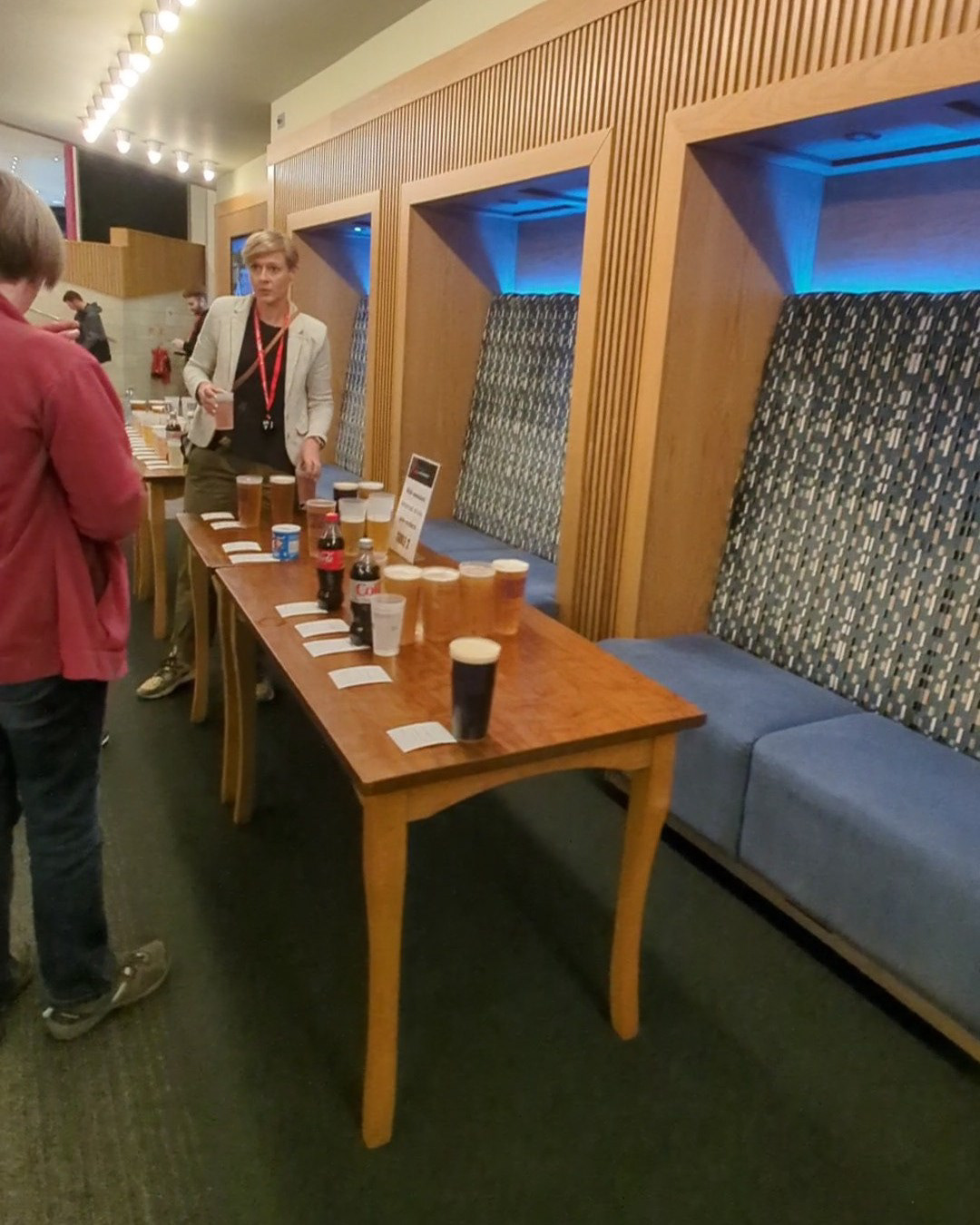
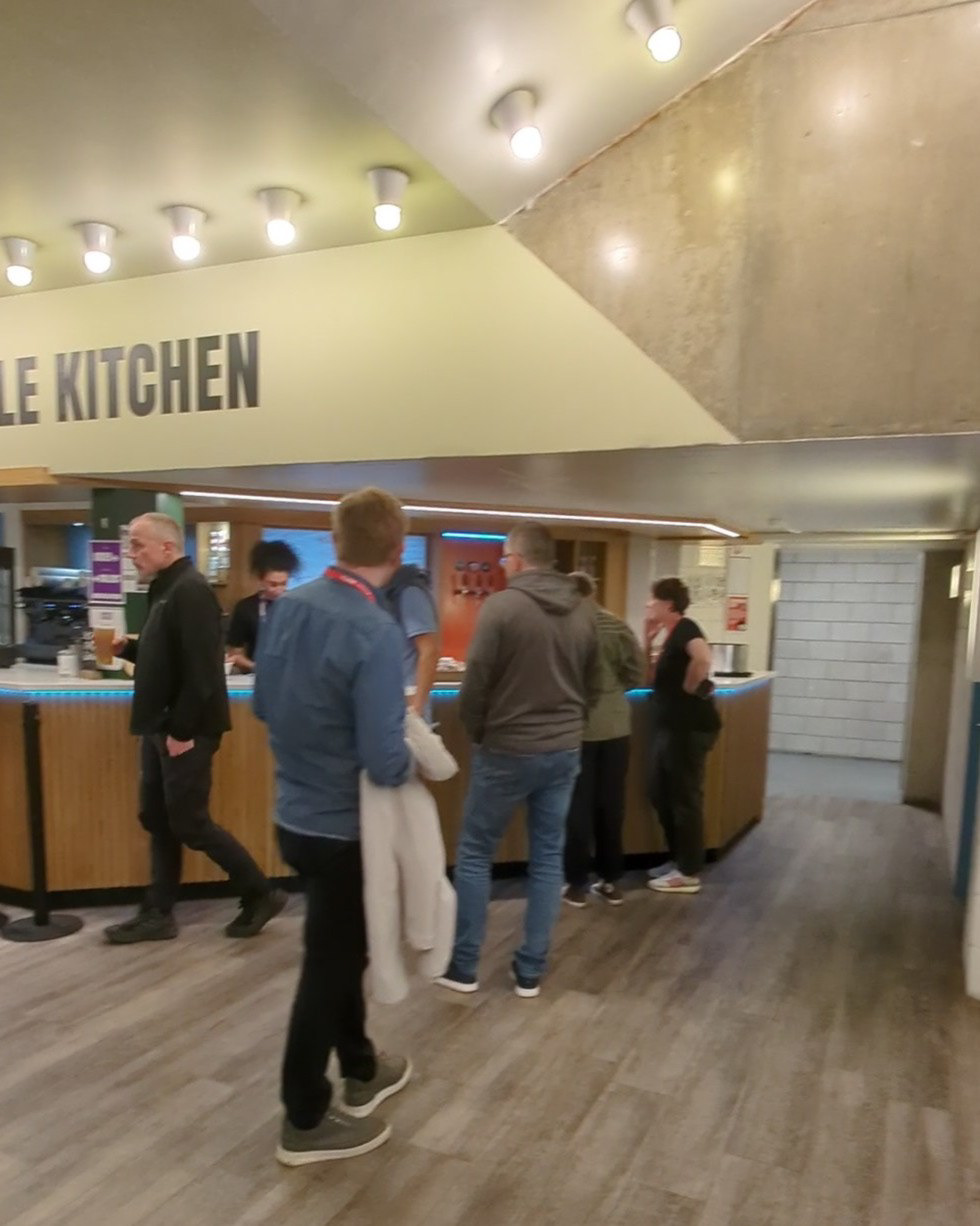

SEATING
Our seating was accessed through the purple door. Two large doors are propped open before and after the event, and during intervals, and there is an additional set of smaller doors into the theatre. My wheelchair space, J22, was immediately inside the door, to the right-hand side of the steps. Although the seat number marker was on the right-hand side of the bay, my wheelchair needed to be positioned to the left so I didn’t block access to the row of seating. There was a metal railing to my left and around in front of me, and the lower section was padded and upholstered to match the seating.
I didn’t expect my companion’s seat to be at the end of the regular row, two steps down from me. For snooker, we wouldn’t be talking to each other anyway, but sitting up there on my own felt strange.
I was a good height above the row of seating in front of me and had a good view down to the tables.
There was a button near the wheelchair space to press for assistance - whether or not this works, I don’t know - but a staff member was always standing at the door, should I need help.
From my wheelchair space, I just had to wheel out of the doors and up the ramp to the accessible toilet. However, if I’d been in any of the other wheelchair spaces, I’d have had to wheel around to the accessible toilet, as there was only one. I suppose it’s swings and roundabouts. I had to wheel from the lift further than people using the Orange or Red doors, but it was a shorter trip than theirs to the toilet.
There is little clarity about the exact number of wheelchair spaces or ambulant disabled options. Despite looking at many different seating plans online, I could not determine exactly where the wheelchair bays are and what the exact seat numbers are. Some plans show wheelchair bays up on Level 3, but I can’t find an event with tickets for sale to confirm this.
I’ve managed to narrow it down to 4 specific wheelchair bays in the theatre:
J22 and J54 are wheelchair bays and have no seats.
J21 and J55 are the companion seats, down two steps from the wheelchair bay.
Seats J20, J19, J56 and J57 can be booked as additional full-priced tickets with the wheelchair bays.
K25 and K42 are wheelchair bays and have no seats.
K26 and K43 are the companion seats, which I assume are next to the wheelchair bay.
Seats K27, K38, K44, and K45 can be booked as additional full-price tickets with the wheelchair bays.
Seats P67-77 show on some seating plans as wheelchair bays and companion seats (not confirmed)
Row K is step-free and likely suitable for ambulant disabled customers, but again, no confirmation on this.
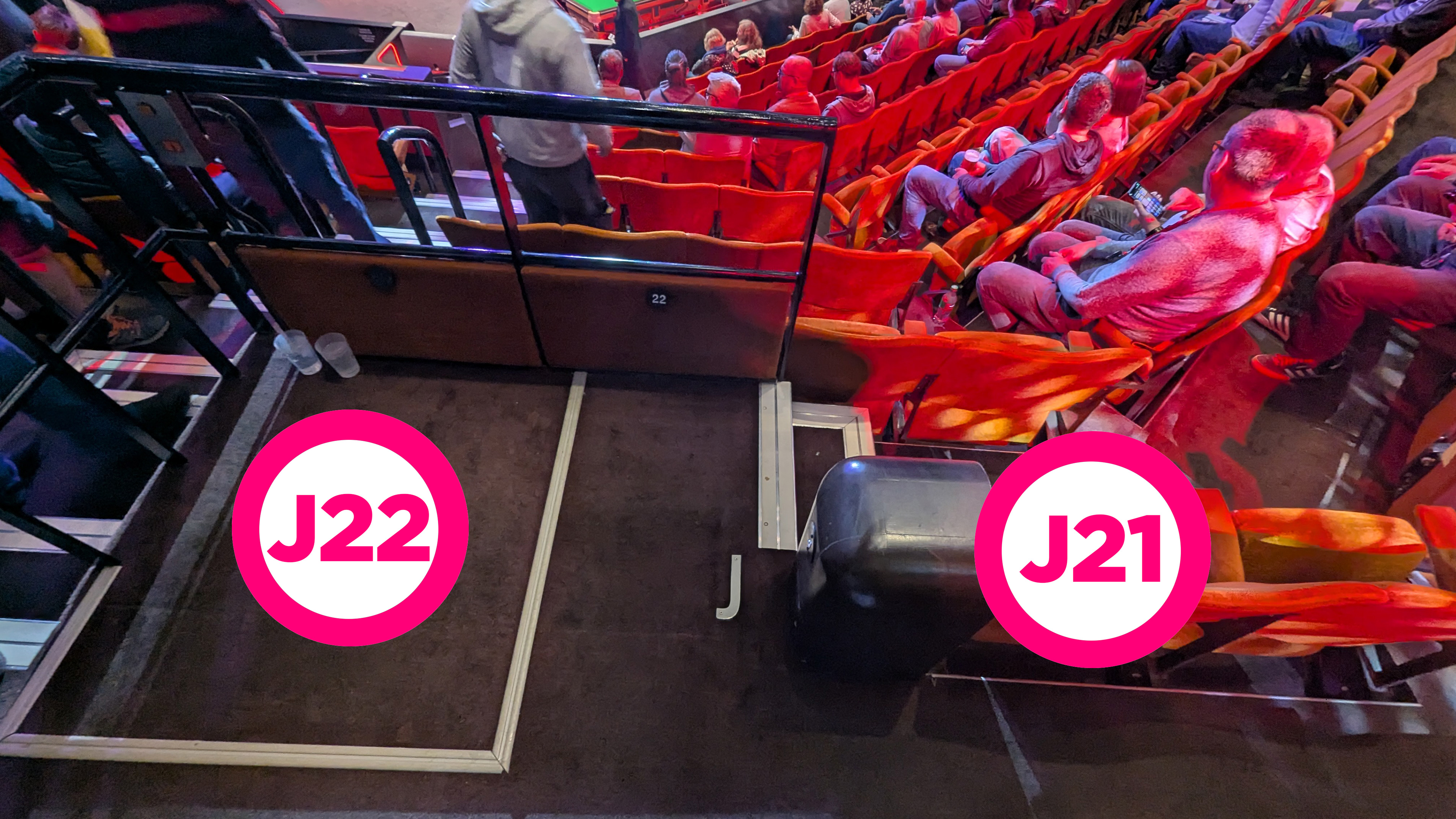
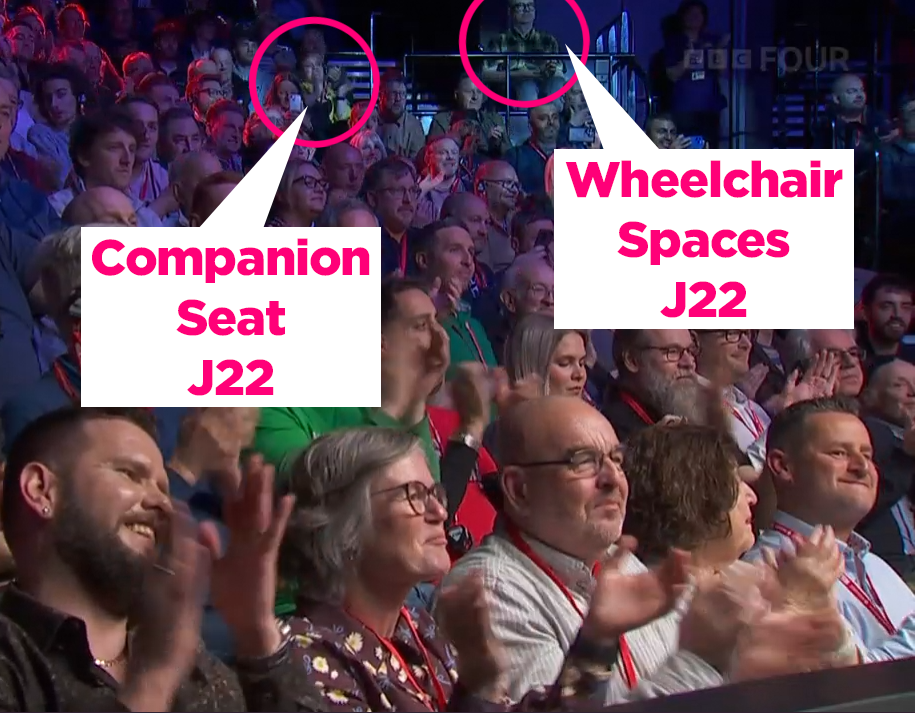
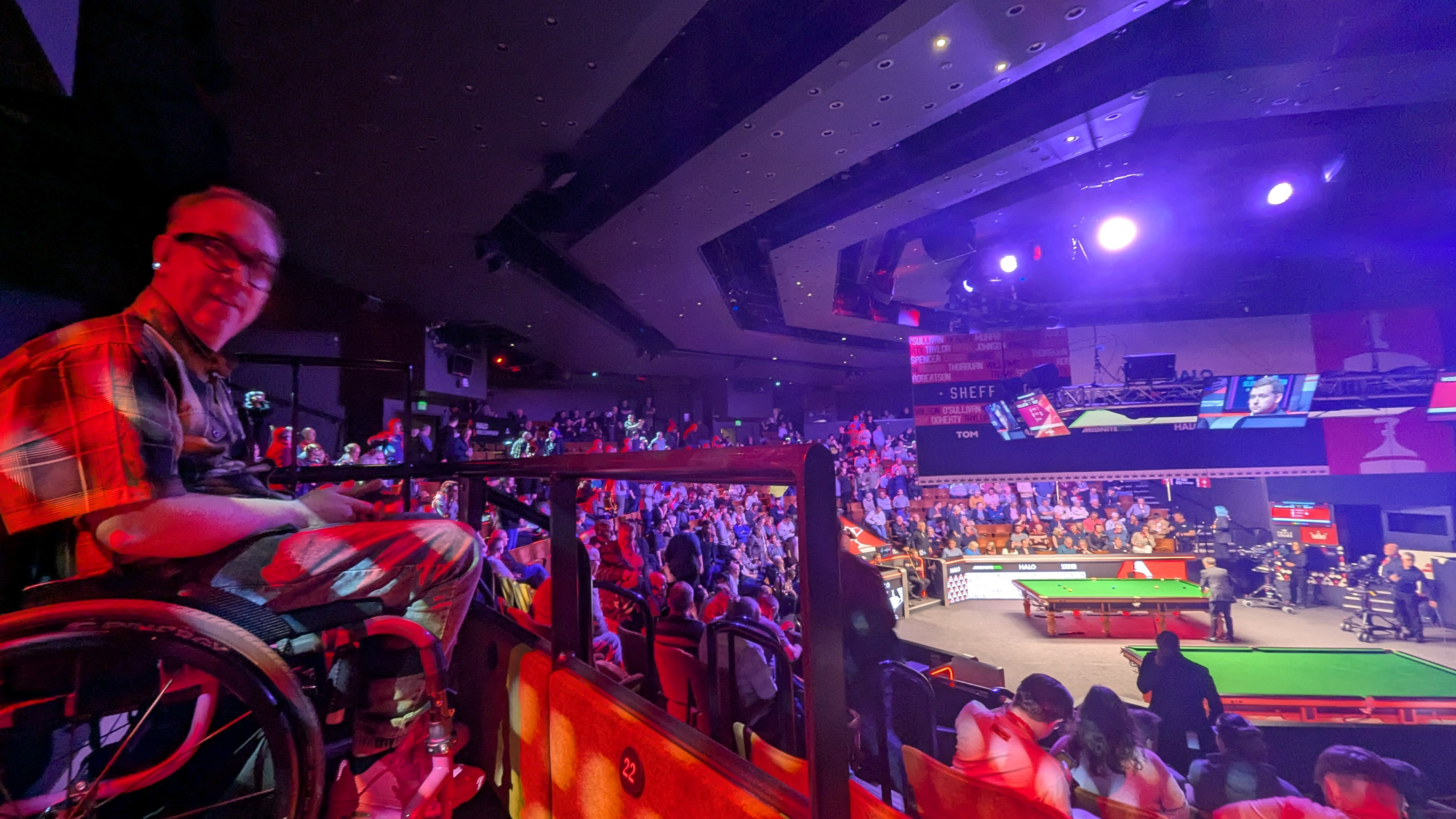
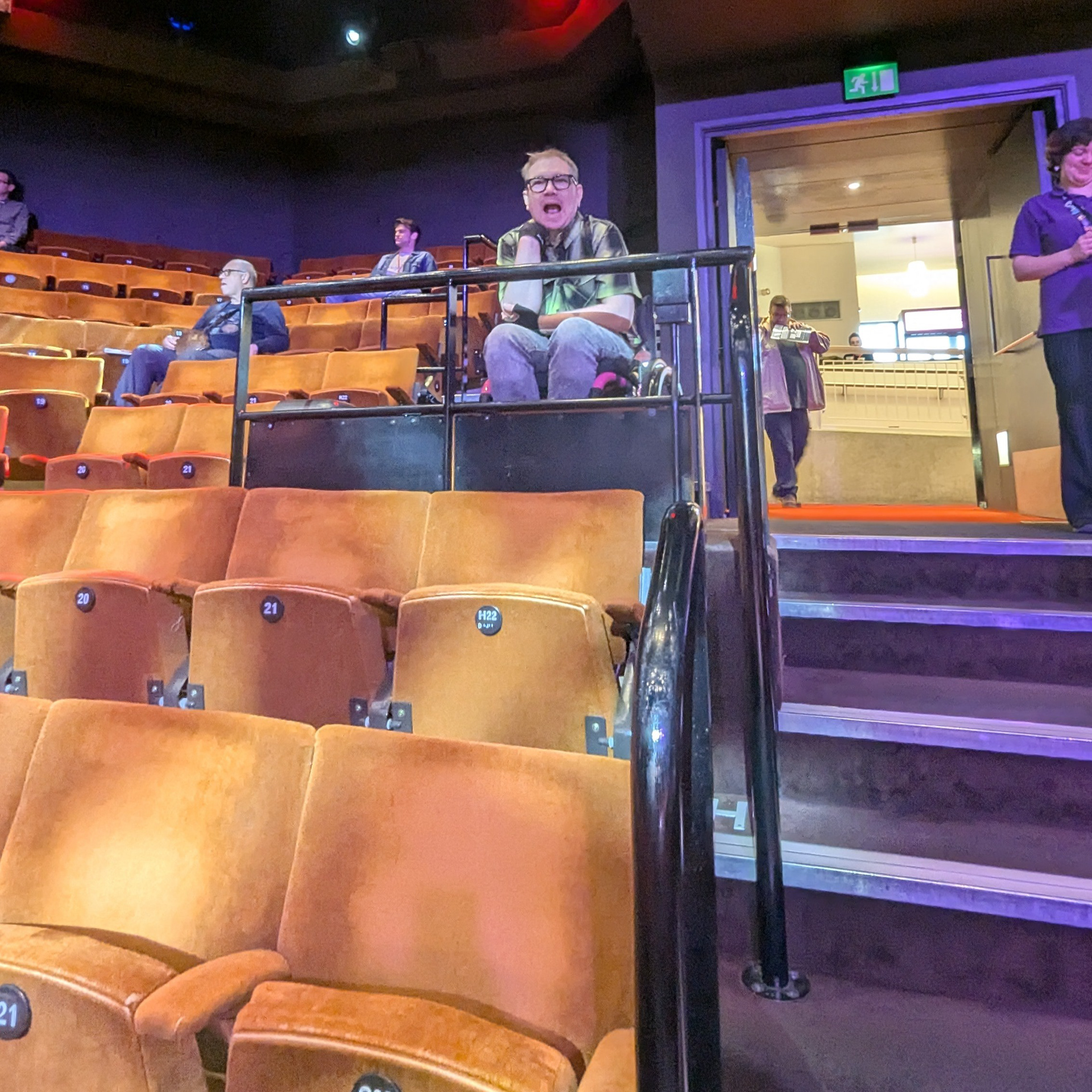

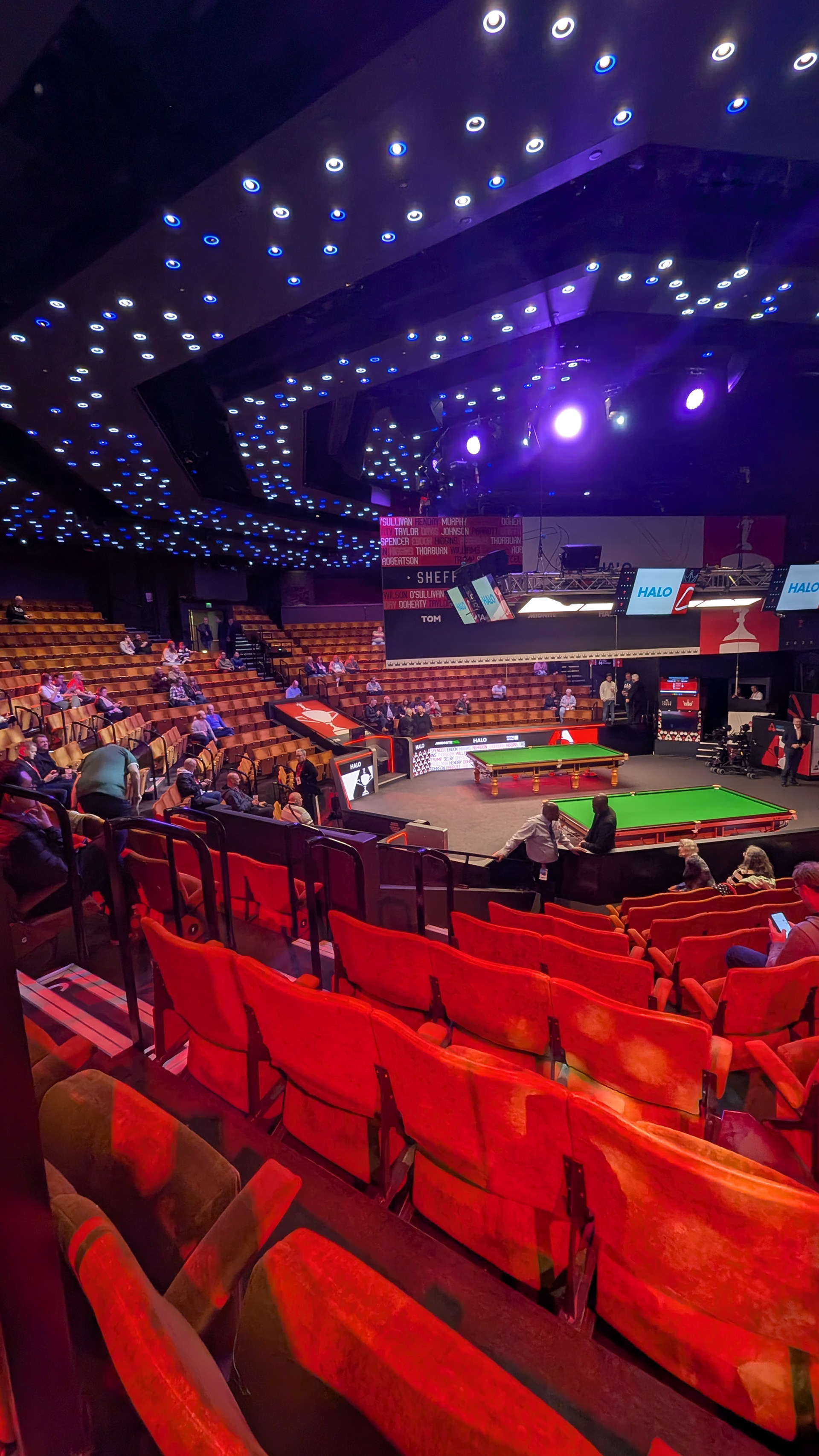
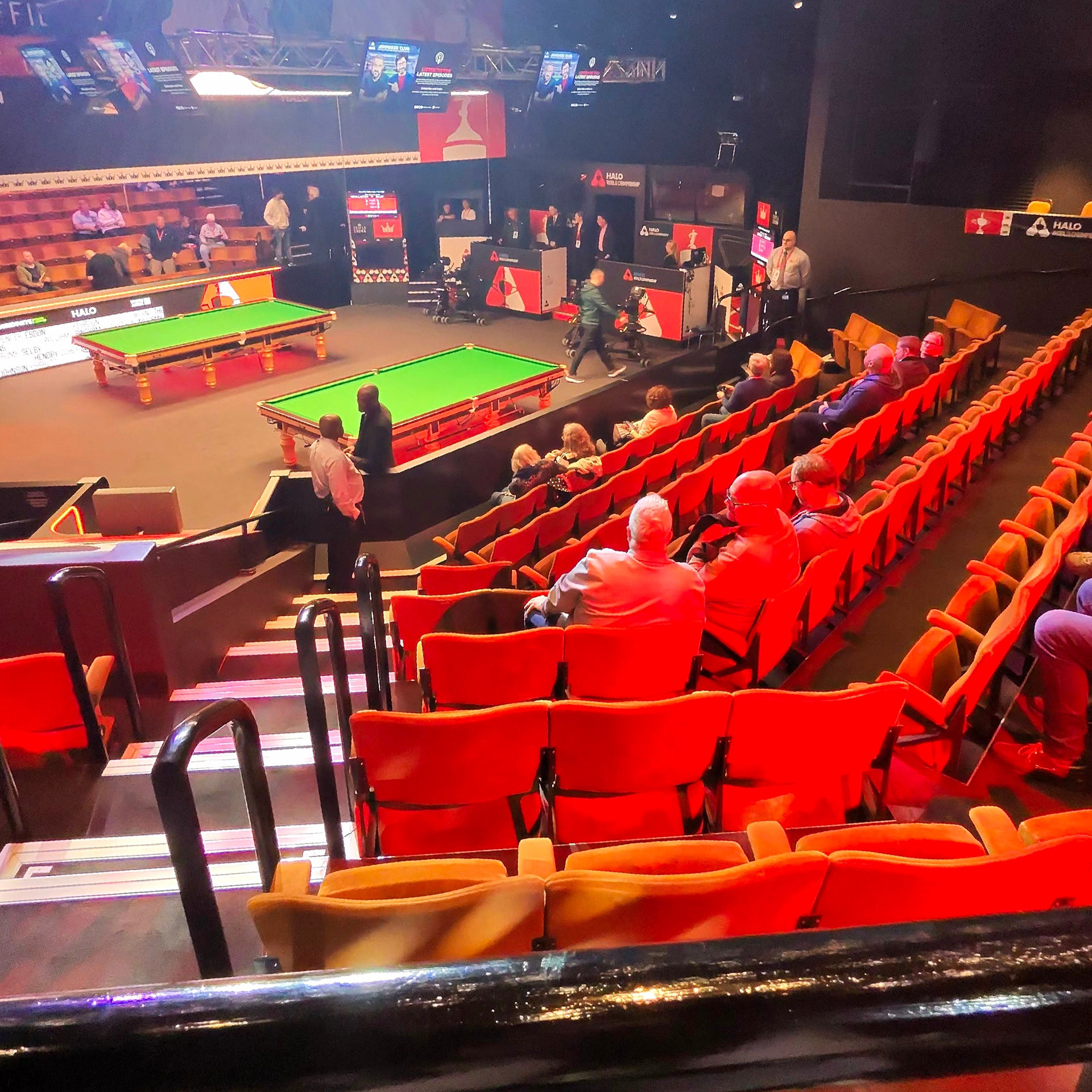
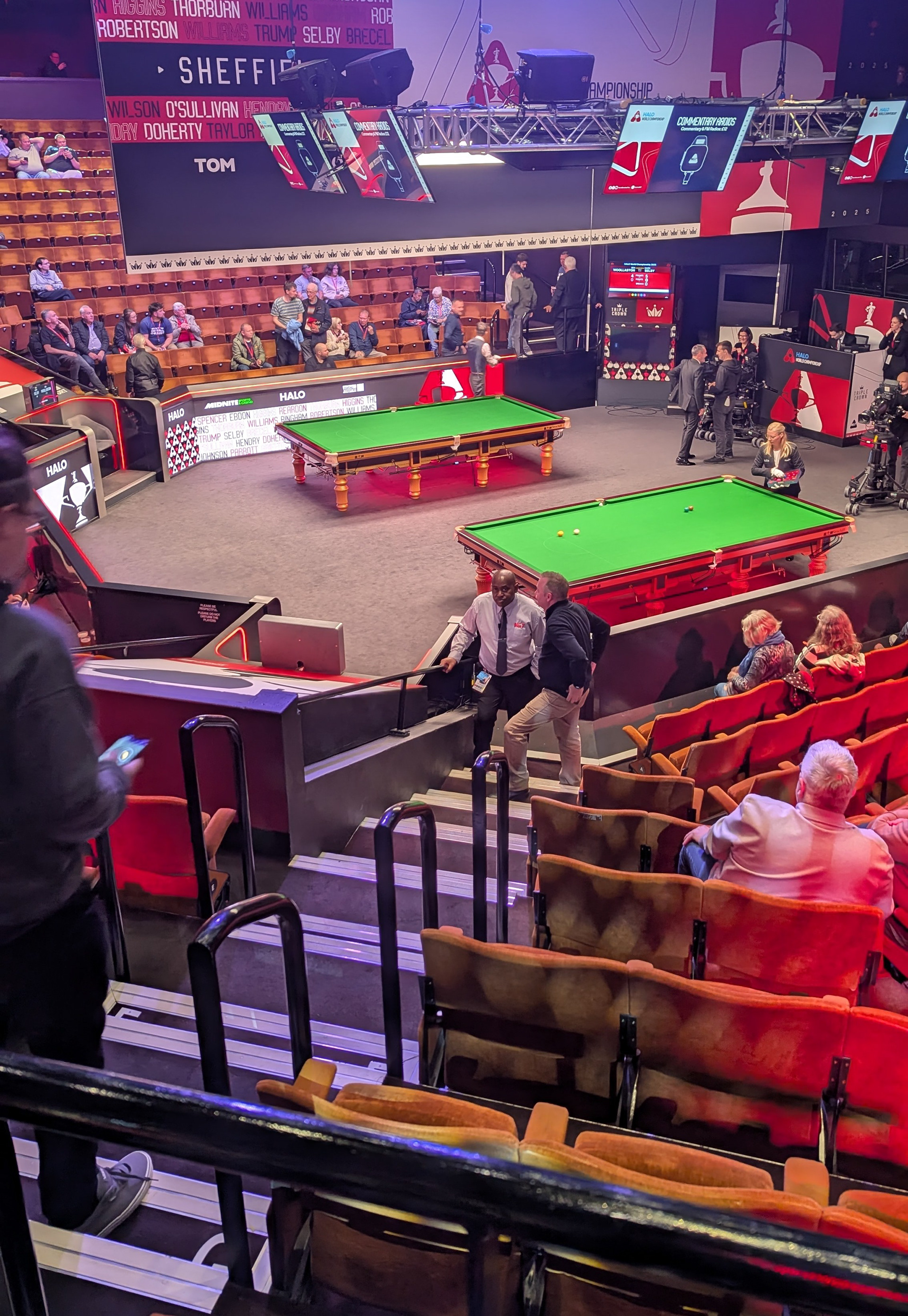

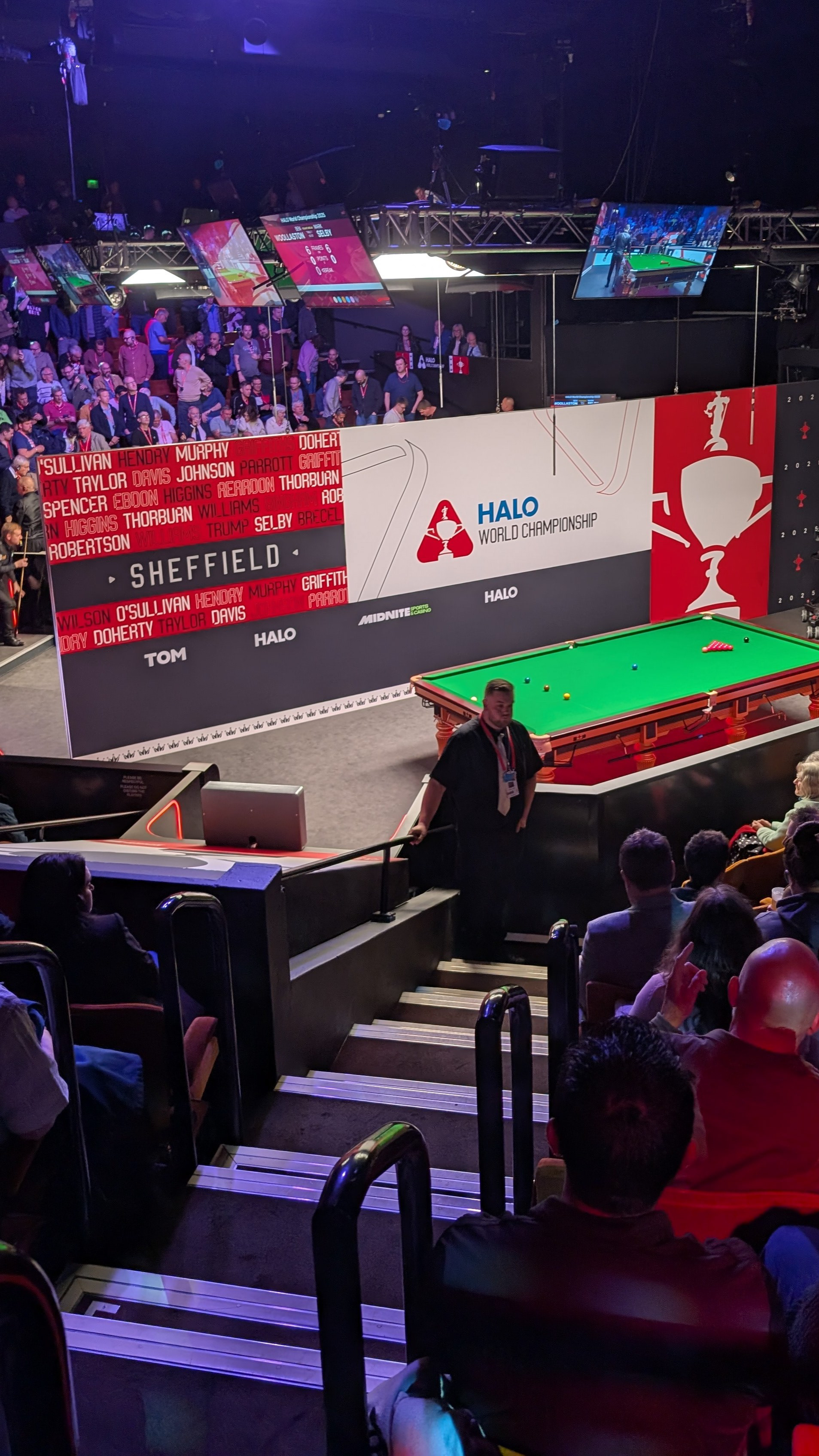


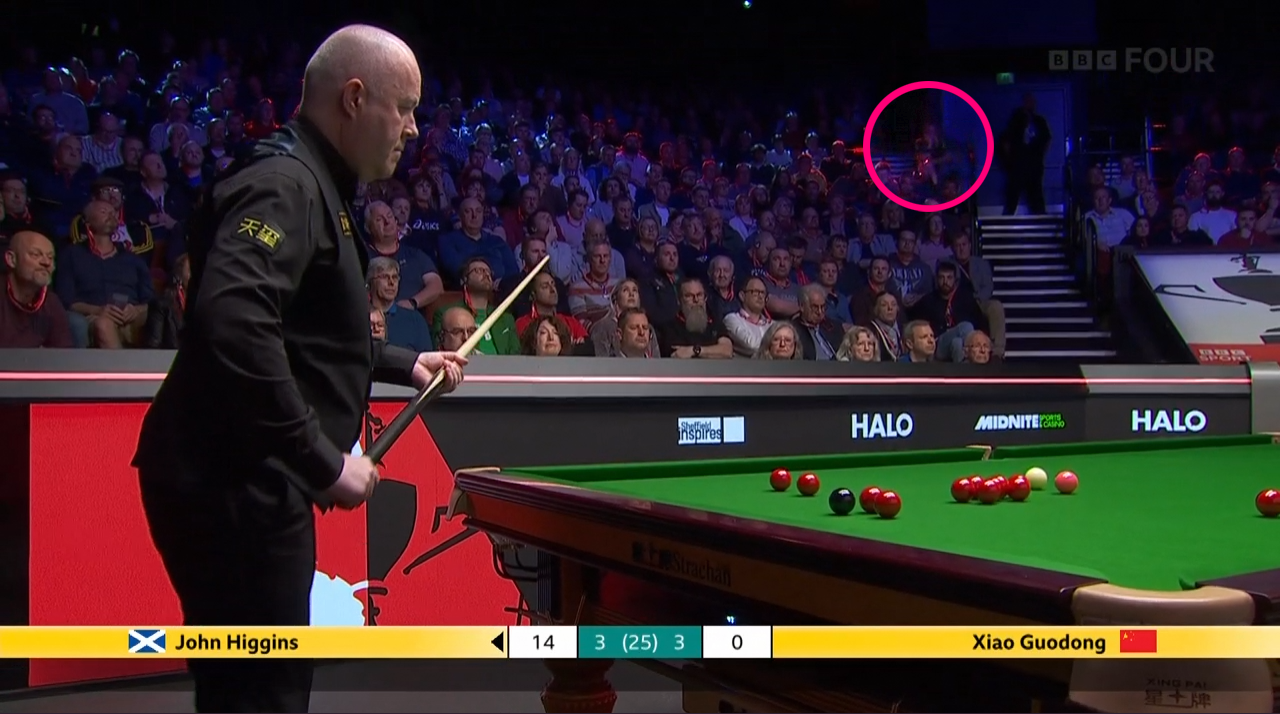

GETTING BACK OUT
Two games were running simultaneously. When one table had finished and a suitable break in play was reached on the other, the central dividing screen was lifted. If you wanted to stay and watch the rest of the play on the other table, you could. On the evening we were there, a lot of the audience left early as the play on the second table went on until gone midnight, so many people had to leave to get transport home. We had no problem getting out when the play finished, as only a third (maybe less?) of the capacity was likely still in the theatre.
What I did encounter, however, was trouble getting out at the interval. With a large section of the seating being served by the purple door, many people were heading to the same place for the short interval. People were coming up the stairs in front of me and down the stairs behind me, and they wanted to be out of Row J next to me. With everyone huddled in the doorway, it was difficult for me to spin around and make my way to the door. I was in the way, but couldn’t really get out of the way. Once so many people had got through the door, the staff member on the door made a way through for me to get out.
If this had happened at the end, it probably wouldn’t have mattered, as I’d be in no rush, but it was frustrating when I wanted to get out, use the toilet, and get a drink. At a glance, it seemed that people thought that I wasn’t moving because I was seated.
As with the way in, staff operated the lift to get us back down to ground level and the main entrance so we could head back out into the fresh night air - or should I say early morning? I also noted that there was a padded bench next to the lift where you could sit and wait if you were less mobile.
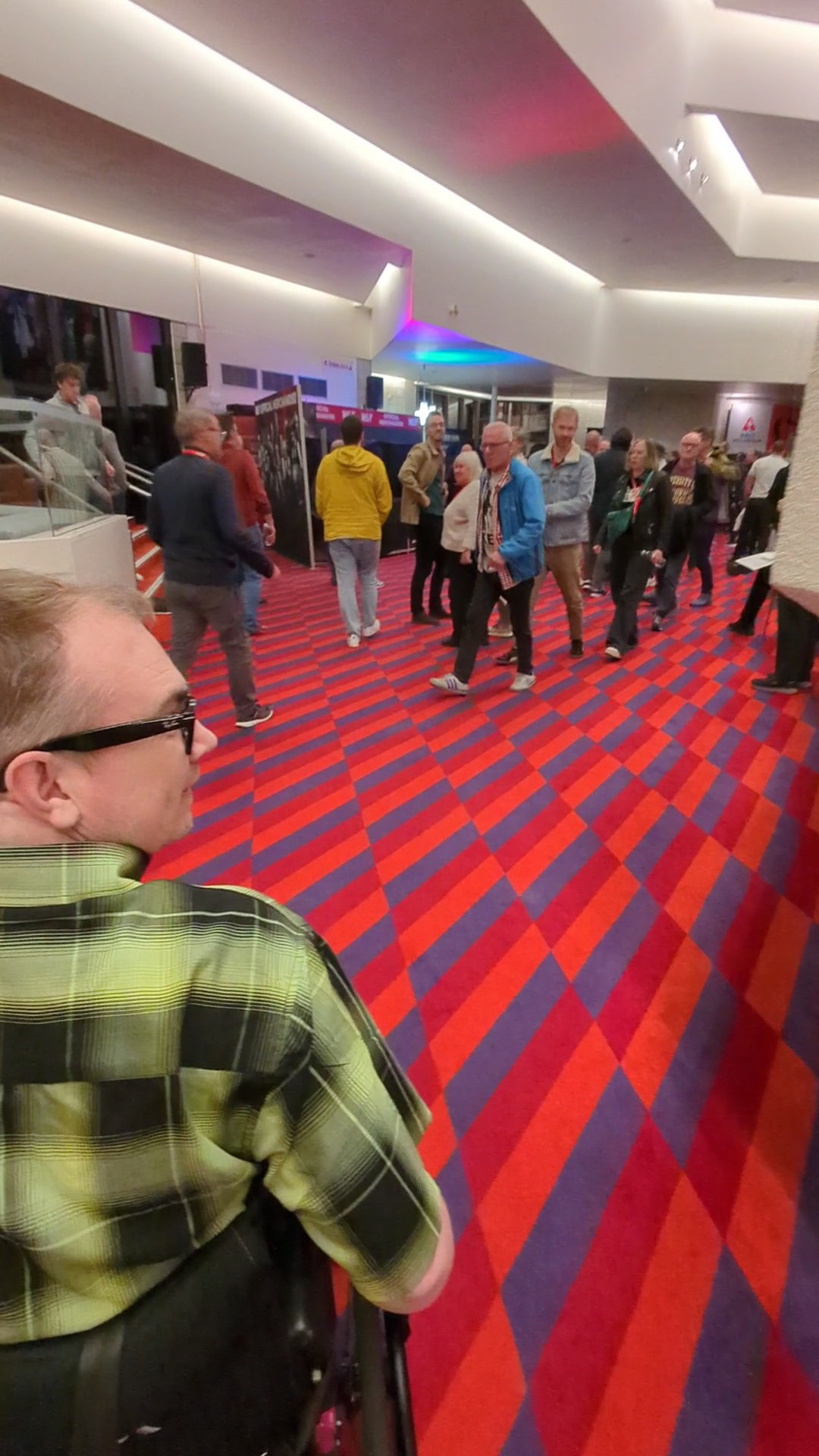
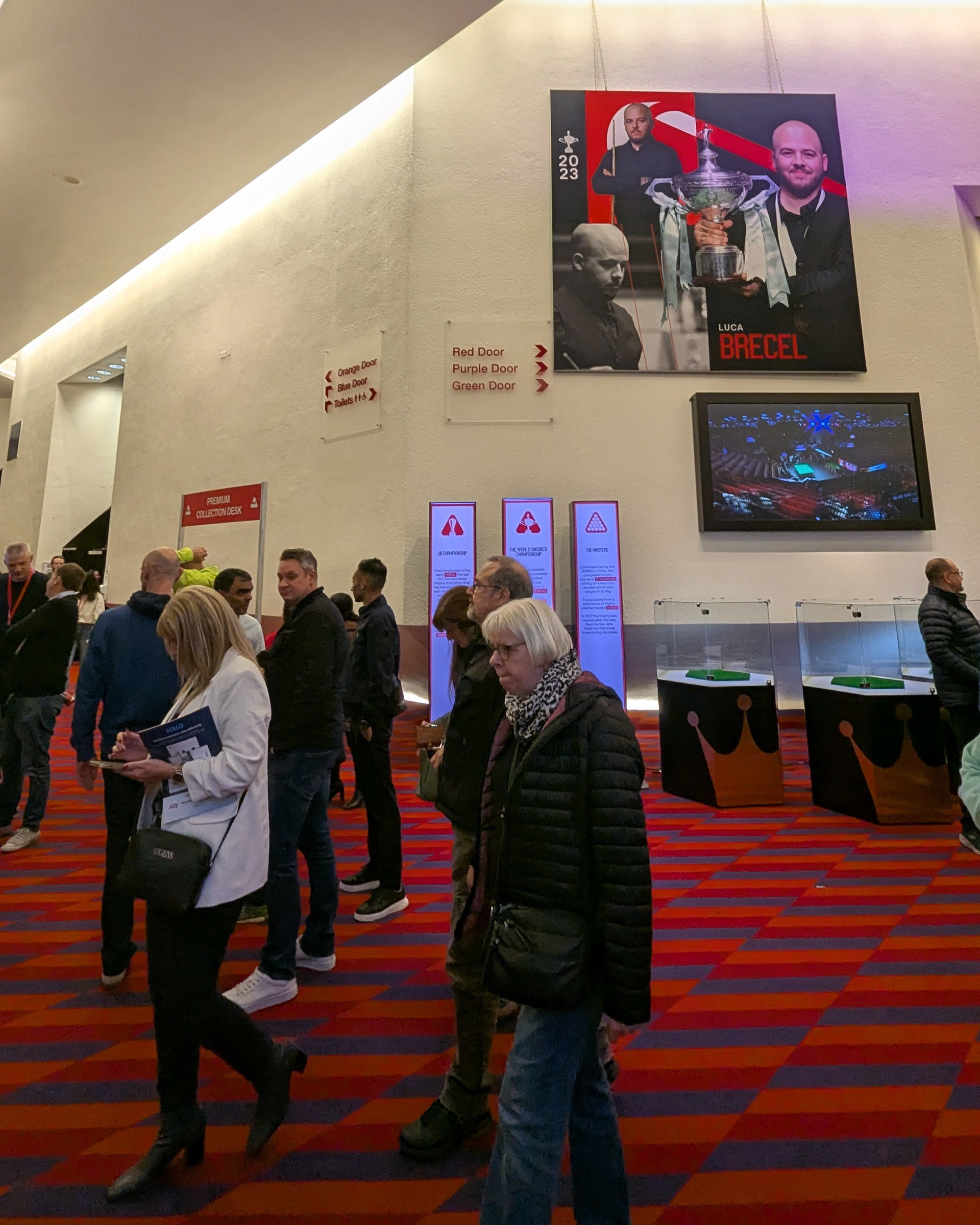

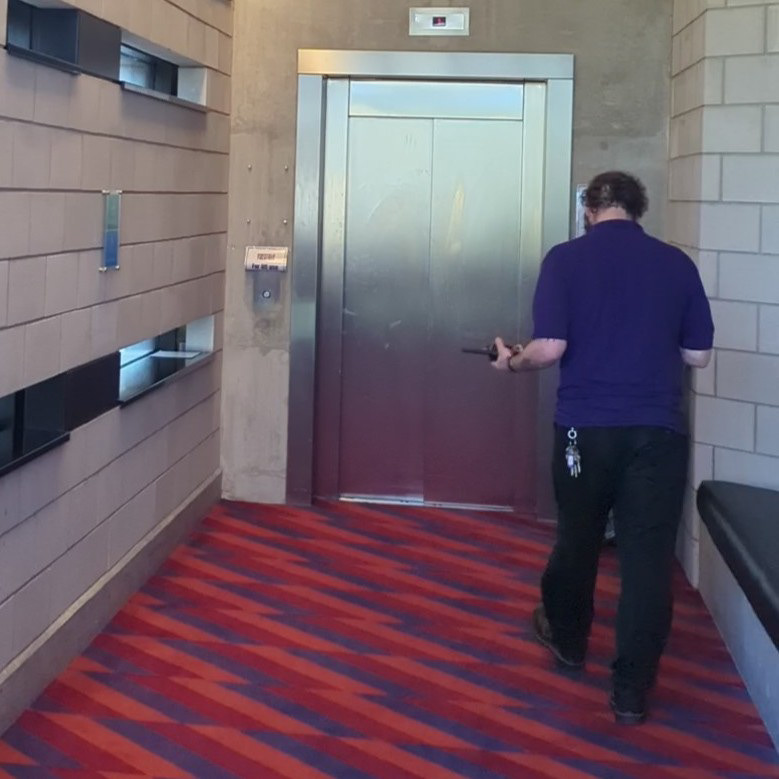
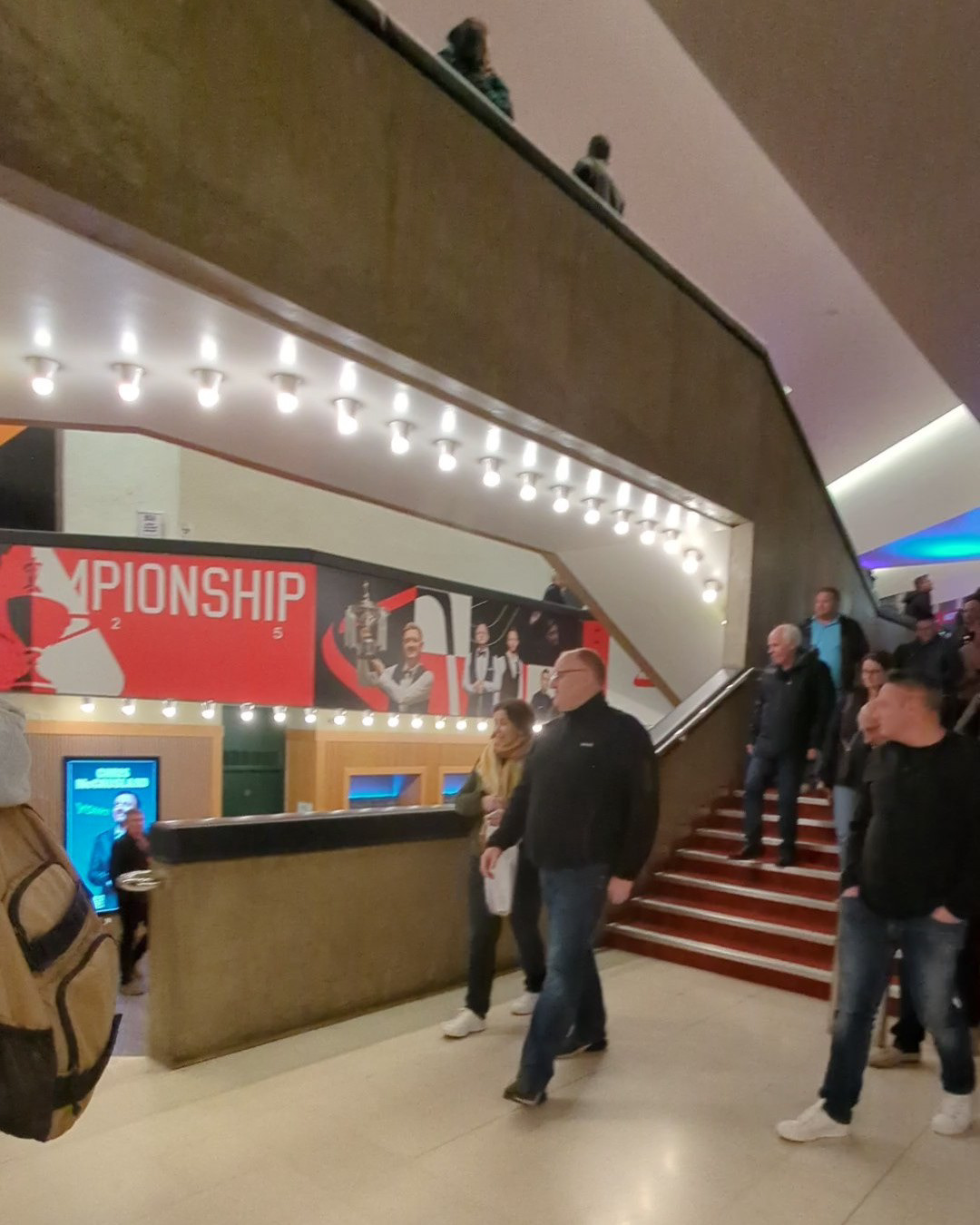
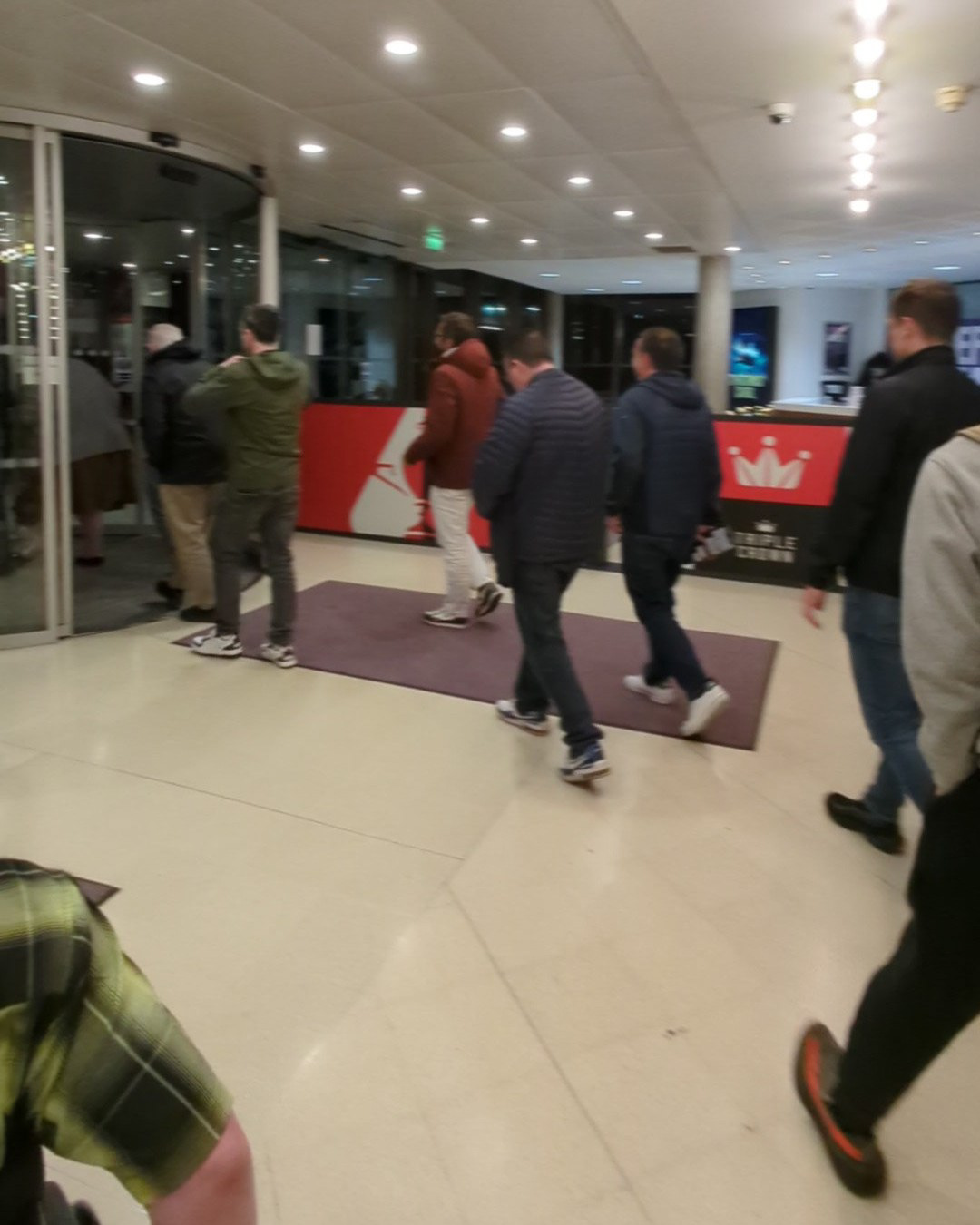
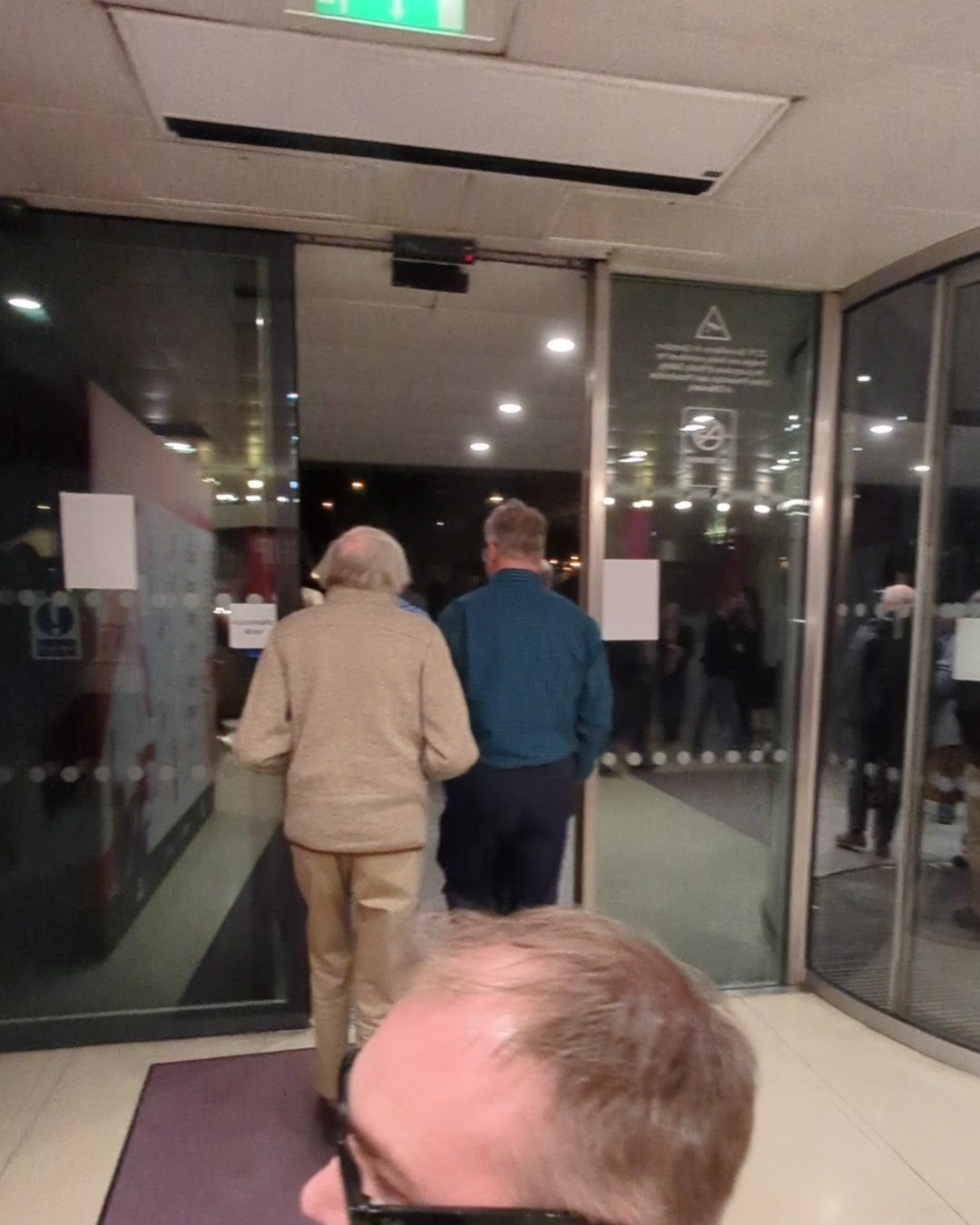
OVERALL EXPERIENCE
For an old building, the access is pretty good.
It was strange that the two of us weren’t sitting together.
The accessible toilet placement was awkward, with the men’s toilet door opening outwards and men queuing.
The staff were all very friendly and helpful.


